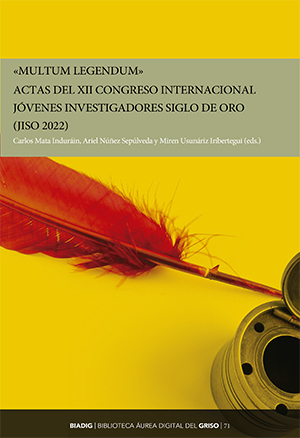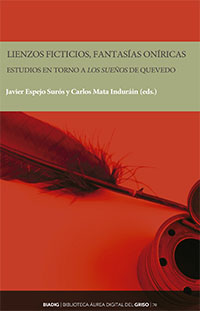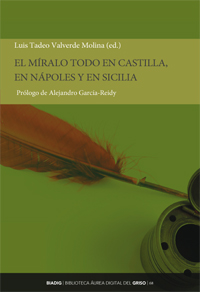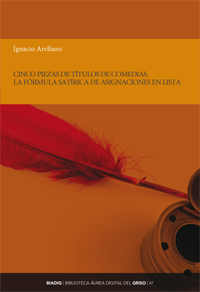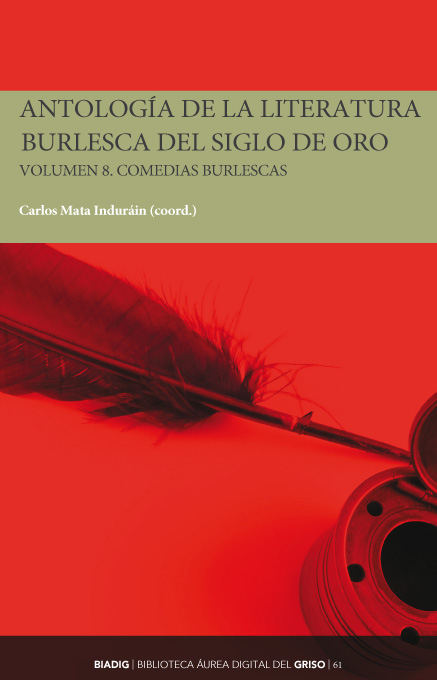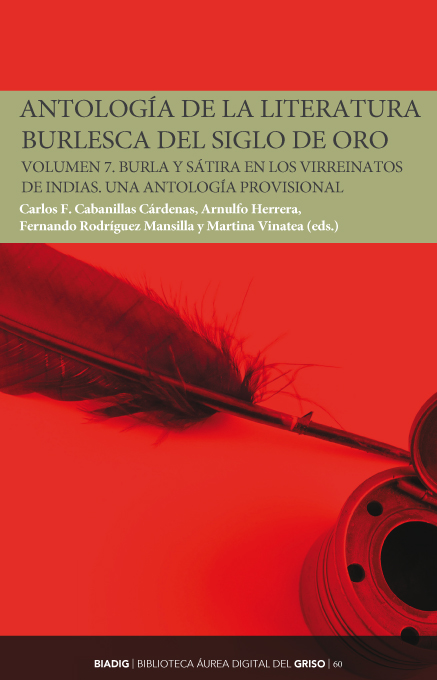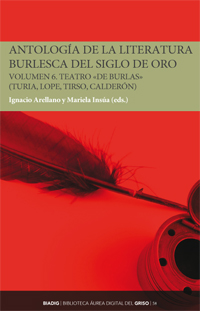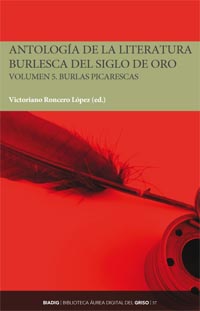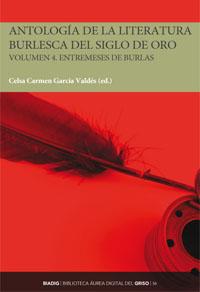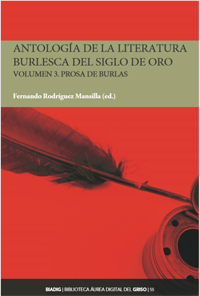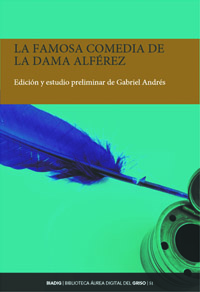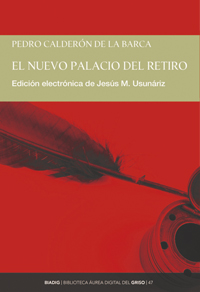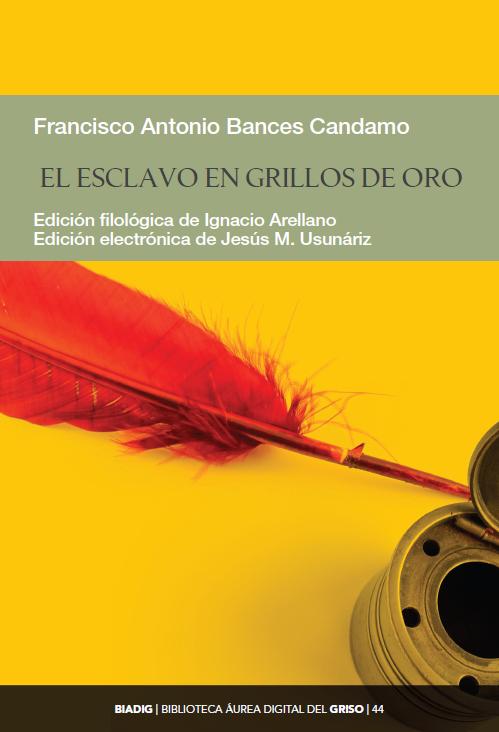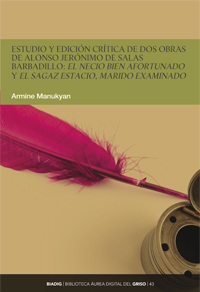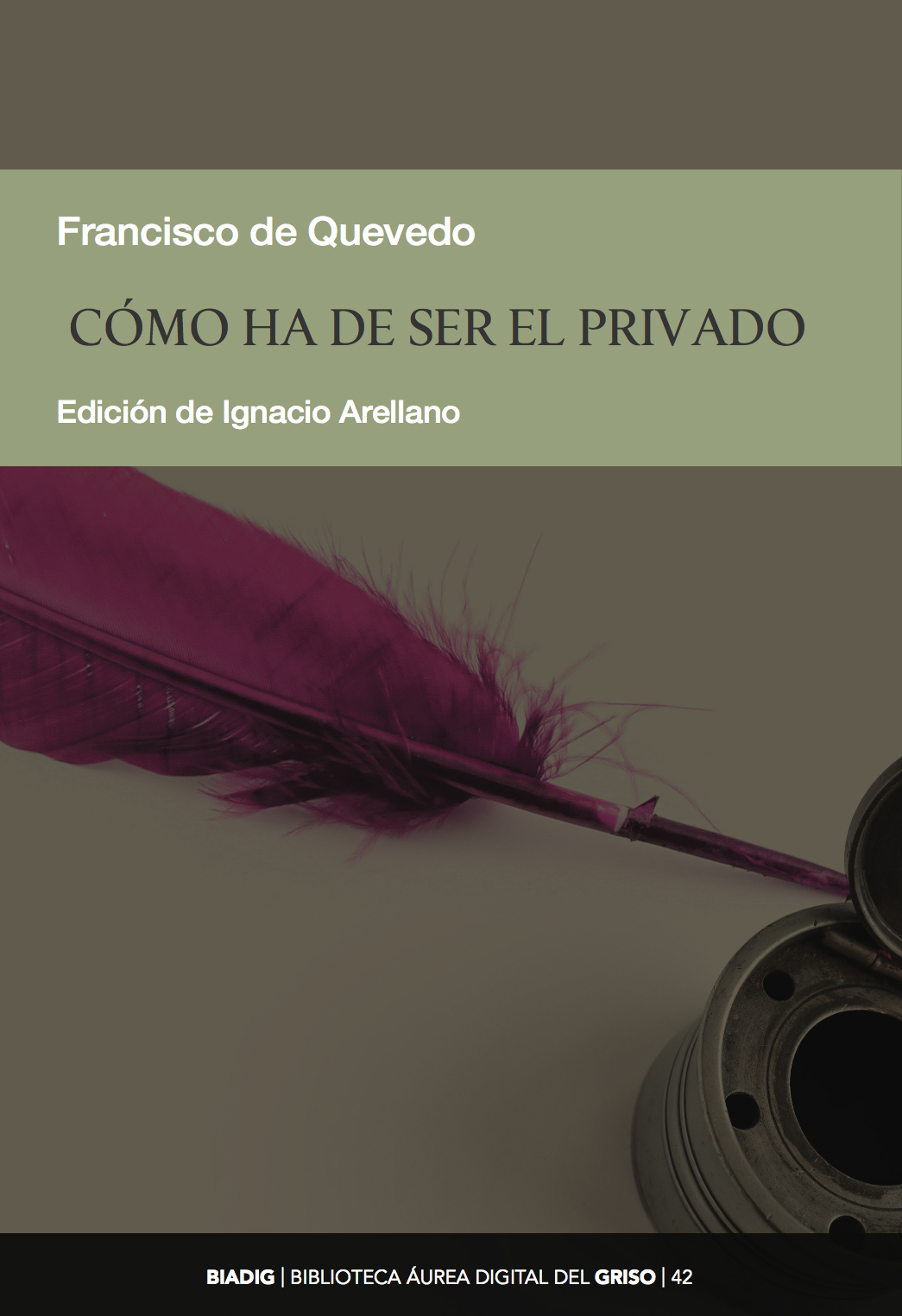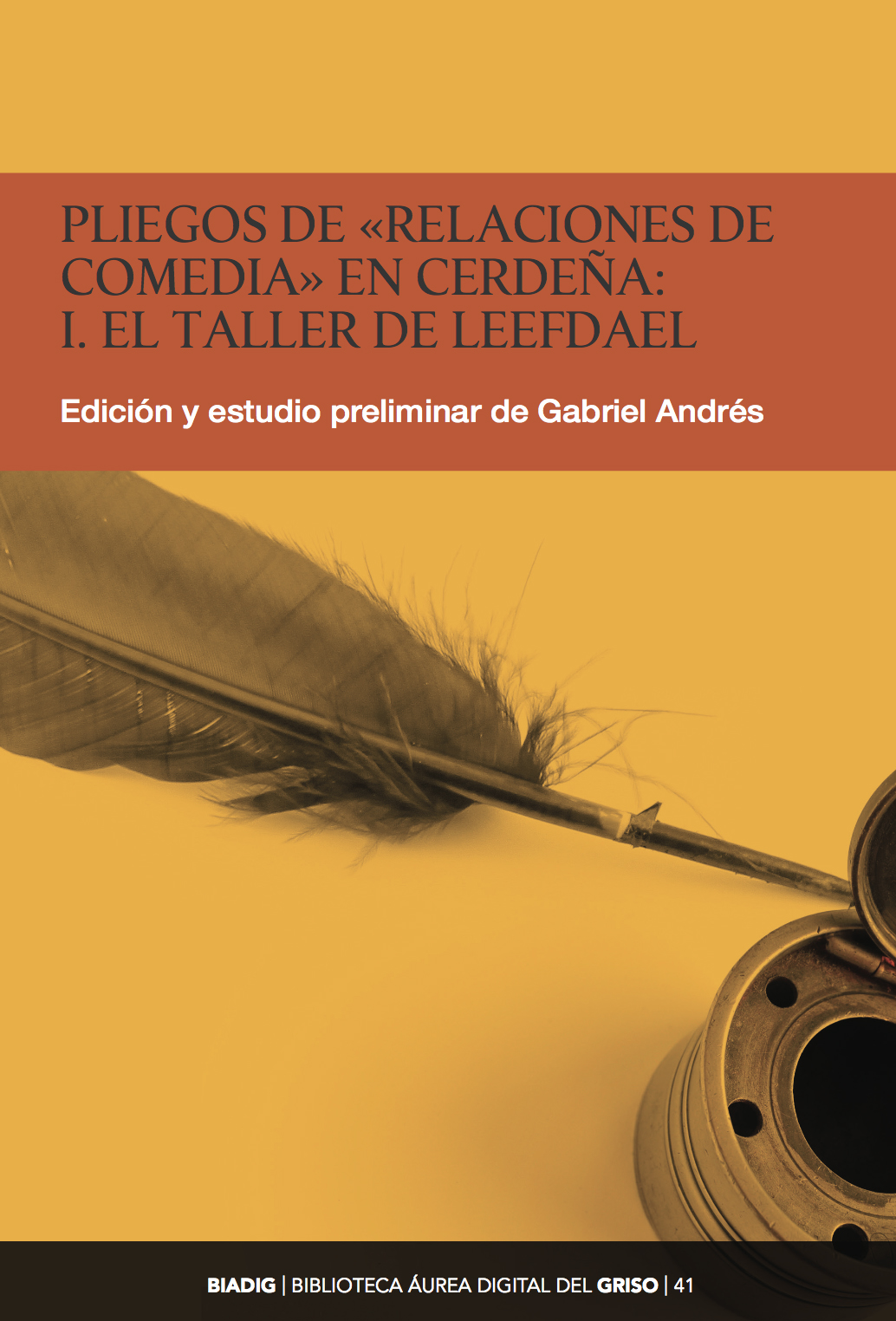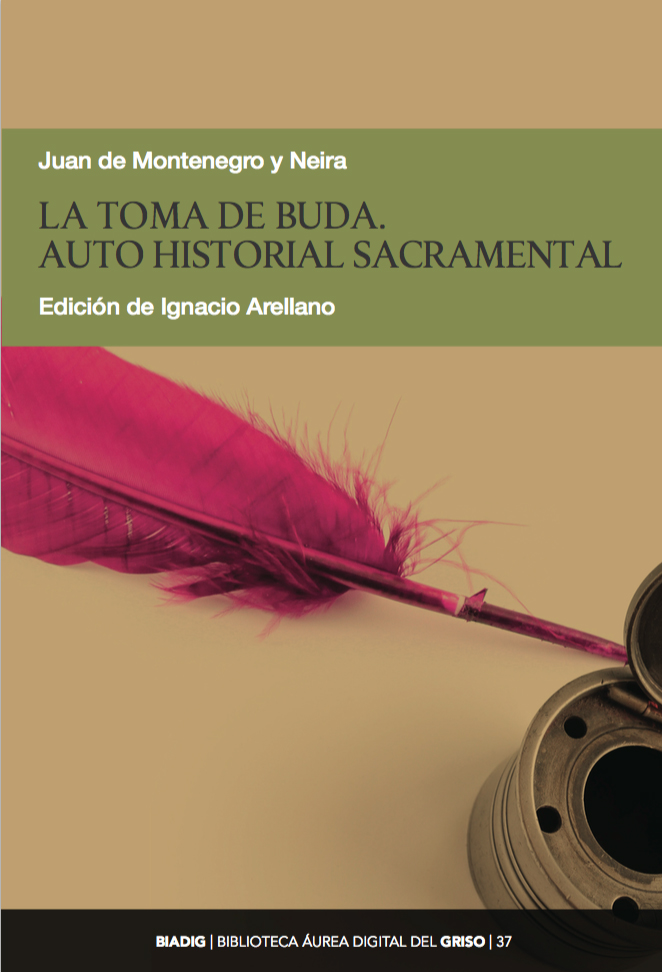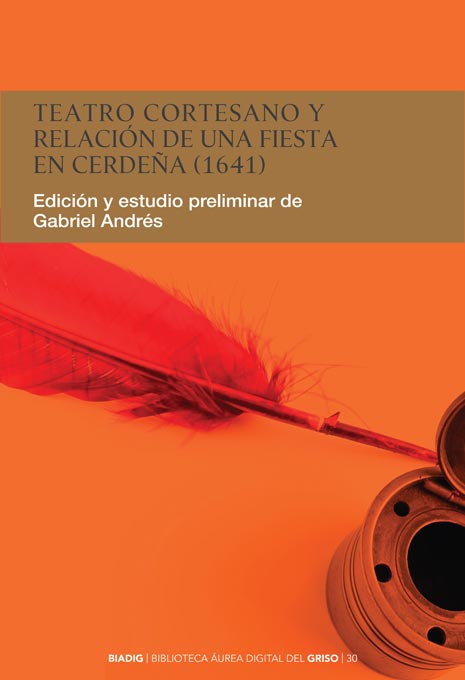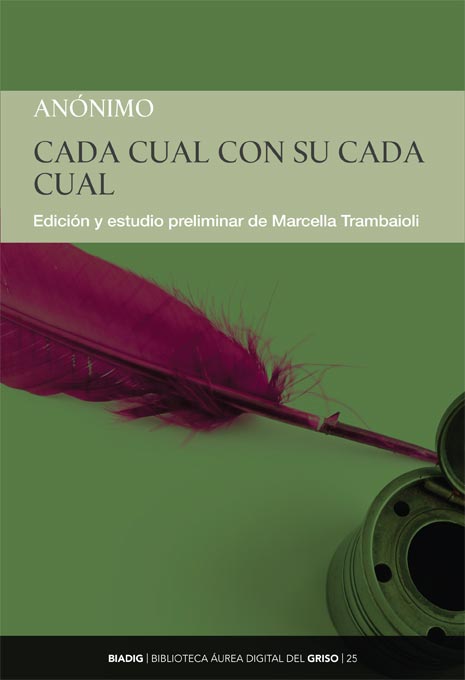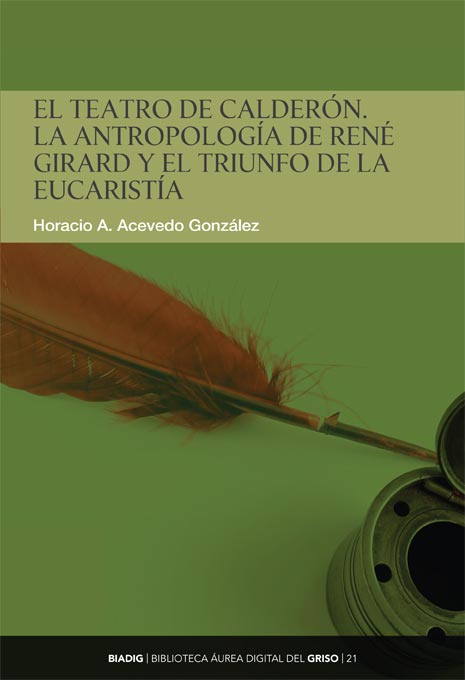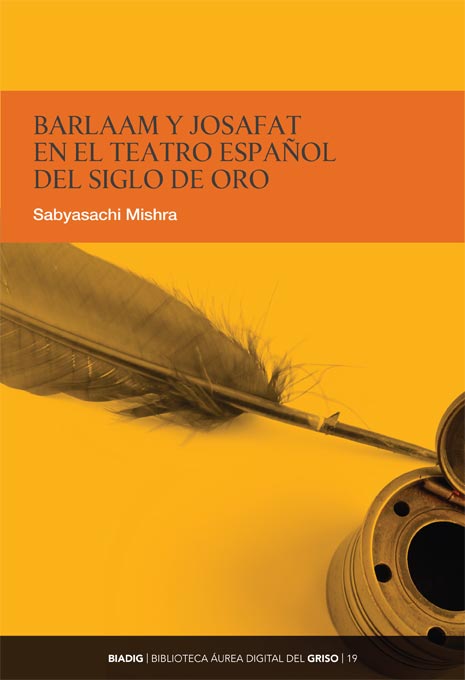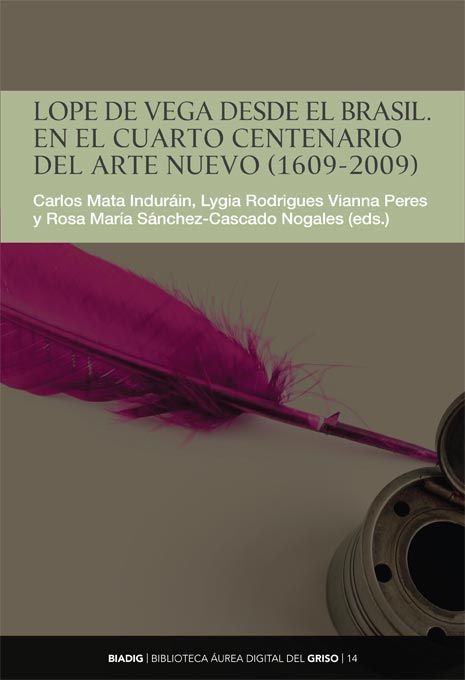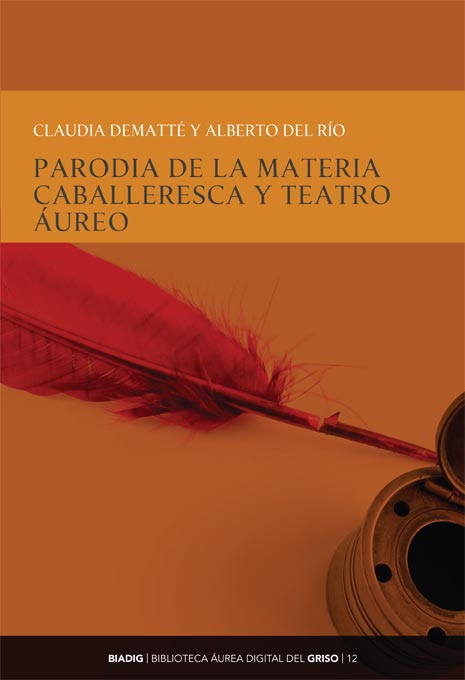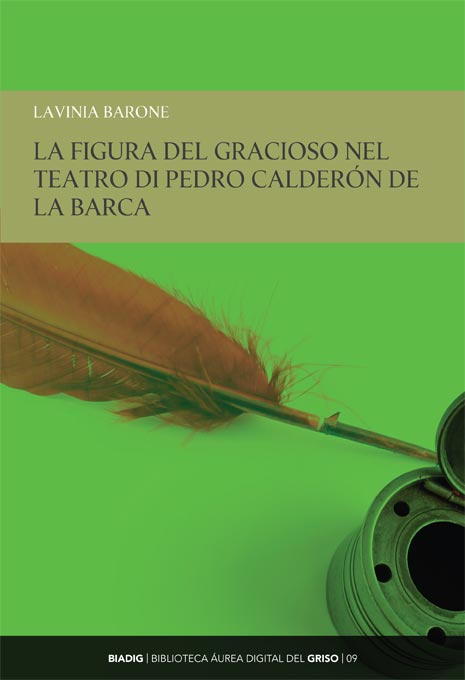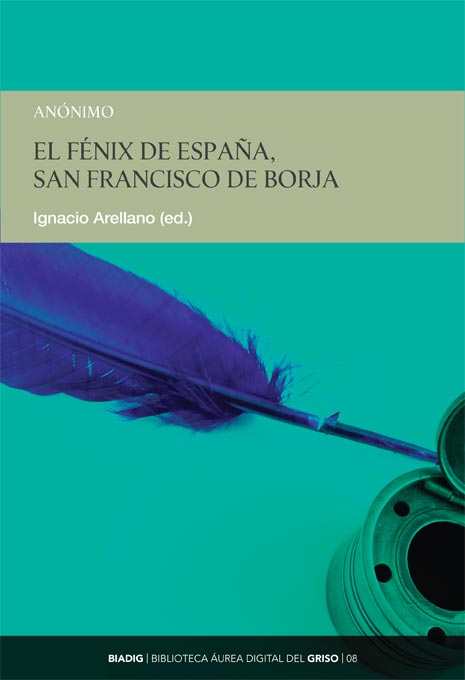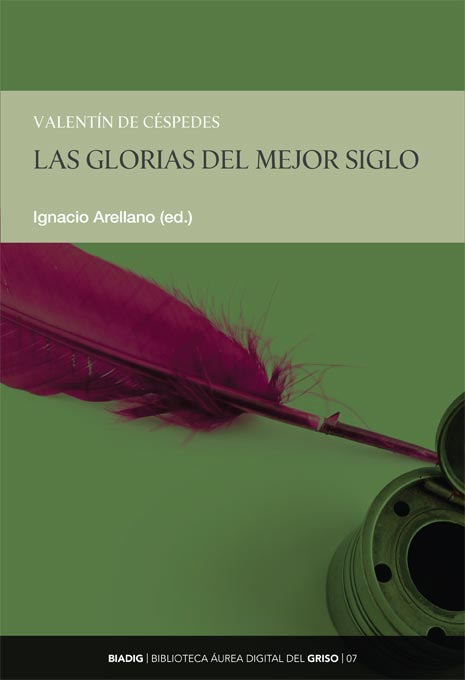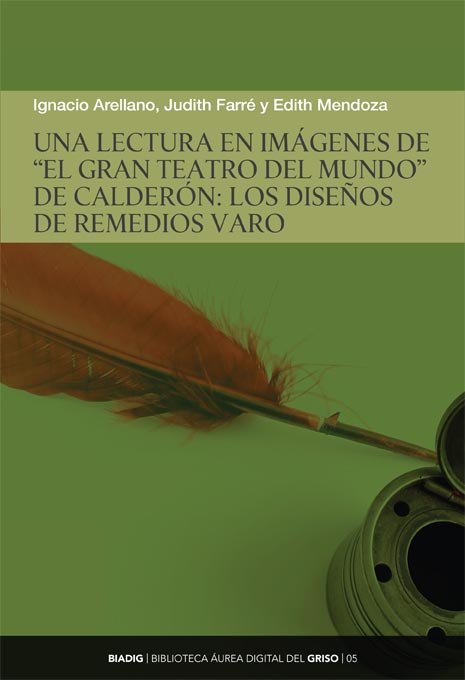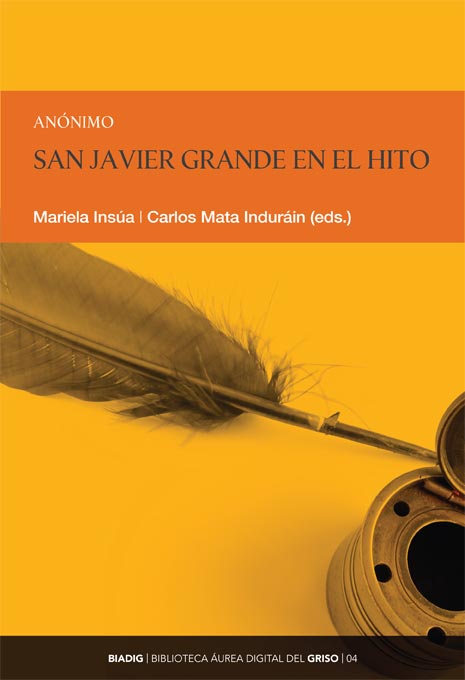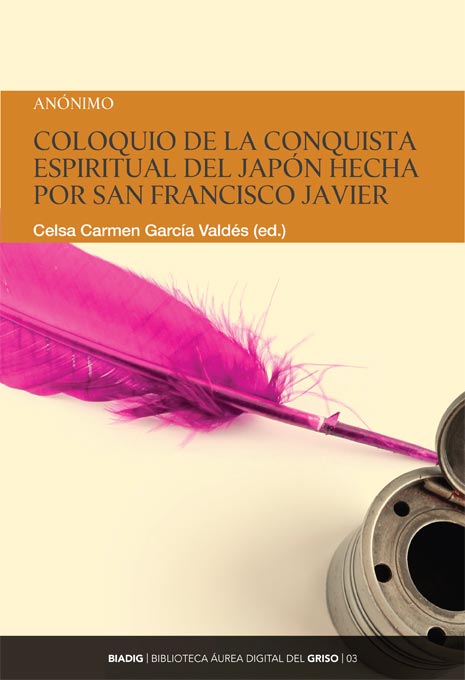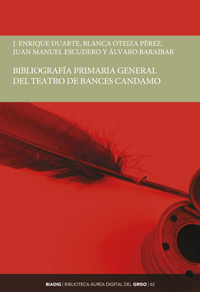BIADIG Collection
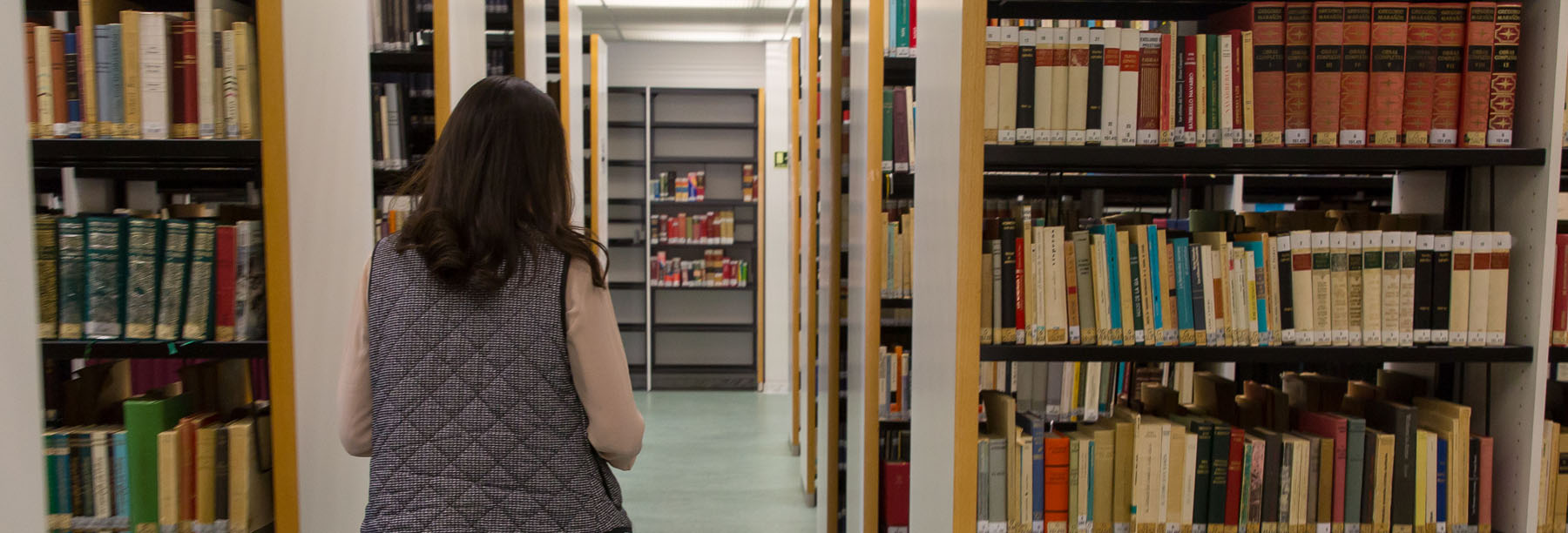
The BIADIG Collection (Library Services Áurea Digital del GRISO), launched in 2010, includes programs of study monographs, collective volumes, conference proceedings of conferences, bibliographies and critical editions of works from the Hispanic Golden Age. Its contents, published under licence Creative Commons, are available in Open Access, immediately and free of charge, within the reach of the academic community and the general public.
► Director: Jesús M. Usunáriz (GRISO-University of Navarra, Spain)
► administrative assistant: Mariela Insúa (GRISO-University of Navarra, Spain)
► Ignacio Arellano (GRISO-University of Navarra, Spain)
► Carlos Mata Induráin (GRISO-University of Navarra, Spain)
Norddin Achiri( University of Sidi Mohamed Ben Abdellah, Morocco)
► Arbey Atehortúa (Universidad Tecnológica de Pereira, Colombia)
► Tapsir Ba (Université Cheikh Anta Diop, Senegal)
► Carlos Cabanillas (Universitetet i Tromsø, Norway)
► Bernat Castany Prado (University of Barcelona, Spain)
Pablo Chiuminatto( Pontificia Universidad Católica de Chile, Chile)
► Carolina Ferrer (Université du Québec à Montréal, Canada)
► Alejandro González Puche (Universidad del Valle, Colombia)
► Raïssa Kordic Riquelme (Universidad de Chile, Chile)
► Raúl Marrero-Fente (University of Minnesota, United States)
► Sabyasachi Mishra (VIT-Vellore University, India)
► Cristina Osswald (CITCEM - Universidade do Porto, Portugal)
► Emmanuel Marigno (Université Jean Monnet de Saint-Étienne, France)
► Hugo Hernán Ramírez Sierra (Universidad de los Andes, Colombia)
► Lygia Rodrigues Vianna Peres (Universidade Federal Fluminense, Brazil)
► Fernando Rodríguez Mansilla (Hobart and William Smith Colleges, United States)
► Oana Sambrian (Romanian Academy-Craiova, Romania)
The collection
Jorge Felipe Camargo Hernández and Carlos Mata Induráin (eds.), "Limae labor." conference proceedings XIV congress of Young Researchers on the Golden Age (JISO 2024), Pamplona, Publishing Services the University of Navarra, 2025.
BIADIG Collection (Digital Golden Library), 77 / GRISO Digital Publications.
ISBN: 978-84-8081-861-2.
The 28 papers included in this Issue the conference proceedings congress 14th congress "Young Researchers Golden Age" (JISO 2024), which was held in modality (in person in Pamplona and virtually) on December 12-13, 2024, organized by the research group (GRISO) of the University of Navarra, in partnership, as in all previous editions, with the Institute of programs of study (IDEA). The meeting, which was attended by 47 young researchers from thirteen countries (namely Argentina, Brazil, Canada, Chile, China, Colombia, Spain, the United States, France, Italy, Mexico, Peru, and Portugal), was structured around thirteen communication sessions dedicated to various topics. As in previous years, three aspects of the congress 2024 congress are particularly noteworthy: the international nature of its participants; the approach of meeting; and the high quality of the papers presented, which interested readers can enjoy in these conference proceedings, whose degree scroll Limae labor, refers to verses 289-291 of Horace's Ars poetica: "Nec uirtute foret clarisue potentius armis / quam lingua Latium, si non offenderet unum / quemque poetarum limae labor et mora," which alludes to work careful and painstaking work correction required by literary texts, committee equally committee to academics.
Carlos Mata Induráin, Full Professor Literature, is researcher Academic Secretary group research de Oro (GRISO) research group at the University of Navarra, Secretary of the Instituto de programs of study (IDEA) and Secretary of the association . He is also a corresponding member in Spain of the Bolivian Academy of the language . His research on Spanish literature of the Golden Age (burlesque comedy, Calderón, Cervantes, and Quijote and Cervantes-inspired recreations, plays about the Arauco War, etc.). He is the author of the literature blog Ínsula Barañaria.
Jorge Felipe Camargo Hernández is a historian from the Pontificia Universidad Javeriana, holds Master's Degree Latin American History-Indigenous Worlds from the Universidad Pablo de Olavide, and is PhD student Arts and Humanities the Universidad de Navarra. His academic career has focused on the ecclesiastical and social history of the Viceroyalty of New Granada during the 16th and 17th centuries. His historiographical interests lie in rescuing the survivals and connections between the colonial past and contemporary ways of narrating, teaching, and thinking about it critically from multiple perspectives; regional history; and the challenges of teaching in school and university settings.
|
Table of contents |
Page |
Download |
|
Jorge Felipe CAMARGO HERNÁNDEZ and Carlos MATA INDURÁIN, "presentation" |
9 |
|
|
Julio de la A-GONZÁLEZ, "For the study and critical and digital edition of Manuel de Nájera's Funeral Sermons (1666)" |
13 |
|
|
Jaume ALAVEDRA I REGÀS, "Image of Spanish politics during the preliminaries to the Peace Treaty of Westphalia in the plenipotentiary diplomat Diego Saavedra Fajardo" |
29 |
|
|
Ana Beixi AUSÍN ARPÓN, "The image of Mary Stuart in the chronicles and literary works of the Spanish Golden Age" |
51 |
|
|
Jorge Felipe CAMARGO HERNÁNDEZ, "Between scholars and 'sub-scholars'. Critical editing as a contribution to the intellectual reality of the scribe Juan Flórez de Ocáriz (1670)" |
73 |
|
|
Álvaro CUBAS MUSTO, "Extirpation and Inquisition: two ways to combat idolatry in the Viceroyalty of Peru" |
89 |
|
|
María Isabel CUENA CARO-PATÓN, "The 'Songs of the Bride' or other forms of attention: reading Saint John of the Cross" |
99 |
|
|
Azucena DONKERVOORT, "The recreation of the birth of the Spanish Golden Age in nineteenth-century Spanish historical novels. The case of Hernán Pérez del Pulgar by Francisco Martínez de la Rosa." |
115 |
|
|
Zsófi FRIEDRICH, "The statutes of blood purity in Spanish society during the 15th-17th centuries: the case of Martín Ibáñez de Monreal" |
131 |
|
|
María Victoria GALLEGO MAGRANER, "A comedy among variants: The honorable revenge of Gaspar de Aguilar and Ms. 18.354 of the BNE" |
149 |
|
|
Gabriel GARZA ALGABA, "Historical elements in Lope de Vega'scomedy El esclavo de Roma " |
173 |
|
|
Julián Mauricio GÓMEZ OCAMPO, "Granadian independence exploits through children's literature: Oswaldo Díaz Díaz's Cuentos tricolores (1967)" |
191 |
|
|
Irene GÓMEZ VALVERDE, "Religion and Prisca Theologia in the Royal Commentaries of Inca Garcilaso de la Vega" |
203 |
|
|
Oscar GUERRERO, "The problem of the 'crises' of masculinity: performativity and corporeality in Golden Age literature" |
217 |
|
|
Hajar KHALOUI, "The Shadow of Don Quixote: Intermediality and Hybridization in the Contemporary Work of Lara Fuentes and Patricio Clarey" |
233 |
|
|
Javier MARTÍNEZ SARASATE, "From the arena to the pen: bulls, gladiators, and their reception in the Golden Age as a legacy of the Roman past" |
255 |
|
|
Óscar Alessandro MIRANDA VÉLEZ, "The 'Canarian Ingenuity': Bartolomé Cairasco de Figueroa and the Canary Islands in the Golden Age" |
269 |
|
|
Javier MUNILLA ANTOÑANZAS, "Joy in Sabuco's work: a case study in the history of emotions" |
287 |
|
|
Alexander NOREÑA, "Intertextuality, an approach to the concept of reconciled narrative-visual space in the adaptation of Don Quixote de la Mancha to the wordless picture book" |
301 |
|
|
Renan PAIVA DA SILVA, "Jonadab as a comic agent in Los cabellos de Absalón by Pedro Calderón de la Barca" |
313 |
|
|
Eva RIVEIRO FORMOSO, "Borges and Valente on Quevedo: an approach" |
321 |
|
|
Adramis RUIZ RODRÍGUEZ, "An Erasmian reading of Lazarillo de Tormes: social and religious criticism on the threshold of the Golden Age" |
335 |
|
|
Darlyn Tatiana SÁNCHEZ BURGOA, "Literary creations based on the dreams and speeches of Francisco de Quevedo: L'Algouasil burlesque del Sieur de Bourneuf" |
353 |
|
|
Jesús María SERRANO TENOR, "Light sculpture in Baroque Andalusia: issues and current status" |
369 |
|
|
María Angélica SOLAR spanish medical residency program, "The educational purpose of metafiction in La fingida Arcadia by Tirso de Molina" |
385 |
|
|
Romeu da SILVA TEIXEIRA, "The contemporary literary myth in Juan Marsé's picaresque novels" |
399 |
|
|
Tara TRANCÓN PUJOL, "The intrinsic value of water in the science of architecture: Cristóbal de Rojas" |
413 |
|
|
María VÁZQUEZ ALBA, "Methodologies for research the art of engraving in the Spanish Golden Age from a gender perspective: Anna Heylan, María Eugenia de Beer, and María Luisa Morales" |
431 |
|
|
Mary Alba WOLFSON, "Juana la Loca in the female context of the English court" |
445 |
Francisco Javier Escudero Buendía, Carlos Mata Induráin and Miguel Romero Saiz (eds.), Miguel de Cervantes: la Mancha que recorrió don Quijote, Pamplona, Publishing Services de la Universidad de Navarra, 2025.
BIADIG Collection (Biblioteca Áurea Digital), 76 / GRISO Digital Publications.
ISBN: 978-84-8081-853-7.
This Issue includes thirteen papers presented at the Internationalcolloquium "Miguel de Cervantes: la Mancha que recorrió don Quijote" ( Cuenca, October 2023), which form a sheaf of approaches to Cervantes and Don Quixote written with different approaches and methodologies. Thus, José María Merino contributes a beautifulgraduate essay "Cree en tus sueños" (Believe in your dreams). Francisco Javier Escudero Buendía submission a documentary research focused on the graduate Juan de Cervantes, the writer's grandfather. Various aspects related to Don Quixote are dealt with in the works of Ana L. Baquero Escudero (the internship of intercalation in the Second Part of the novel), Kenneth Brown (on the "Great dogmatizer" of Chapter I, 6), Pilar Fernández-Cañadas Greenwood (the real paths and imagined itineraries of Don Quixote) and Edgar Paiewonsky Conde (chance in the author's instances of self-representation in Don Quixote of 1605). For his part, José Manuel González Mujeriego approaches the complex question of realism in Cervantes' work. The contributions by Jasna Stojanović, Benjamín Troyse and Alicia Villar Lecumberri deal with questions related to the reception of Cervantes and Don Quixote in Serbia, Mexico and Greece, respectively. Finally, the works of Eduardo Aguirre (his play Entrevista a Cervantes) and Carlos Mata Induráin (the poetry book Íntima a Quijote by Sagrario Torres) deal with Quixotic or Cervantine recreations.
Francisco Javier Escudero Buendía holds a PhD in Humanities from the University of Castilla-La Mancha and is archivist of the board of Communities of Castilla-La Mancha. In 2020 he published, in three volumes, his doctoral research dedicated to the real characters of Don Quixote. Other recent Cervantine publications are Eso no estaba en mi libro de Miguel de Cervantes ( 2025) or Cervantes del envés. Characters in search of their author in the "Novelas ejemplares" ( 2025).
Carlos Mata Induráin, accredited Full Professor of Spanish Literature, is researcher and secretary of the research group Siglo de Oro (GRISO) of the University of Navarra, secretary of the association of Cervantistas and secretary of the Institute programs of study Aurisecular programs of study (IDEA). His research interests are focused on the Spanish literature of the Golden Age (burlesque comedy, Calderón, Cervantes and the Cervantes and quixotic recreations, etc.).
Miguel Romero Saiz holds a PhD in History, is a corresponding member of the Royal Academy of History and president of the Instituto de programs of study Conquenses (IDEC), as well as official chronicler of the city of Cuenca. In his professional career he has combined teaching and research with his work as a lecturer and publications in the written press, and he is also the author of several dozen creative booksessay, narrative, poetry, travel...).
|
Table of contents |
Page |
Download |
|
Francisco Javier ESCUDERO BUENDÍA, Carlos MATA INDURÁIN and Miguel ROMERO SAIZ, "Cervantes, el Quijote y don Quijote en Cuenca: un colloquium con visos de continuidad". |
9 |
|
|
Eduardo AGUIRRE ROMERO, "Some brief notes on my Interview with Cervantes". |
13 |
|
|
Ana L. BAQUERO ESCUDERO, "Variations on the internship of intercalation in Don Quixote II: the story of Don Diego de Miranda". |
17 |
|
|
Kenneth BROWN, "The "Great Dogmatizer" of Don Quixote, Chapter 6". |
35 |
|
|
Francisco Javier ESCUDERO BUENDÍA, "El periplo del graduate Juan de Cervantes: los años perdidos en Salamanca, Ocaña, Yepes y Cuenca (1520-1525) y su influencia literaria" (The journey of graduate Juan de Cervantes: the lost years in Salamanca, Ocaña, Yepes and Cuenca (1520-1525) and their literary influence). |
85 |
|
|
Pilar FERNÁNDEZ-CAÑADAS GREENWOOD, "Caminos reales, itinerarios imaginados: ¿qué mapas llevaba don Quijote en sus aventuras por la Mancha?" |
129 |
|
|
José Manuel GONZÁLEZ MUJERIEGO, "Realism in Cervantes' work". |
155 |
|
|
Carlos MATA INDURÁIN, "Dulcinea del Toboso, don Quijote, la Mancha, el amor: el poemario Íntima a Quijote (1986) de Sagrario Torres" (Dulcinea del Toboso, don Quijote, la Mancha, el amor: el poemario Íntima a Quijote (1986) by Sagrario Torres)". |
167 |
|
|
José María MERINO, "Believe in your dreams". |
197 |
|
|
Edgar PAIEWONSKY CONDE, "El azar en las instancias de autorrepresentación del autor |
217 |
|
|
Miguel ROMERO SAIZ, "Erasmism in Don Quixote de la Mancha". |
229 |
|
|
Jasna STOJANOVIĆ, "Moving the boundaries of dramatic art: translations, interpretations and performances of Cervantes' entremeses in Serbia." |
237 |
|
|
Benjamín TROYSE, "El camino de Cervantes, de México a la Mancha". |
249 |
|
|
Alicia VILLAR LECUMBERRI, "On what happened to Cervantes, who was in search of the titles of the chapters of Don Quixote, and how they have been translated into modern Greek (Part One)." |
261 |
|
Youssouph Coly, Djidiack Faye, Carlos Mata Induráin and Djibril Mbaye (eds.), Doce ensayos sobre literatura y sociedad, Pamplona, Publishing Services de la Universidad de Navarra, 2025.
BIADIG Collection (Biblioteca Áurea Digital), 75 / GRISO Digital Publications.
ISBN: 978-84-8081-857-5.
This Issue gathers a dozen papers that were presented at the IV Ibero-African congress of Hispanists ("Literature and Society"), held at the Université Gaston Berger, UGB (Saint-Louis, Senegal) in April 2023. The contributions of Adama Diaga Faye (Alonso de Castillo Solórzano), Djidiack Faye (Mariana de Carvajal and Juan Pérez de Montalbán), Carlos Mata Induráin (political and clandestine satire poetry) and Georgette Thioume Ndour (Saint Teresa de Jesús) will focus on authors and literary genres of the Golden Age (16th and 17th centuries). The contributions by Youssouph Coly (Laura Restrepo), Djibril Mbaye (Mario Vargas Llosa) and M'bare N'gom (María Teresa Ramírez, Cristina Cabral and Máximo Torres Moreno) deal with Latin American authors. Finally, the remaining works deal with diverse issues related to authors and situations on the African continent: Khadidiatou Diallo (the intergenerational dialogue between feminist figures in West Africa), Papa Diégane Faye Faye (commitment in the work of Senegalese writer and filmmaker Ousmane Sembène), Abdoulaye Gueye (questions of identity in Donato Ndongo-Bidyogo's The Darkness of Your Black report ), Ousmane Ngom (the expression of white rage in African-American and South African literatures: Alice Walker and Alex La Guma) and Fernando Ignacio Ondo Ndjeng Afang (Equatorial Guinea's contribution to the service of Hispanidad).
Youssouph Coly holds a PhD in Spanish-American Literature from the Complutense University of Madrid and is a researcher at the Assane Seck University of Ziguinchor (Senegal). He is the author of numerous publications and papers on Spanish-American Literature of the 20th and 21st centuries, Didactics of Spanish, Spanish/French Translation and Intercultural Issues.
Djidiack Faye, PhD from the University of León and Maître de Conférences (CAMES) in Spanish literature of the Golden Age, is Dean of the School of Letters and Human Sciences at the Gaston Berger University of Saint-Louis. A specialist in the narrative of María de Zayas, he is also interested in the works of Alonso de Castillo Solórzano and Mariana de Carvajal.
Carlos Mata Induráin, accredited Full Professor of Literature, is a researcher and Secretary of GRISO (University of Navarra) and IDEA. His research focuses on Spanish literature of the Golden Age: burlesque comedies, Calderón's autos sacramentales, Cervantes and the quixotic and Cervantine recreations, plays about the Arauco War... He is the author of the blog Ínsula Barañaria.
Djibril Mbaye, Maître de Conférences CAMES, is researcher and Director of the department of Romance Languages at the Cheikh Anta Diop University of Dakar. His areas of research are: Hispanic-American and Afro-Hispanic Literature and Civilizations, Common History of Africa and Latin America, Spanish and Hispanicism in Senegal...
|
Table of contents |
Page |
Download |
|
Youssouph COLY, Djidiack FAYE, Carlos MATA INDURÁIN and Djibril MBAYE, |
9 |
|
|
Youssouph COLY, |
11 |
|
|
Khadidiatou DIALLO, |
25 |
|
|
Adama Diaga FAYE, |
57 |
|
|
Djidiack FAYE, |
71 |
|
|
Papa Diégane FAYE, |
89 |
|
|
Abdoulaye GUEYE, |
109 |
|
|
Carlos Mata Induráin, "Mecanismos de la burla en la poesía de sátira política y clandestina del Siglo de Oro español: rimas jocosas y otros recursos métricos humorísticos". |
129 |
|
|
Djibril MBAYE, |
155 |
|
|
Georgette Thioume NDOUR, |
171 |
|
|
M'bare N'GOM, |
189 |
|
|
Ousmane NGOM, |
207 |
|
|
Fernando Ignacio ONDO NDJENG AFANG, |
227 |
|
BIADIG Collection (Biblioteca Áurea Digital), 74 / GRISO Digital Publications.
ISBN: 978-84-8081-846-9.
Starting from different approaches and using different methodologies, the eleven works included in this Issue deal with various aspects related to the creation and characteristics of the character invented by Cervantes (and by Alonso Quijano/Don Quixote), as well as with various later recreations of Dulcinea in literature and art. It is obvious to say that this sheaf of critical contributions cannot exhaust the immense wealth contained in Cervantes' creation and his recreations through the centuries, but as a whole they constitute a significant approach to the figure of Dulcinea del Toboso, to her literary essence and her artistic entity. The book is dedicated to the illustrious cervantista Enrique Rull Fernández, who finally could not participate in July 2022 in the I International colloquium "Dulcinea del Toboso. La creación cervantina y otras Dulcineas recreadas", held in El Toboso (Toledo), meeting that is at the origin of these pages that are now published. For his good work as a colleague, for his always discreet wisdom and, above all, for the good times shared over so many years, the editors -and undoubtedly also all the authors who write here- wanted to dedicate these pages to honor Enrique's report , with the always affectionate memory of his kindness and generous friendship.
|
Table of contents |
Page |
Download |
|
Isabel Fernández Morales, Rachele Lo Piano and Carlos Mata Induráin, "Dulcinea del Toboso, en El Toboso (by way of presentation)". |
9 |
|
|
Jordi Aladro, "Aldonza Lorenzo: the woman who made possible the dream of a shy nobleman". |
13 |
|
|
Jéssica Castro Rivas, "Dulcinea abreviada: recreaciones contemporáneas en el microrrelato". |
25 |
|
|
Francisco Javier Escudero Buendía, "Dulcineas del Toboso: destruction of myths, archives and women of flesh and blood in the construction of the quixotic character (1578-1591)". |
39 |
|
|
Santiago López Navia, "Las (pen)últimas Dulcineas en las recreaciones narrativas hispánicas del Quijote". |
59 |
|
|
Emmanuel Marigno, "Dulcinea in Welsh - and French-speaking - rewritings of the 20th-21st centuries". |
79 |
|
|
José Manuel Martín Morán, "Caras y caretas de un mito. Dulcinea in the illustrated editions of Don Quixote in the 20th century." |
93 |
|
|
Carlos Mata Induráin, "Dulcinea falls in love with Cervantes or how (almost) anything is possible in a serialized novel by Manuel Fernández y González". |
123 |
|
|
Amparo Ruiz Luján, "Dulcinea: poetics of absence". |
155 |
|
|
Ana Suárez Miramón, "Dulcinea, conversion into woman and woman into idea". |
191 |
|
|
Alicia Villar Lecumberri, "Who writes to whom: "Letter from Don Quixote to Dulcinea" and the best kept message". |
211 |
|
|
Carmela Zanelli, "The (im)possibility of tragedy in Cervantes' Don Quixote . A new look at the character of Dulcinea." |
225 |
|
BIADIG Collection (Biblioteca Áurea Digital), 73 / GRISO Digital Publications.
ISBN: 978-84-8081-829-2.
The 33 papers collected in this Issue are the conference proceedings of the XIII International congress "Jóvenes Investigadores Siglo de Oro" (JISO 2023), which was held in hybrid modality (face-to-face in Pamplona and virtual) on December 13-15, 2023, organized by the research group Siglo de Oro (GRISO) of the University of Navarra, in partnership, as in all previous editions, with the Instituto de programs of study Auriseculares (IDEA). The meeting, which was attended by 50 young researchers from ten countries (Argentina, Brazil, Chile, France, Mexico, Peru, Portugal, Spain, United Kingdom, United States and United Kingdom), was structured around fourteen sessions of papers on a variety of topics. As in previous years, three points stand out in this JISO 2023 congress : the international character of its participants; the interdisciplinary approach of the meeting; and the high quality of the papers presented, which the curious reader can enjoy in these conference proceedings, whose degree scroll, Nulla dies, refers to the Latin phrase "Nulla dies sine linea" by Pliny the Elder(Natural History, XXXV, 84), who attributes it to the Greek painter Apelles of Colophon, who is said not to have spent a day without painting at least one line.
Carlos Mata Induráin, accredited Full Professor of Literature, is researcher and Academic Secretary of the research group Siglo de Oro (GRISO) of the University of Navarra, Secretary programs of study the Instituto de programs of study Auriseculares (IDEA) and Secretary of the association of Cervantistas. He is also correspondent in Spain of the Bolivian Academy of the Spanish language and partner of Honor of the Cervantine Society of Alcazar de San Juan. His research interests focus on Spanish literature of the Golden Age (burlesque comedy, Calderón, Cervantes and quixotic recreations, plays about the Arauco War, etc.). He is the author of the literature blog "Ínsula Barañaria".
Ariel Núñez Sepúlveda holds a graduate and Master's Degree in Hispanic language and literature from the University of Chile and a PhD in Arts and Humanities from the University of Navarra. His doctoral work , which is in press, consisted of a critical edition of the comedy Andrómeda y Perseo, by Pedro Calderón de la Barca. She has participated in several international conferences and has published articles on baroque art and literature, focusing her attention on the theater of the Golden Age and the narrative of Cervantes. She has also completed a research stay at the Università degli Studi di Roma-La Sapienza. She is currently teaching at the Public University of Navarra.
|
Table of contents |
Page |
Download |
|
Carlos Mata Induráin and Ariel Núñez Sepúlveda, "presentation". |
9 |
|
|
Álvaro Agis Somolinos, "La entretenida y la recepción de ficciones cervantina". |
13 |
|
|
Samuel Aguirre, "Algún apunte en contra de considerar el Proceso de Juan de Segura la primera novela epistolar". |
27 |
|
|
Jaume Alavedra i Regàs, "La imagen barroca en Idea de un príncipe político cristiano representada en cien empresas del diplomático Saavedra Fajardo". |
43 |
|
|
Carlo Basso, "The New Flos Sanctorum of Alonso de Villegas in Italy: the translation by Timoteo da Bagno". |
59 |
|
|
Gustavo Luiz Nunes Borghi, "Antimaquiavelismo, razón de Estado y training del príncipe en el Tratado de la religión y virtudes que debe tener el príncipe cristiano... (1595), de Pedro de Ribadeneyra." |
85 |
|
|
Estefanía Cabello, "John Bowle, biographer of Cervantes in the 18th century English press: the case of the Gentleman's Magazine (1781 and 1784). Edition and translation." |
101 |
|
|
Jorge Felipe Camargo Hernández, "The Genealogies of the New Kingdom of Granada (1674). From the "telephoneguide " in colonial research to the cultural expression of the Neo-Granadian Golden Age". |
125 |
|
|
Joaquín Carreño Gallardo, "From the earthly city to the City of God: the peregrinatio vitae of Agustino in Lope de Vega's El divino africano ". |
139 |
|
|
Laura Castro Álvarez, "El hápax en los sonetos amorosos de Góngora y Quevedo". |
155 |
|
|
Lucio R. Cebreiro, "The plagiarism of the "Commentary on the satire of Valles Ronces": finding a third source". |
167 |
|
|
Izaro Díaz Manso, "On silence in two comedies by Tirso de Molina: El castigo del penseque and Quien calla, otorga". |
181 |
|
|
Azucena Donkervoort, "The passage into print of Mandeville's Book of the Wonders of the World as transmission and adaptation of an eschatological imaginary in 16th century Valencia". |
199 |
|
|
Adama Diaga Faye, "A pictorial language: hypotypes and prosopography in Mariana de Carvajal's Navidades de Madrid y noches entretenidas (1663)." |
217 |
|
|
Laura Ferrer Blé, "Analysis of the theatrical genre in the case of El loco por fuerza, a comedy attributed to Lope de Vega". |
235 |
|
|
Pedro Fresno Chamorro, ""Misericordia et veritas non te deserant": the appreciation of the truth in Solo Madrid es Corte by Alonso Núñez de Castro". |
249 |
|
|
Alejandro García Gómez, ""Against other princes it would be dangerous this way of writing". An early Hispanic response to Traiano Boccalini". |
265 |
|
|
Gabriel Garza Algaba, "The status of early Christianity through the comedy Roma abrasada by Lope de Vega". |
281 |
|
|
Iván Gómez Caballero, "La trayectoria escénica de Antonio Coello Ochoa en el siglo XVII". |
299 |
|
|
Irene Gómez Valverde, "El soneto de Benito Arias Montano a Miguel de Fuenllana en su entorno literario" (Benito Arias Montano's sonnet to Miguel de Fuenllana in his literary environment). |
323 |
|
|
Paula González Carrascosa, "Giving and honoring: an analysis of the politics and administration of the reign of Philip IV (1621-1665)." |
339 |
|
|
Emma González Mesas, "Las potencialidades escénicas de La casa de los celos: una lectura desde las acotaciones". |
353 |
|
|
Mariana Ladrón de Guevara Zuzunaga, "La destrucción de mallquis, hijos de huacas: dificultades del proceso de extirpación de idolatrías andinas en la obra de Pablo José de Arriaga (1621)" (The destruction of mallquis, sons of huacas: difficulties of the process of extirpation of Andean idolatries in the work of Pablo José de Arriaga (1621))". |
369 |
|
|
Alberto Lara Ramírez, "La hermosura y la desdicha: problemas de autoría en una comedia atribuida a Rojas". |
383 |
|
|
Aida Martín Valbuena, ""Bríndeme un vuestra merced que de vos ya no me trate": la desvalorización del paradigma voseante en el Estilo de escreuir cartas mensageras cortesanamente y en las cartas escritas desde la otra orilla". |
399 |
|
|
Rodrigo Morales Grajales, "Mateo Alemán, follower of the ideas of Luis Vives". |
425 |
|
|
Sergio Navarro, "The imagination stirring a thousand things: perception and crisis of the poetic subject in the Voyage of Parnassus". |
437 |
|
|
José Rama Domínguez, "Contrition in Quevedo's Tears of a penitent: a dialogical analysis". |
453 |
|
|
Lidia Recarey Ponte, "Un controvertido testimonio de la obra de Quevedo: hacia la edición del manuscrito M-139 de la Biblioteca de Menéndez Pelayo" (Lidia Recarey Ponte, "A controversial testimony of Quevedo's work: towards the edition of manuscript M-139 of the Menéndez Pelayo Library"). |
463 |
|
|
Érika Redruello Vidal, "Otro panegírico inconcluso. Salcedo Coronel's encomium to Prince Baltasar Carlos". |
475 |
|
|
Jon Rivero Pérez, ""Is this an illusion or a dream / that the soul barely penetrates?": Calderonian echoes in an unpublished comedy by Jacinto Cordeiro". |
493 |
|
|
Miriam Rodríguez Somoza, "From the bucolic garcilasiana to O Lima: notes on the eclogue "To the long field of the famous river", by Diogo Bernardes". |
509 |
|
|
Inês de Sá, "Love in Baroque theater written by Portuguese women". |
521 |
|
|
Guadalupe Sobrón Tauber, "Re-reading Calderón from a gender perspective: the representation of rape and its implications in No hay cosa como callar". |
539 |
|
Carlos Mata Induráin, Juan Bautista Mata-Peñuela and Luis Miguel Román Alhambra (eds.), Cervantes y el "Quijote" desde Alcázar: literatura, historia, sociedad, Pamplona, Publishing Services de la Universidad de Navarra, 2024.
BIADIG Collection (Biblioteca Áurea Digital), 72 / GRISO Digital Publications.
ISBN: 978-84-8081-837-7.
In November 2022, the International congress "Cervantes and Don Quixote from Alcázar: literature, history, society" was held in Alcázar de San Juan (Ciudad Real). This Issue includes eight papers read at that meeting, which constitute a multidisciplinary approach to the life and work of Cervantes, with special attention to his immortal Don Quixote. Thus, the paper by Francisco José Atienza Santiago and Marcial Morales Sánchez-Tembleque analyzes in depth the baptismal certificate of Miguel de Cervantes de Alcázar de San Juan. Enrique Suárez Figaredo's contribution focuses on the material aspects related to the printing of Don Quixote in 1605. Susan Byrne analyzes "La otra verosimilitud cervantina", while Lucía López Rubio deals with the characterization of some of Cervantes' characters, especially female ones. The texts by Mariano Avilés Muñoz, Luis Caballero Martínez and Benjamín Montesinos Comino introduce interesting points of approach to Cervantes, Don Quixote and Don Quixote from the sciences (medicine, psychiatry, astronomy). Finally, Carlos Mata Induráin's contribution approaches the field of Cervantes' recreations in contemporary Spanish historical novels.
Carlos Mata Induráin, accredited Full Professor of Literature, is researcher and secretary of the research group Siglo de Oro (GRISO) of the University of Navarra, secretary of the association of Cervantistas and of the Instituto de programs of study Auriseculares (IDEA). He is also correspondent in Spain of the Academia Boliviana de la language. His research interests focus on the Spanish literature of the Golden Age (burlesque comedy, Calderón, Cervantes and the Cervantes and quixotic recreations, etc.).
Juan Bautista Mata Peñuela studied computer science at the Polytechnic University of Madrid, and specialized in the development of computer applications in the business he founded in 1996. In 2017 he joined the Sociedad Cervantina de Alcázar de San Juan, and since 2019 he has been its president. Raised among books, thanks to the printing, bookshop and stationery shop owned by his family, and an avid reader since childhood, his approach to writing has led him to compose more than twenty stories on very different subjects.
Luis Miguel Román Alhambra is a Technical Specialist in Industrial Delineation and has studied Geography at the UNED. independent researcher , he has edited five essays on geography in Don Quixote and published more than three hundred articles in blogs, magazines and newspapers, and participated in Cervantine congresses with papers related to geography in Don Quixote. founding partner in 2014 of the Cervantine Society of Alcázar de San Juan and first president, he is also a member of the association of Cervantistas.
|
Table of contents |
Page |
Download |
|
Carlos MATA INDURÁIN, Juan Bautista MATA PEÑUELA and Luis Miguel ROMÁN ALHAMBRA, "Cervantes y el Quijote desde Alcázar, Cervantes y el Quijote en Alcázar. A modo de presentation". |
7 |
|
|
Francisco José ATIENZA SANTIAGO and Marcial MORALES SÁNCHEZ-TEMBLEQUE, "The baptismal certificate of Miguel de Cervantes de Alcázar de San Juan". |
11 |
|
|
Mariano AVILÉS MUÑOZ, "Diálogos con don Quijote: el tortuoso camino en busca de la sanación (Una lecture imaginaria, cerca a la realidad)" (Dialogues with don Quijote: the tortuous path in search of healing (An imaginary lecture , close to reality)". |
49 |
|
|
Susan BYRNE, "The Other Cervantine Verisimilitude". |
59 |
|
|
Luis CABALLERO MARTÍNEZ, "Don Quixote and Sancho as Cervantes' therapists". |
75 |
|
|
Lucía LÓPEZ RUBIO, "Marriage, death and devotion. The flight to the convent of Cervantine characters". |
83 |
|
|
Carlos MATA INDURÁIN, "Cervantes recreated in the contemporary Spanish historical novel: Misterioso asesinato en casa de Cervantes ( 2015) by Juan Eslava Galán". |
101 |
|
|
Benjamín MONTESINOS COMINO, "El cielo en el Quijote visto por un asónomo alcazareño" (The sky in Don Quixote as seen by an astronomer from Alcazar). |
135 |
|
|
Enrique SUÁREZ FIGAREDO, "Construyendo el Quijote: en torno a la impresión de la novela cervantina". |
147 |
|
Carlos Mata Induráin, Ariel Núñez Sepúlveda and Miren Usunáriz Iribertegui (eds.), "Multum legendum". conference proceedings del XII congress Internacional Jóvenes Investigadores del Siglo de Oro (JISO 2022), Pamplona, Publishing Services of the University of Navarra, 2023.
BIADIG Collection (Library Services Áurea Digital), 71 / GRISO Digital Publications.
ISBN: 978-84-8081-780-6
The 48 papers that are collected in the present Issue constitute the conference proceedings of the XII International congress "Jóvenes Investigadores Siglo de Oro" (JISO 2022), which was held in hybrid modality (face-to-face in Pamplona and virtual) on December 1-2, 2022, organized by the group of research Siglo de Oro (GRISO) of the University of Navarra, at partnership with the Institute of programs of study Auriseculares (IDEA). The meeting, which was attended by 78 young researchers from 12 countries (namely Argentina, Brazil, Chile, France, Germany, Italy, Mexico, Peru, Romania, Spain, United Kingdom, United States and United Kingdom), was structured around 25 paper sessions, dedicated to "Calderón and Rojas Zorrilla", "History and Society", "Saints and Sinners", "Lope de Vega", "Quevedo and his Reception", "Poetics and Poetry", "Cervantes and Quevedo", "Golden Women Writers", "Lope de Vega, Quevedo and Góngora", "Treatises and polemics", "Reception of the Golden Age and comparative literature", "Cervantes' Exemplary Novels and their reception", "Tirso de Molina and Calderón de la Barca", "History, historiography and society", "Art", "American themes", "Conventual writing", three tables on "Theater" plus another on "Dramatic characters" and four sessions "Of various lessons". As was the case in previous years, there are three main features to be highlighted in this congress JISO 2022: the international character of its participants; the interdisciplinary approach of meeting; and, of course, the high quality of the papers presented, which the curious reader can enjoy in these conference proceedings, whose degree scroll, Multum legendum, comes from Pliny the Younger: "Multum legen-dum, sed non multa".
Carlos Mata Induráin, Full Professor accredited in Literature, is researcher and Academic Secretary of group of research Siglo de Oro (GRISO) of the University of Navarra, Secretary of the Institute of programs of study Auriseculares (IDEA) and Secretary of the association of Cervantistas. He is also correspondent in Spain of the Bolivian Academy of the Spanish language . His lines of research focus on the Spanish literature of the Golden Age (burlesque comedy, Calderón, Cervantes and quixotic recreations, plays about the Arauco War, etc.). He is the author of the literature blog "Ínsula Barañaria".
Ariel Núñez Sepúlveda is graduate and Master's Degree in language and Hispanic literature from the University of Chile. He is currently PhD student at the GRISO of the University of Navarra thanks to a scholarship of the National Agency of research and development of the Government of Chile (ANID). Her doctoral work consists of a critical edition of the play Andrómeda y Perseo, by Pedro Calderón de la Barca. She has participated in several international conferences and has published articles on baroque art and literature, focusing her attention on the theater of the Golden Age and the narrative of Cervantes. He has also completed a research stay at the Università degli Studi di Roma-La Sapienza.
Miren Usunáriz Iribertegui, Master's Degree in Spanish and Latin American Literature at the University of Salamanca, has developed her doctoral thesis in the framework of the GRISO with a research focused on the use of mockery as a rhetorical, social and political weapon in polemics of the Golden Age. He has published articles and reviews in indexed journals on the influence of golden literature in contemporary authors or on controversial figures of the seventeenth century as José Pellicer. She has made two international stays at research at El high school in Mexico and at the University of Coimbra. She is currently a professor at the University of La Rioja.
|
Table of contents |
Page |
Download |
|
Carlos MATA INDURÁIN, Ariel NÚÑEZ SEPÚLVEDA and Miren USUNÁRIZ IRIBERTEGUI, "presentation". |
11 |
|
|
Rocío ALONSO MEDEL, "El hacer poético en el Carmelo vallisoletano: la obra poética de Cecilia del Nacimiento (1570-1646)". |
15 |
|
|
Annett AZBEL, "Bucolic Beelardo and rustic Beelardo: two models of Lopesque self-figuration". |
33 |
|
|
Carmen BALEZTENA MATEO, Germán BELTRAMO BALLÓN, Izaro DÍAZ MANSO, Gabriel GARZA ALGABA and Irene ORTIZ PALOMO, "#LopeEstrenaComedia (2022) or the revival in social networks of Lope de Vega's La dama boba ." |
43 |
|
|
José Rufino BELMONTE CARRASCO, ""Aun en las caídas [...] no habemos de desmayar": la melancolía en Ejercicio de perfección de Alonso Rodríguez". |
59 |
|
|
Janina Elena BILAN, "María de Zayas: on the road to autofiction". |
75 |
|
|
Gustavo Luiz Nunes BORGHI, "The reception of Aristotle's Poetics in the Golden Age: imitation and metaphor in Alonso López Pinciano's Philosophía antigua poética (1596)." |
87 |
|
|
Joaquín CARREÑO GALLARDO, ""¿Qué aguardas, ignorante pensamiento, / viendo que Dios te llama y te provoca?": la razón humana como obstáculo para la obtención de la fe en El divino africano de Lope de Vega". |
105 |
|
|
Irene CASTELLÓ GARCÍA, "Towards a philological characterization of the Historia del Huérfano (1621) as a literary manifestation of hybrid character". |
119 |
|
|
Laura CASTRO ÁLVAREZ, "Death in the love poetry of Quevedo and Góngora". |
135 |
|
|
Lucio R. CEBREIRO, "A proposal for the dating of three anti-French romances". |
147 |
|
|
Jesús Ricardo CÓRDOBA PEROZO, "Mujer y monarquía en los libros de caballerías: Isabel la Católica y el Primaleón (1512)". |
159 |
|
|
Pablo FERNÁNDEZ PÉREZ, "The representation of "encubertismo" in the comedy El encubierto by Diego Jiménez de Enciso". |
177 |
|
|
Amparo FERNÁNDEZ RICHARDS, "La representación de la Fortuna en Mira de Amescua, Lope y Calderón: los dramas de privanza". |
193 |
|
|
Iago Brais FERRÁS GARCÍA, "El speech de la Historia general de España de Juan de Mariana como un arma historiográfica en el Siglo de Oro". |
207 |
|
|
Alejandro FIELBAUM S., "Contar sin saber. The goats of Sancho |
223 |
|
|
Manuel FUNES, "Alienation and rectification: the role of allegorical figures in Miguel de Cervantes' La casa de los celos y selvas de Ardenia ". |
235 |
|
|
Alejandro GARCÍA GÓMEZ, "Spanish-Italian pen wars in the Panegyric in apologetic epitome of Spain (1632-1635)". |
245 |
|
|
Gabriel GARZA ALGABA, "Pizarro and Hernán Cortés in two golden comedies: Las palabras a los reyes y gloria de los Pizarros by Luis Vélez de Guevara and La conquista de México by Antonio Enríquez Gómez." |
261 |
|
|
Helena GONZÁLEZ DOMÍNGUEZ, "Operativity of the dramatic system in two comedies of cloak and sword by Rojas Zorrilla". |
275 |
|
|
Javier GONZÁLEZ LARREA, "A postcolonial perspective on the literature of the Golden Age". |
289 |
|
|
Jorge GONZÁLEZ SEGURA, ""A su imagen y semejanza". The link between nobility and monarchy through the relics of St. Pedro Regalado. The cases of Juan de Zúñiga Avellaneda y Bazán and Francisco de Sandoval y Rojas with Philip III." |
297 |
|
|
Diana Alejandra GRANJENO NAVA, "Three types of illusion in Agustín Moreto's entremeses". |
319 |
|
|
Hugo JIMÉNEZ ZURITA, "La Monarquía de España y las nuevas formas de religiosidad en el Siglo de Oro: un estudio comparado en torno al fenómeno alumbrado". |
331 |
|
|
Gabriel LÓPEZ COB, "The dramatic corpus of Ambrosio de Arce: the case of The Hercules of Hungary". |
343 |
|
|
Jorge MARÍN BLANCO, "Reception of the writers of the Golden Age in the literary magazines of the 20th century: Alfonso Canales and Caracola". |
359 |
|
|
Pedro MÁRMOL ÁVILA, "Los tratados geopónicos castellanos del siglo XVI como group textual y como corpus para el estudio de la language española". |
379 |
|
|
Carles MÁRQUEZ MOLINS, "El teatro de Francisco de la Torre y Sevil: del fasto religioso a la edición digital". |
393 |
|
|
Pablo MARTÍN GONZÁLEZ, "Unzeitiger Vorwitz (1630) or "The Untimely Curiosity", a German theatrical recreation of The Curious Impertinent". |
407 |
|
|
Francisco José MARTÍN LÓPEZ, "La Madonna della città: una imagen religiosa como reafirmación cultural de la nación genovesa en el Cádiz del Siglo de Oro". |
421 |
|
|
Jesús MARTÍNEZ VILLARREAL, "Forms and functions of metatheatricality in Quevedo's entremesil corpus". |
437 |
|
|
David MERINO RECALDE, "Structures of characters in eight urban comedies by Lope de Vega through the analysis of social networks". |
453 |
|
|
Rodrigo MORALES GRAJALES, "El Auto de la sibila Casandra frente a la crítica". |
475 |
|
|
Javier MUÑOZ DE MORALES GALIANA, "Manuel Fernández y González against the Black Legend: Yuzuf, the Villafranca Cycle and the Conquest of Mexico". |
485 |
|
|
Mounir NAJMA, "The reason for the conversion in Judas Maccabee of Pedro Calderón de la Barca". |
495 |
|
|
César NARBONA FERNÁNDEZ, "The genesis of a doctoral thesis : Imperial Roman models in Renaissance honorific and commemorative inscriptions in Toledo: epigraphy, power, self-representation and ephemeral art during the reign of Charles I (1517-1558). Characteristics, objectives and structure". |
515 |
|
|
Samuel PARADA JUNCAL, "Structural connectors in some of Quevedo's pastoral sonnets". |
535 |
|
|
Pedro J. place GONZÁLEZ, ""Pues yo también ofrezco mi garganta": calas del neoplatonismo, el petrarquismo y los loci áureos en Para Mirta (sonetos barrocos) de Antonio Gala" (For Mirta (Baroque sonnets) by Antonio Gala)". |
553 |
|
|
Belén QUINTEIRO PULLEIRO, "Los Sueños de Quevedo en los años 70 y el acierto de una edición crítica". |
573 |
|
|
Lidia RECAREY PONTE, "Temas de sátira antigongorina: análisis de la silva "Alguacil del Parnaso, Gongorilla", attributed to Quevedo". |
587 |
|
|
Antonio Jesús RUBIO MARTÍNEZ, "La Araucana and Heart of Darkness: problematic of the representation of the other". |
601 |
|
|
Roque SAMPEDRO LÓPEZ, "El speech de protesta en el Libro de los pensamientos variables durante el reinado de los Reyes Católico." |
617 |
|
|
Cèlia SOLÀ RODRÍGUEZ, ""Mal haya mi corta estrella!". The story of King David in the theater of Cristóbal Lozano and Felipe Godínez." |
635 |
|
|
María Angélica SOLAR spanish medical residency program, "La parodia como resource estructurante de La fingida Arcadia de Tirso de Molina". |
651 |
|
|
Rocío SOTO DELGADO, "Perverse eroticism or docile innocence? The figure of Salome through the interpretation of Josefa de Ayala". |
665 |
|
|
Javier YÁNIZ, ""Se sample en vuestro gesto": reflexiones en torno a la gestualidad en el teatro del Siglo de Oro" (Se in your gesture: reflections on gestuality in the theater of the Golden Age)". |
687 |
|
|
Qianyun YIN, "Exemplarity and verisimilitude: parallels between the epilogue summaries of the Exemplary Novels and the Sanyan." |
707 |
|
|
Néstor Manuel ZEBADÚA HERNÁNDEZ, "Teatro y fauna: la presencia zoológica en los comentarios de Gaulín en El conde Partinuplés, de Ana Caro de Mallén" (Theater and fauna: the zoological presence in Gaulín's comments in El conde Partinuplés, by Ana Caro de Mallén)". |
723 |
|
|
Xiaozhou ZHOU, "Lope de Vega's picaresque comedies set in Italy: the yearning for social ascent and the re-established social order." |
735 |
|
Javier Espejo Surós and Carlos Mata Induráin (eds.), Lienzos ficticios, fantasías oníricas. programs of study en torno a Los sueños de Quevedo, Pamplona, Publishing Services de la Universidad de Navarra, 2023.
BIADIG Collection (Library Services Áurea Digital), 70 / GRISO Digital Publications.
ISBN: 978-84-8081-755-4
This Issue includes sixteen papers on Quevedo's Dreams, written with a diversity of approaches and methodologies. The first section, "Quevedo in his historical-cultural context", situates the author in his time, both in the historical-political (Usunáriz) and linguistic (Tabernero conference room), and offers other approaches to Quevedo as a humanist (Roncero) and to his Library Services (Pérez Cuenca), analyzes his relationship with Góngora (Carreira) and studies the devil and demonology at the time (Zamora Calvo). The following nine works are another nine "Approaches to Los sueños": the answer to how and why to read this work in our days (Navarro Durán), its complex textual panorama (Azaustre Galiana), issues related to literary genre and decorum (Fernández Mosquera), Quevedo's relationship with Luciano de Samósata (Gridoriadou), analyses related to caricature and satire of trades and states (García Valdés, Madroñal, Mata Induráin) or questions related to the iconography of Los sueños, whether the illustrations by Antonio Saura and Luis García-Ochoa (Marigno) or the drawings by Miguel Ourvantzoff (Espejo Surós). The section of "Methodology in Context" closes the Issue , at position by Philippe Rabate, who provides valuable practical guidelines for French candidates of the Agrégation externe to approach with guarantees of success the test of the dissertation. Undoubtedly, these contributions cannot address all the issues raised by a work as complex as Los sueños, but they offer a sample of many of its most relevant aspects, which will also be useful for those interested in Quevedo and, in general, in the literature of our Golden Age.
Javier Espejo Surós holds a PhD in Hispanic Philology from the Universities of Lleida and Rennes 2 Haute Bretagne qualified to the functions of Senior Associate Professor. He has published editions and programs of study on the theater of the Golden Age, dialogue, sapiential literature and the history of mentalities and systems of representation in the golden age. She is researcher of the Centre d'études Supérieures de la Renaissance (Université de Tours-CNRS-UMR 7323). She currently teaches Spanish literature and civilization at the Université Catholique de l'Ouest (Angers).
Carlos Mata Induráin, Full Professor accredited in Literature, is researcher and Academic Secretary of group of research Siglo de Oro (GRISO) of the University of Navarra and Secretary of high school of programs of study Auriseculares (IDEA). He is also a correspondent in Spain of the Bolivian Academy of the language Spanish . His lines of research focus on the Spanish literature of the Golden Age (burlesque comedy, Calderón, Cervantes and quixotic recreations, plays about the Arauco War, etc.). He is the author of the literature blog "Ínsula Barañaria".
|
Table of contents |
Page |
Download |
|
Javier Espejo Surós and Carlos Mata Induráin, "Los sueños como espectáculo de la palabra (notas a modo de introducción)". |
7 |
|
|
Jesús M. Usunáriz, "Quevedo and the Spain of his time (1580-1645)". |
19 |
|
|
Cristina Tabernero conference room, "The Spanish Golden Age language in Quevedo's Dreams ". |
45 |
|
|
Victoriano Roncero, "Quevedo: semblanza de un humanista (1580-1627)". |
59 |
|
|
Isabel Pérez Cuenca, "Francisco de Quevedo in his Library Services "with few but learned books together"" |
77 |
|
|
Antonio Carreira, "Góngora and Quevedo". |
93 |
|
|
María Jesús Zamora Calvo, "The devil and demonology in Quevedo's times". |
107 |
|
|
Rosa Navarro Durán, "How and why to read Dreams without being carried away by demons". |
127 |
|
|
Santiago Fernández Mosquera, "Literary genre and decorum in Quevedo's Dreams ". |
159 |
|
|
Theodora Gridoriadou, "Luciano de Samósata and Francisco de Quevedo, Menipean satirists". |
175 |
|
|
Celsa Carmen García Valdés, "The satirical gallery of trades and states in Los sueños". |
189 |
|
|
Abraham Madroñal, "La caricatura literaria en Quevedo. Some notes to purpose of El entremetido, la dueña y el soplón." |
217 |
|
|
Carlos Mata Induráin, "Satirical-burlesque scatology at the service of social criticism: Quevedo's Dream of the Last Judgment ". |
227 |
|
|
Emmanuel Marigno, "Two artistic interpretations -or (re)creations- of Quevedo's Dreams: the illustrations of Antonio Saura (1971) and those of Luis García-Ochoa (1976)". |
247 |
|
|
Javier Espejo Surós, "Desde Rusia con amor: Quevedo visto por Miguel Ourvantzoff (una cala inédita en la iconografía de Los sueños)". |
281 |
|
|
Philippe Rabate, "The dreams of Francisco de Quevedo and the test de dissertation de la Agrégation externe". |
301 |
|
 Carlos Mata Induráin, Ariel Núñez Sepúlveda and Miren Usunáriz Iribertegui (eds.), "Spero lucem". conference proceedings del XI congress Internacional Jóvenes Investigadores del Siglo de Oro (JISO 2021), Pamplona, Publishing Services of the University of Navarra, 2022.
Carlos Mata Induráin, Ariel Núñez Sepúlveda and Miren Usunáriz Iribertegui (eds.), "Spero lucem". conference proceedings del XI congress Internacional Jóvenes Investigadores del Siglo de Oro (JISO 2021), Pamplona, Publishing Services of the University of Navarra, 2022.
BIADIG Collection (Library Services Áurea Digital), 69 / GRISO Digital Publications.
ISBN: 978-84-8081-752-3
The 25 papers collected in the present Issue constitute the conference proceedings of the XI International congress "Jóvenes Investigadores Siglo de Oro"(JISO2021), which was held in modality virtual, from Pamplona, on December 14-16, 2021, organized by the group de research Siglo de Oro (GRISO) of the University of Navarra, in partnership, as in previous editions, with the Institute of programs of study Auriseculares (IDEA). The meeting was attended by 38 young researchers on the Golden Age from ten countries, namely Argentina, Brazil, Chile, Spain, the United States, Italy, Mexico, Peru, the United Kingdom and Romania. The congress was structured around thirteen paper sessions, dedicated to "History and scholarship", "Power and satire of power", "Pastoral novel and picaresque novel", "Theater (1)", "Theater (2)", Reception of the Golden Age (1)", "Reception of the Golden Age (2)", "Calderón de la Barca and Gracián", "Poetry", "Exemplary Novels of Cervantes", "Creative Women", "Quevedo" and "American Themes". As was the case in previous years, there are three main features to be highlighted in this congress JISO 2021: the international character of its participants; the interdisciplinary approach of meeting; and, of course, the high quality of the works presented. As editors of these conference proceedings -whose degree scroll, Spero lucem, refers ultimately written request to Job, 17, 2, which in the Vulgate reads: "Noctem verterunt indiem et rursum post tenebras spero lucem" 'They turned the night into day, after darkness I wait for the lightʼ or else 'They made me night for day, and the light is shortened before the darknessʼ-, we would like to show our gratitude to all the people and institutions that, in one way or another, contributed to the success of meeting.
Carlos Mata Induráin, Full Professor accredited, is researcher and Academic Secretary of group of research Siglo de Oro (GRISO) of the University of Navarra and Secretary of high school of programs of study Auriseculares (IDEA). He is also a correspondent in Spain of the Bolivian Academy of the language Spanish . His lines of research focus on the Spanish literature of the Golden Age (burlesque comedy, Calderón, Cervantes and quixotic recreations, plays about the Arauco War, etc.). He is the author of the literature blog "Ínsula Barañaria".
Ariel Núñez Sepúlveda is graduate and Master's Degree in language and Hispanic literature from the University of Chile. He is currently PhD student at the GRISO of the University of Navarra thanks to a scholarship of the National Agency of research and development of the Government of Chile (ANID). Her doctoral work consists of a critical edition of the play Andrómeda y Perseo, by Pedro Calderón de la Barca. She has participated in several international conferences and has published articles on baroque art and literature, focusing her attention on the theater of the Golden Age and the narrative of Cervantes. He has recently completed a research stay at the Università degli Studi di Roma-La Sapienza.
Miren Usunáriz Iribertegui holds a PhD in Hispanic Philology from the University of Navarra, with a thesis , developed in the GRISO, focused on the use of mockery as a rhetorical, social and political weapon in polemics of the Golden Age. He has published articles and reviews in indexed journals on the influence of golden literature on contemporary authors, on polemical figures and debates of the golden period, such as José Pellicer or the controversy surrounding theatrical legality. She has made two international stays of research at El high school in Mexico and at the University of Coimbra. She currently works as a professor at the University of La Rioja.
|
Table of contents |
Page |
Download |
|
Carlos MATA INDURÁIN, Ariel NÚÑEZ SEPÚLVEDA and Miren USUNÁRIZ IRIBERTEGUI, "presentation". |
9 |
|
|
Rocío ALONSO MEDEL, "Fortuna publishing house de la producción dramática de Juan Pérez de Montalbán: comedias más allá del Primero y Segundo tomo". |
13 |
|
|
Carlos AMADO ROMÁN, "El latín macarrónico en el teatro breve de Quiñones de Benavente: usos y funciones" (Macaronic Latin in the short theater of Quiñones de Benavente: uses and functions). |
29 |
|
|
Priscila ARBULÚ ZUMAETA, "Bodigo and sanctity: the character of the gracioso in Santa Rosa del Perú, by Agustín Moreto and Pedro Lanini y Sagredo". |
45 |
|
|
Gema BALAGUER ALBA, ""Mother who, like the Sun, was chosen without stain": Diego Félix Quijada y Riquelme in two immaculate Sevillian contests". |
63 |
|
|
Janina Elena BILAN, "Women Writers of the Golden Age: |
79 |
|
|
Estefanía CABELLO, "Newest updates of "Mira el breve minuto de la rosa" by López de Zárate". |
95 |
|
|
Rodrigo CARMEN-CERDÁN, "Adaptation and imprint of Juan Pérez de Montalbán's La fuerza del desengaño in Andreas Gryphius Cardenio und Celinde's drama Cardenio und Celinde". |
107 |
|
|
Joaquín CARREÑO GALLARDO, "Los binomios ser-parecer, vida-engaño y muerte-desengaño: glosas al pensamiento en El Criticón a partir de la Philosophy platónica". |
123 |
|
|
Laura CASTRO ÁLVAREZ, "The phoenix in the poetry of Francisco de Quevedo: "Aminta, for me any day" and "Ave del yermo que sola"." |
139 |
|
|
Ana M.ª CUERVO DE LOS SANTOS, "notice para príncipes y reyes en el teatro calderoniano: la buena razón de Estado". |
151 |
|
|
Jesús DORADO BLANCO, ""In view of an influx of the House of Austria, the roads open up": the manifestations of power in the reports of events of Margaret Theresa of Austria's nuptial journey in 1666". |
167 |
|
|
Francisco Javier ESCUDERO BUENDÍA, "Alonso Manuel de Ludeña, El Quintanar, Esquivias and the documentary "rosetta stone" (1594-1607): a new look at the genesis of Don Quixote". |
185 |
|
|
Lúa GARCÍA SÁNCHEZ, "Quevedo's translations of Greek works: use of original texts and intermediate translations". |
201 |
|
|
Alejandro Gastón GHIGLIONE, "The topic of exposed writing in the pastoral novel: La Galatea in the light of Diana in love". |
217 |
|
|
Eva GUTIÉRREZ PRADA, "Aproximación a las vistas de ciudades en Lope de Vega: Sevilla" (Approximation to the views of cities in Lope de Vega: Seville). |
231 |
|
|
Antonia María HERVÁS MOLINA, "Las Novelas ejemplares en el contexto de la controversia sobre la licitud moral del teatro". |
251 |
|
|
Pablo MARTÍN GONZÁLEZ, ""A mí leoncitos, y a tales horas?": a purpose del Anti-Quijote (1805) y su recepción en la prensa madrileña". |
265 |
|
|
Antonietta MOLINARO, ""For the suburb of Chaya": praise and female portrait in two Neapolitan romances". |
277 |
|
|
Rodrigo MORALES GRAJALES, "El Guzmán de Alfarache read through the inventio of its preaching". |
295 |
|
|
Javier MUÑOZ DE MORALES GALIANA, "Vargas, by Alexander Dallas (1822): intertextuality with Antonio Pérez and the Relaciones". |
307 |
|
|
Danielle Theodoro OLIVIERI, "From cloak and dagger comedy to figurehead comedy". |
323 |
|
|
Samuel PARADA JUNCAL, "Classical mythology in Quevedo's pastoral sonnets". |
333 |
|
|
Antonio Jesús RUBIO MARTÍNEZ, "Los villancicos "vueltos de lo humano a lo divino" by Cosme Gómez de Tejada: a critical edition". |
349 |
|
|
Rocío SOTO DELGADO, "Josefa de Ayala: artistic journey and perspectives of research around a painter of the Golden Age". |
365 |
|
|
Qianyun YIN, "Exemplary tales of the 17th century: a comparative study between the Sanyan and the Exemplary Novels." |
389 |
|
El míralo todo en Castilla, en Nápoles y en Sicilia, study and edition by Luis Tadeo Valverde Molina, foreword by Alejandro García-Reidy, Pamplona, Publishing Services of the University of Navarra, 2022.
BIADIG Collection (Library Services Áurea Digital), 68 / GRISO Digital Publications.
ISBN: 978-84-8081-749-3
This Issue offers a critical edition of the anonymous comedy El míralo todo en Castilla, en Nápoles y en Sicilia, composed by schoolboys from Seville to be performed before Philip V of Spain and his courtiers -possibly in the Real Alcázar of Seville- during the five years in which the Royal Family settled the court in this city. In recognition of this political-social milestone of the first third of the 18th century, the preliminary study addresses the contextualization of the comedy in its spatio-temporal and dramatic-festive coordinates of the Sevillian Lustro Real (1729-1733). This is followed by a review of the editions of this comedy preserved in the most relevant catalogs of comedies for the historiography of Spanish dramaturgy, while detailing its material invoice , with the employment of catalog descriptions, of the three printed testimonies that have been used to make this modern edition. It also presents the metrical outline , the linguistic variants and the corresponding apparatus of textual variants.
Luis Tadeo Valverde Molina is researcher predoctoral at the University of Salamanca, where he completed the Master's Degree in Textual Heritage and Humanities Digitals (2020). He graduated in Linguistics and Literature from the Pontificia Universidad Católica del Perú (2017) and has been co-investigator of the group de research y Edición de Textos Coloniales Hispanoamericanos (GRIETCOH) of the same house of programs of study since 2018. He is currently working on the doctoral thesis entitled "Estudio y edición del teatro breve virreinal peruano de los siglos XVI al XVIII" in the doctoral program en Tradición Literaria, Cultura Escrita y Humanities Digitales.
Ignacio Arellano, Cinco piezas de títulos de comedias. La fórmula satírica de asignaciones en lista, Pamplona, Publishing Services de la Universidad de Navarra, 2022.
BIADIG Collection (Library Services Áurea Digital), 67 / GRISO Digital Publications.
ISBN: 978-84-8081-748-6
In the Golden Age, the success of the theater and the inclination for wit gave rise to a curious divertimento consisting of poems, fictitious letters and other formulas constructed on the basis of the ingenious application of comedy titles, a paradigm that has a satirical use in the sphere of clandestine literature of political protest. One of the modalities is the list of titles assigned to government characters or to certain circumstances of the moment. This brief Issue gathers some of these samples, with the apparatus of notes that financial aid to understand the political allusions and to understand how this mechanism of clandestine criticism works. This publication is part of the activities of the project "La burla como diversión y arma social en el Siglo de Oro (II). Political and clandestine poetry. Recovery of heritage and historical and cultural context" (ref. PID2020- 116009GB-I00), of the Ministry of Science and Innovation (MICINN) of the Government of Spain.
Ignacio Arellano is Full Professor of the University of Navarra, where he directs the group de research Siglo de Oro (GRISO), which develops a wide program of research that includes the critical edition of the autos of Calderón and Lope de Vega, the comedies of Calderón, the complete theater of Tirso de Molina and Bances Candamo or the publication of La Perinola. Revista de research quevediana and the yearbook Calderoniano.
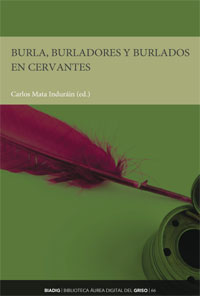 Carlos Mata Induráin (ed.), Burla, burladores y burlados en Cervantes, Pamplona, Publishing Services de la Universidad de Navarra, 2021.
Carlos Mata Induráin (ed.), Burla, burladores y burlados en Cervantes, Pamplona, Publishing Services de la Universidad de Navarra, 2021.
BIADIG Collection (Library Services Áurea Digital), 66 / GRISO Digital Publications.
ISBN: 978-84-8081-714-1
The eight texts that make up this Issue are result of the International congress "Burlas, burladores y burlados en Cervantes", organized by the group of research Siglo de Oro (GRISO) of the University of Navarra with the partnership of the Institute of programs of study Auriseculares (IDEA), which was held, in modality virtual, on December 17-18, 2020. The contributions here agavilladas address, with different approaches and methodologies, various issues related to the trilogy announced in the degree scroll -burlas, burladores y burlados- in different sections of Cervantes' literary work such as Don Quixote ( Enrique Suárez Figaredo), the Novelas ejemplares (Paula Renata de Araújo), the poetry inserted in La Galatea ( Wen-Yuan Chang) and the theater (Horacio José Almada Anderson and Ana Aparecida Teixeira de Souza), but also in some later Cervantes and Quixote recreations such as the Fin de fiesta para la comedia de don Quijote de la Mancha by Juan Vélez de Guevara (Carlos Mata Induráin), the eighteenth-century comedy Las bodas de Camacho by Antonio Valladares de Sotomayor (Santiago López Navia) or the cinematographic Quixotes by Manuel Gutiérrez Aragón (Emmanuel Marigno). These are, logically, partial and punctual approaches, but full of interest, which exemplify the importance of the category of mockery in the vast set of Cervantes' production.
Carlos Mata Induráin, Senior Associate Professor accredited, is researcher and Academic Secretary of group of research Siglo de Oro (GRISO) of the University of Navarra and Secretary of high school of programs of study Auriseculares (IDEA). He is also a correspondent in Spain of the Bolivian Academy of the language Spanish . His lines of research focus on the Spanish literature of the Golden Age (burlesque comedy, Calderón, Cervantes and quixotic recreations, plays about the Arauco War, etc.). He is the author of the literature blog "Ínsula Barañaria".
.
|
Table of contents |
Page |
Download |
|
Carlos MATA INDURÁIN, "presentation". |
7 |
|
|
Horacio José ALMADA ANDERSON, "El espectador burlado: La entretenida de Cervantes, del texto a la recepción del público". |
9 |
|
|
Paula Renata de ARAÚJO, "Rincón y Cortado en una encrucijada de la picaresca cervantina". |
27 |
|
|
Wen-Yuan CHANG, "Mockery in the poetry of La Galatea". |
37 |
|
|
Santiago LÓPEZ NAVIA, "La de Camacho y otras burlas en la comedia dieciochesca Las bodas de Camacho de Antonio Valladares de Sotomayor". |
57 |
|
|
Emmanuel MARIGNO, "Burla, burlados y burladores en los Quijotes de Manuel Gutiérrez Aragón. Linguistic and ideological contexts". |
81 |
|
|
Carlos MATA INDURÁIN, "Mocking Don Quixote and Sancho in the Fin de fiesta for the comedy of Don Quixote de la Mancha(El hidalgo de la Mancha), by Juan Vélez de Guevara". |
113 |
|
|
Enrique SUÁREZ FIGAREDO, "Mentiras, patrañas y pullas: el timo de la bocina, los cuernos de la luna y la caverna espantosa". |
141 |
|
|
Ana Aparecida TEIXEIRA DE SOUZA, "Mockery and theatricality in Cervantes' La cueva de Salamanca ". |
151 |
|
 Carlos Mata Induráin and Miren Usunáriz Iribertegui (eds.), "Labor improbus". conference proceedings of the X congress Internacional Jóvenes Investigadores del Siglo de Oro (JISO 2020), Pamplona, Publishing Services of the University of Navarra, 2021.
Carlos Mata Induráin and Miren Usunáriz Iribertegui (eds.), "Labor improbus". conference proceedings of the X congress Internacional Jóvenes Investigadores del Siglo de Oro (JISO 2020), Pamplona, Publishing Services of the University of Navarra, 2021.
BIADIG Collection (Library Services Áurea Digital), 65 / GRISO Digital Publications.
ISBN: 978-84-8081-713-4
The 23 papers collected in this Issue constitute the conference proceedings of the X Internationalcongress "Jóvenes Investigadores Siglo de Oro" (JISO 2020), which was held in virtual modality , from Pamplona, on December 14-16, 2020, organized by the research group Siglo de Oro (GRISO) of the University of Navarra, in partnership, as in previous editions, with the Instituto de programs of study Auriseculares (IDEA). The meeting, which was attended by 30 young researchers of the Golden Age from five countries, namely Spain, United States, France, Italy and Peru, was structured around nine sessions of communications, dedicated to "Art and commerce", "Indian themes (1)", "Quevedo (1)", "Quevedo (2)", "Polemics and treatises", "16th century", "Theater", "Indian themes (2)" and "De varia lección". As was the case in previous years, there are three notes to be highlighted in this JISO 2020 congress : the international character of its participants; the interdisciplinary approach the meeting; and, of course, the high quality of the papers presented, which the curious reader can enjoy in these conference proceedings, whose degree scroll, Labor improbus, refers to some verses of Virgil: "Labor omnia vicit improbus et duris urgens in rebus egestas" (Georgics, I, 145-146).
Carlos Mata Induráin, Senior Associate Professor accredited, is researcher and Academic Secretary of group of research Siglo de Oro (GRISO) of the University of Navarra and Secretary of high school of programs of study Auriseculares (IDEA). He is also a correspondent in Spain of the Bolivian Academy of the language Spanish . His lines of research focus on the Spanish literature of the Golden Age (burlesque comedy, Calderón, Cervantes and quixotic recreations, plays about the Arauco War, etc.). He is the author of the literature blog "Ínsula Barañaria".
thesis Miren Usunáriz Iribertegui, Master's Degree in Spanish and Latin American Literature at the University of Salamanca, is working on her doctoral thesis at framework del GRISO with a research focused on the use of mockery as a rhetorical, social and political weapon in Golden Age polemics. He has published articles and reviews in indexed journals on the influence of Golden Age literature on contemporary authors and on polemical figures of the 17th century such as José Pellicer. He has made two international stays at research at El high school in Mexico and at the University of Coimbra.
|
Table of contents |
Page |
Download |
|
Carlos MATA INDURÁIN and Miren USUNÁRIZ IRIBERTEGUI, "presentation". |
9 |
|
|
Marta AMIL MARTÍNEZ, "Murillo's painting: atmospheres of faith". |
13 |
|
|
Eva CALVO, "Reflections of the Orient in Royal Collections. The Chinese porcelain of Joan of Austria". |
25 |
|
|
Lucio R. CEBREIRO, "Notas sobre la datación de la Sátira de Valles |
43 |
|
|
Álvaro CUBAS MUSTO, "Extirpación de la idolatría del Pirú (1621): un acercamiento a la monumental obra de Pablo José de Arriaga, S. J." (Extirpation of the idolatry of Pirú (1621): an approach to the monumental work of Pablo José de Arriaga, S. J.). |
55 |
|
|
Jesús DORADO BLANCO, ""Por rescatar la honra, once muertes dejó hechas": mujeres vengadoras del honor en las relaciones de sucesos". |
69 |
|
|
Jean Christian EGOÁVIL, "The Hispanic philosophical foundations of the Franciscan school in the viceroyalty of Peru in the 16th and 17th centuries". |
85 |
|
|
Iván GÓMEZ CABALLERO, ""Yo seré Alejandro Magno, / yo Júpiter el segundo". A mythocritical study of Plutarch's Parallel Lives and Lope de Vega's The Greatness of Alexander ". |
99 |
|
|
Antonia María HERVÁS MOLINA, "La polémica sobre la licitud moral del teatro: un acercamiento a la disputa en torno a 1598". |
115 |
|
|
Alejandro JAQUERO ESPARCIA, "Los fragmentos del Poema de la pintura de Pablo de Céspedes: preludio de la teoría poético-didáctica del arte de la pintura en el Siglo de Oro" (Fragments of the Poem of Painting by Pablo de Céspedes: a prelude to the poetic-didactic theory of the art of painting in the Golden Age). |
127 |
|
|
Samuel LÓPEZ-LINARES, "En torno al retrato de un presuntuoso: el soneto de Quevedo "Esa frente, oh, Gïaro, en remolinos! ("Polimnia", 90)". |
141 |
|
|
Isidro LUIS JIMÉNEZ, "Los Comentarios Reales de los Incas en el contexto de los anticuarios andaluces y de la historiografía española de finales del siglo XVI"(The Royal Commentaries of the Incas in the context of Andalusian antiquaries and Spanish historiography at the end of the 16th century). |
157 |
|
|
Irene MADROÑAL LÓPEZ, "La international outreach del comercio español en el siglo XVII: artículos de lujo y productos medicinales". |
169 |
|
|
Judit MARTÍNEZ CLIMENT, "El alcalde de Zalamea (de la Serena): when a literary work transcends its pages and goes far beyond the text". |
183 |
|
|
Antonietta MOLINARO, ""La del abanillo". Texts and contexts of a traditional song (16th and 17th centuries)". |
197 |
|
|
Manuel MOLINERO RIVERO, "Unity with the whole in fray Luis: controversy over his status as a mystic". |
213 |
|
|
Andrea MUÍÑO, "Una dueña con "manto de hollín" y "tocas de ceniza": la agudeza en speech de todos los diablos de Quevedo" (A duenna with a "mantle of soot" and "tocas de ceniza": the sharpness in of all Quevedo's devils ). |
227 |
|
|
Ariel NÚÑEZ SEPÚLVEDA, "Editando el teatro cortesano de Calderón: hacia una edición crítica de Andrómeda y Perseo" (Editing Calderón's court theatre: towards a critical edition of Andromeda and Perseus). |
241 |
|
|
Samuel PARADA JUNCAL, "The clock motif in Quevedo's satirical and burlesque poetry". |
259 |
|
|
Vicente PUCHADES FERRER, "Narratividad e imaginario en el Auto de fe contra Paula de Eguiluz (Cartagena de Indias, 1623-1636)". |
273 |
|
|
César Félix SÁNCHEZ MARTÍNEZ, "El alcalde, el negro y el fantasma: gramática de un prodigio barroco en la Arequipa del siglo XVII" (The mayor, the black man and the ghost: grammar of a baroque prodigy in 17th century Arequipa). |
287 |
|
|
Luis Tadeo VALVERDE MOLINA, "Triunfal acclamation... : poesía culta y poder virreinal a partir del competition poético convocado por la Real Universidad de San Marcos en alabanza del nuevo virrey, primer marqués de Castelldosrius (Lima, 1707)" (Lima, 1707). |
301 |
|
|
Julio C. VARAS GARCÍA, "The modern prisons of our classics. Towards a critical edition of Audi, filia (1556), by Juan de Ávila". |
311 |
|
|
Sofía VEGA SANTALLA, "Some symbols of eternal love in Quevedo's poetry: the elm, the vine and the ivy". |
325 |
|
 Javier Espejo Surós and Carlos Mata Induráin (eds.), Trazas, ingenio y gracia. programs of study sobre María de Zayas y sus "Novelas amorosas y ejemplares", Pamplona, Publishing Services de la Universidad de Navarra, 2021.
Javier Espejo Surós and Carlos Mata Induráin (eds.), Trazas, ingenio y gracia. programs of study sobre María de Zayas y sus "Novelas amorosas y ejemplares", Pamplona, Publishing Services de la Universidad de Navarra, 2021.
BIADIG Collection (Library Services Áurea Digital), 64 / GRISO Digital Publications.
ISBN: 978-84-8081-694-6
The fascination for María de Zayas, which summons her to the French competitive examinations(Agrégation externe), is not new. It dates back to the mid-17th century, when partial or complete translations of her works into French began to proliferate, both attributed to the author and unnamed, perhaps hidden by her condition as a woman. Constant through the centuries, likewise, is the need, always explicit in any of the editions or programs of study dedicated to her production, to vindicate her talent. The reader will find here a total of twenty-two contributions ready to unravel the prudence in drawing, the wit in pretending and the grace in saying -to use the words of Alonso de Castillo Solórzano- of one of the most singular voices of the European Baroque. This Issue offers some necessary orientations for the understanding and knowledge certain of the historical, linguistic, cultural and literary context in which the honest and entertaining saraos were composed and of most of the questions still disputed to purpose of the known production of the author, so much novels as dramatic, as well as a set of methodological orientations about the feared exercise of the dissertation. These electronic pages constitute, in this way, a solid tool for the critical interpretation of the fundamental aspects of Zayas' work.
Javier Espejo Surós holds a PhD in Hispanic Philology from the Universities of Lleida and Rennes 2 Haute Bretagne qualified to the functions of Senior Associate Professor. He has published editions and programs of study on the theater of the Golden Age, dialogue, sapiential literature and the history of mentalities and systems of representation in the golden age. She is researcher of the Centre d'études Supérieures de la Renaissance (Université de Tours-CNRS-UMR 7323) and of the team "Primer Teatro Clásico Español: Plataforma para la research textual y escénica del Teatro Español del XVI (1496-1542)" (UCM-high school del Teatro). She currently teaches Spanish literature and civilization at the Université Catholique de l'Ouest (Angers).
Carlos Mata Induráin, Senior Associate Professor accredited, is researcher and Academic Secretary of group of research Siglo de Oro (GRISO) of the University of Navarra and Secretary of high school of programs of study Auriseculares (IDEA). He is also a correspondent in Spain of the Bolivian Academy of the language Spanish . His lines of research focus on the Spanish literature of the Golden Age (burlesque comedy, Calderón, Cervantes and quixotic recreations, plays about the Arauco War, etc.). He is the author of the literature blog "Ínsula Barañaria".
|
Table of contents |
Page |
Download |
|
Javier Espejo Surós and Carlos Mata Induráin, "María y el canon (notas a modo de introducción)". |
7 |
|
|
Rafael Bonilla Cerezo and María J. Moreno Prieto, "Toccata y fugas en la novela corta del Barroco". |
11 |
|
|
Alicia Yllera, "María de Zayas y Sotomayor, una escritora sin rostro (vida y semblanza)". |
65 |
|
|
Emre Özmen, "María de Zayas' novels: genre and novelty". |
81 |
|
|
Cristina Tabernero, "La language del Siglo de Oro en la obra de María de Zayas". |
97 |
|
|
Nieves Baranda Leturio, "Women and Writing in the Golden Age". |
113 |
|
|
Rosa Navarro Durán, "Themes and female characters in María de Zayas". |
133 |
|
|
Julián Olivares, "The first Spanish feminist: María de Zayas y Sotomayor". |
153 |
|
|
Mónica Acebedo, "El feminismo y el didacticismo moral de María de Zayas y Sotomayor en el framework que atravesa sus dos colecciones de novelas" (The feminism and moral didacticism of María de Zayas y Sotomayor in the that runs through her two collections of novels). |
177 |
|
|
Sonia Pérez Villanueva, "La violencia de la esclavitud femenina en los Desengaños amorosos de María de Zayas y Sotomayor" (The violence of female slavery in María de Zayas y Sotomayor's Desengaños amorosos ). |
193 |
|
|
Antonina Paba, "El honor restaurado: mujeres vengadoras en las Novelas amorosas y ejemplares de María de Zayas". |
211 |
|
|
Isabel Colón Calderón, "Love and eroticism in Zayas". |
225 |
|
|
María Jesús Zamora Calvo, "La magia amorosa en la narrativa de María de Zayas". |
243 |
|
|
Margaret R. Greer, "The baroque and the living dead: carnal knowledge in the novels of María de Zayas y Sotomayor". |
263 |
|
|
Frederick A. de Armas, "La esclava de su amante y Tarde llega el desengaño de María de Zayas: homenajes a Ana Caro". |
283 |
|
|
Yolanda Gamboa, "Arquitectura y cartografía social en las novelas de María de Zayas" (Architecture and social cartography in the novels of María de Zayas). |
299 |
|
|
Fernando Rodríguez Mansilla, "El castigo de la miseria como novela de burlas"(The Punishment of Misery as a Novel of Mockery). |
317 |
|
|
Victoria Aranda Arribas, "Maravillas de ayer y de hoy: la narrativa de María de Zayas en la televisión". |
337 |
|
|
Alba Urban Baños, "The ladies of the new comedy". |
363 |
|
|
Teresa Ferrer Valls, "La traición en la amistad de María de Zayas: una mirada propia sobre la comedia de capa y espada"(Betrayal in the friendship of María de Zayas: a personal view of the cloak-and-dagger comedy). |
379 |
|
|
Ainhoa Amestoy d'Ors, "Zayas on the Spanish stage". |
393 |
|
|
Daniel Acebes, "El teatro de Zayas en el siglo xxi: La traición en la amistad". |
399 |
|
|
Jean Croizat-Viallet, "La dissertation en l' Agrégation de espagnol. Methodology of the examination through an example. The Novelas amorosas y ejemplares by María de Zayas y Sotomayor". |
417 |
|
Ignacio Arellano, Mariela Insúa and Carmela Pérez-Salazar (eds.), Antología de la literatura burlesca del Siglo de Oro. Issue El "otro" como blanco satírico y burlesco, Pamplona, Publishing Services de la Universidad de Navarra, 2020.
BIADIG Collection (Library Services Áurea Digital), 63 / GRISO Digital Publications.
ISBN: 978-84-8081-695-3
The gaze that each one directs on "the other" is always ambiguous: curious, friendly at times, but almost always cautious, fearful, and therefore aggressive. The other is an unknown territory, and this quality is always a risk. The defensive reaction is therefore frequent, often translated into an attack. One of the weapons - it is not necessary to go as far as physical conflict, although it will occur on occasion - is the word. Against others - for there are many others defined by numerous aspects, anyone who is alien to the observer - mockery, invective, caricature, insult, jocular description, undervaluation are used. In this Issue of the Antología de la literatura burlesca del Siglo de Oro (project FFI2017-82532-P, Identidades y alteridades. La burla como diversión y arma social en la literatura y cultura del Siglo de Oro, funded by the Ministry of Science, Innovation and Universities of the Government of Spain) offers a compilation of texts that mark the figure of the other and bring him the mockery of the more or less archetypal issuer corresponding to a seventeenth-century Spaniard. The selected compositions are grouped into six sections: the other as a political enemy, the other of race and religion, the marginalized other, the cultural and literary other, the geographical other and the deformed other.
Ignacio Arellano is Full Professor of the University of Navarra, where he directs the group de research Siglo de Oro (GRISO), which develops a wide program of research that includes the critical edition of the autos of Calderón and Lope de Vega, the complete theater of Tirso de Molina and Bances Candamo or the publication of La Perinola. Revista de research quevediana and the yearbook Calderoniano.
Mariela Insúa is a researcher and administrative assistant of group de research Siglo de Oro (GRISO) at the University of Navarra and editor of Hipogrifo. Revista de literatura y cultura del Siglo de Oro. A specialist in the work of the Mexican Fernández de Lizardi, she has also published works on the Golden Age, especially on 17th century Spanish-Portuguese theatre.
Carmela Pérez-Salazar is Professor of Spanish language and member of the group de research Siglo de Oro (GRISO) at the University of Navarra. Her current interest researcher focuses on the historical grammar of Spanish and, specifically, on the incorporation of the analysis of speech and pragmatics into the diachronic study of language. As a member of various research projects, his most recent publications have dealt with the analysis of phraseological units in diachrony and the pragmalinguistic study of literary and non-literary sources from the Golden Age.
Carlos Mata Induráin, Antología de la literatura burlesca del Siglo de Oro. Issue Repertorio de notas de las comedias burlescas, Pamplona, Publishing Services de la Universidad de Navarra, 2020.
BIADIG Collection (Library Services Áurea Digital), 62 / GRISO Digital Publications.
ISBN: 978-84-8081-693-9.
In the framework of the Antología de la literatura burlesca del Siglo de Oro (project FFI2017-82532-P, Identidades y alteridades. La burla como diversión y arma social en la literatura y cultura del Siglo de Oro, funded by the Ministry of Science, Innovation and Universities of the Government of Spain), the present Issue offers a repertoire provisional of notes on the burlesque comedies. It includes the notes corresponding to 23 of the burlesque plays already published in the framework of the general project of the group of research Siglo de Oro (GRISO) of the University of Navarra. Despite this partial character, the abundant materials collected here can be useful for the annotation of comic texts and for the location of parallel passages. The curious reader will see that many jokes and puns are repeated from one burlesque comedy to another, and that these resources are shared with other literary modalities such as satirical-burlesque poetry, the entremés or the mojiganga, among others.
Carlos Mata Induráin, Senior Associate Professor accredited, is researcher and Academic Secretary of group of research Siglo de Oro (GRISO) of the University of Navarra. He is also Secretary of high school of programs of study Auriseculares (IDEA, Madrid / New York). His main lines of research are currently focused on the Spanish literature of the Golden Age: burlesque comedy, Calderón's autos sacramentales, Cervantes and the quixotic and Cervantine recreations, plays about the Arauco war, etc. In all these areas he has published several monographs and articles in scientific journals of the specialization program, and has also been publisher of numerous literary works. He maintains the literature blog graduate "Ínsula Barañaria".
Carlos Mata Induráin (coord.), Antología de la literatura burlesca del Siglo de Oro. Issue Comedias burlescas, Pamplona, Publishing Services de la Universidad de Navarra, 2020.
BIADIG Collection (Library Services Áurea Digital), 61 / GRISO Digital Publications.
ISBN: 978-84-8081-692-2.
In the framework of the Antología de la literatura burlesca del Siglo de Oro (project FFI2017-82532-P, Identidades y alteridades. La burla como diversión y arma social en la literatura y cultura del Siglo de Oro, funded by the Ministry of Science, Innovation and Universities of the Government of Spain), the present Issue offers the edition of six burlesque comedies: La más constante mujer (ed. by Alberto Rodríguez Rípodas), Los condes de Carrión ( ed. by Carlos F. Cabanillas Cárdenas), Entremés de Durandarte y Belerma (ed. by Valentina Nider), El más impropio verdugo ( ed. by Elena Di Pinto), El hidalgo de la Mancha (ed. by Carlos Mata Induráin) and Llámenla como quisieren (ed. by Carlos Mata Induráin). These pieces are significant in the corpus under analysis, as well as in their compositional Structures and their parodic mechanisms. By reading them we can see how the burlesque comedies of the Golden Age turn upside down all the schemes in force in the Comedia nueva, to the point of giving rise to a completely degraded universe. This degradation affects equally the dramatic conventions, the lyrical motifs and the construction of the characters. The breakdown of decorum is total in these plays, as well as the inversion of serious values: love, honor, nobility, the bravery of the knights, the beauty of the ladies..., everything is put to shame. In short, the burlesque comedy sample us the other side, ridiculous and carnivalesque, of the tapestry of serious theater.
Carlos Mata Induráin, Senior Associate Professor accredited, is researcher and Academic Secretary of group of research Siglo de Oro (GRISO) of the University of Navarra. He is also Secretary of high school of programs of study Auriseculares (IDEA, Madrid / New York). His main lines of research are currently focused on the Spanish literature of the Golden Age: burlesque comedy, Calderón's autos sacramentales, Cervantes and the quixotic and Cervantine recreations, plays about the Arauco war, etc. In all these areas he has published several monographs and articles in scientific journals of the specialization program, and has also been publisher of numerous literary works. He maintains the literature blog graduate "Ínsula Barañaria".
Carlos F. Cabanillas Cárdenas, Arnulfo Herrera, Fernando Rodríguez Mansilla and Martina Vinatea (eds.), Antología de la literatura burlesca del Siglo de Oro. Issue Burla y sátira en los virreinatos de Indias. Una antología provisional, Pamplona, Publishing Services de la Universidad de Navarra, 2020.
BIADIG Collection (Library Services Áurea Digital), 60 / GRISO Digital Publications.
ISBN: 978-84-8081-688-5.
In this Anthology of the burlesque literature of the Golden Age, undertaken in the framework of the project Identidades y alteridades. La burla como diversión y arma social en la literatura y cultura del Siglo de Oro ( FFI2017-82532-P, MICINN/AEI/FEDER, UE), could not miss the materials that we can call indianos. The Hispanic cultural and literary universe is one, with all the sectorially characteristic elements that one wants, but continuous. There is no excuse for ignoring the literature that is made or refers to the Indies. Considering it as a territory in confrontation with the Peninsula and as an enemy, as a generalized subversive weapon, may obey certain modern ideological postures, but it does not respect the texts, the tradition or the context of production. The present Issue obeys to the attempt to spread some compositions and outstanding authors. It does not pretend to be exhaustive or even to outline a basic systematic panorama, but to show some representative texts in the sphere of the two great viceroyalties. For the Peruvian, the poems of Caviedes and the Ciego de la Merced and the prose texts extracted from chronicles of the Indies constitute a limited but significant example. For the New Spain to the poetic anthology - in which Structures of academic literature or clerical debates are not lacking - a version of the famous scatological opuscule of Quevedo dedicated to the last eye is added, manifestation of the validity of a model like that of Don Francisco, very perceptible also in a poet like Caviedes.
Carlos F. Cabanillas Cárdenas, graduate from the Pontificia Universidad Católica del Perú and PhD from the University of Navarra, currently works as a professor and researcher at the Norwegian Arctic University in Tromsø. His fields of study are the literature of the Golden Age and, in particular, the work of the poet Juan del Valle y Caviedes, whose work he has edited and published several articles.
Arnulfo Herrera has been a professor of Spanish literature of the Golden Age at the National Autonomous University of Mexico since 1978. He is attached to high school de Investigaciones Estéticas, where he works on Mexican literature.
Fernando Rodríguez Mansilla is Senior Associate Professor at Hobart and William Smith Colleges (Geneva, New York). He is the author of the books Picaresca femenina de Alonso de Castillo Solórzano ( 2012) and El Inca Garcilaso en su Siglo de Oro (2019). In addition, he has published works on Cervantes, Quevedo, the picaresque novel, Lope de Vega, María de Zayas and colonial literature.
Martina Vinatea, PhD in Philology Hispanic and History, is Senior Lecturer at the Universidad del Pacífico (Peru) and Co-Director of the Centro de programs of study Indianos (CEI) / project programs of study Indianos (PEI). She is currently researching women's convent poetry and poetry of viceregal Peru.
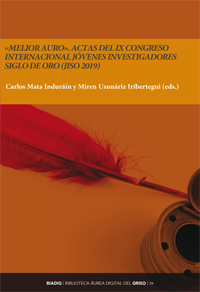
Carlos Mata Induráin and Miren Usunáriz Iribertegui (eds.), "Melior auro". conference proceedings del IX congress Internacional Jóvenes Investigadores Siglo de Oro (JISO 2019), Pamplona, Publishing Services of the University of Navarra, 2020.
BIADIG Collection (Library Services Áurea Digital), 59 / GRISO Digital Publications. ISBN: 978-84-8081-685-4
The twenty-four papers collected in the present Issue constitute the conference proceedings of the IX congress International "Young Researchers Golden Age" (JISO 2019), which was held on December 16-17, 2019 in Pamplona (Navarra), organized by the group of research Golden Age (GRISO) of the University of Navarra. The meeting was structured around twelve sessions of communications, dedicated to "Poetry", "Women and the female world", "Historical themes", "Cervantes", "Theater", "Cooking arts and other treatises", "Narrative", "Quevedo", "Reception of the Golden Age (1)", "Reception of the Golden Age (2)", "Relations of events and literary polemics" and "De varia lección". As was the case in previous years' calls, there are three notes to be highlighted in this congress JISO 2019: the international character of its participants; the interdisciplinary approach of meeting; and, of course, the high quality of the works presented, which the curious reader can enjoy in these conference proceedings, whose degree scroll, Melior auro, abbreviates the Latin maxim "Sapientia melior auro est" 'Wisdom is better (worth more) than gold'.
|
Table of contents |
Page |
Download |
|
Carlos MATA INDURÁIN and Miren USUNÁRIZ IRIBERTEGUI, "presentation". |
9 |
|
|
Weixin BAO, "From Music to Cosmology: An Approach to Fray Luis de León's "Serene Night" and "To Francisco de Salinas"". |
13 |
|
|
Lucio R. CEBREIRO, "Un esbozo de la polémica gongorina en la obra de Lope de Vega: los temas de "Tomé de Burguillos" y su presencia en La Gatomaquia". |
27 |
|
|
Manuel CONTRERAS JIMÉNEZ, "La recepción dieciochesca del Siglo de Oro. An approach from the perspective of travel literature". |
41 |
|
|
José Manuel CORREOSO RODENAS, "Hugh Henry Brackenridge, reader of the Golden Age". |
57 |
|
|
Blandine DAGUERRE, "For a new reading of the interpolated stories in Suárez de Figueroa's work". |
73 |
|
|
Jesús DORADO BLANCO, "El bautismo de los monstruos en las relaciones de sucesos". |
87 |
|
|
Alberto ESCALANTE VARONA, "La "hora navarra" en el teatro de Madrid. The Labiano-Ororbia family and dramatic literature at the end of the 18th century, between the golden tradition and neoclassical modernity". |
103 |
|
|
Marcos GÓMEZ GARCÍA, "The Art of Cooking of Diego Granado: between creativity and plagiarism" " |
115 |
|
|
Alba GÓMEZ DE ZAMORA SANZ, "Las mujeres en la producción artesanal madrileña de los siglos XVI y XVII: entre la teoría y la internship". |
127 |
|
|
Miriam HUÁRRIZ, "Colour in Luis de Góngora's Soledades (1613)". |
139 |
|
|
Maite IRACEBURU JIMÉNEZ, "Tras la huella de la language italiana en el léxico de las relaciones de sucesos (siglo XVII)". |
165 |
|
|
Gaurav KUMAR and Mukesh KUMAR, "Human Values in Cervantes' The colloquium of the Dogs and Premchand's Do Bailon Ki Katha: A Comparative Study". |
181 |
|
|
Irene MADROÑAL LÓPEZ, "The battle paintings of the Salón de Reinos: art as a reflection of technical, political and social innovations in the 17th century army". |
191 |
|
|
Souhila MARKRIA, "The Habsburgs and the Moors: from a repressive policy to a cruel policy". |
203 |
|
|
Pedro MÁRMOL ÁVILA, "Approach to an ongoing process: the critical edition of the Arte para criar seda ( 1581), by Gonzalo de las Casas". |
219 |
|
|
Marta Cristina ORIA DE RUEDA MOLINS, "Cristianos contra turcos: la batalla de Lepanto en la épica hispánica áurea" (Christians against Turks: the battle of Lepanto in the Hispanic golden epic). |
233 |
|
|
Magalí ORTIZ MARTÍN, "La experiencia gastronómica en el siglo XVII: el Arte de cocina de Martínez Montiño". |
249 |
|
|
Samuel PARADA JUNCAL, "The idea of death in Quevedo and Donne". |
263 |
|
|
Noelia SANTIAGO LÓPEZ, "La Cucaña y otras tierras de abundancia en la literatura áurea española". |
277 |
|
|
Cèlia SOLÀ RODRÍGUEZ, ""Y hay fama que se publica / la inocencia castigada / de Herodes Ascalonita". The figure of King Herod in the theatre of Tirso de Molina and Cristóbal Lozano". |
289 |
|
|
Lucía SOUTO ESMORÍS, "Parodia mitológica en la poesía de Quevedo: la fábula de Hero y Leandro" (Mythological parody in Quevedo's poetry: the fable of Hero and Leandro). |
305 |
|
|
Elena TRUAN AGUIRRE, "La edición y los problemas de autoría en El saco de Amberes". |
317 |
|
|
Tadeo VALVERDE MOLINA, ""En que las musas y deidades coronaban a nuestro invicto Felipo": fiesta laudatoria y fidelidad regia en la representación de La púrpura de la rosa ( 1701) a la luz del Diario de noticias sobresalientes en Lima y Noticias de Europa ( 1700-1711)". |
333 |
|
|
Sofía VEGA SANTALLA, ""Alúmbrenme mis llamas y mi fuego": eternidad del amor en Canta sola a Lisi de Quevedo". |
345 |
|
Ignacio Arellano and Mariela Insúa (eds.), Antología de la literatura burlesca del Siglo de Oro. Issue Comedias "de burlas", Pamplona, Publishing Services de la Universidad de Navarra, 2020.
BIADIG Collection (Library Services Áurea Digital), 58 / GRISO Digital Publications. ISBN: 978-84-8081-686-1.
This sixth Issue of the Antología de la literatura burlesca del Siglo de Oro, undertaken in the framework of the project Identidades y alteridades. La burla como diversión y arma social en la literatura y cultura del Siglo de Oro (FFI2017-82532-P, MICINN/AEI/FEDER, UE), is devoted to Comedias "de burlas". This volume gathers in this volume four significant pieces in which degree scroll includes the term and the concept of mockery, although it has been tried to reflect different modalities. There are other comedies "de burlas" in the Golden Age (not to be confused with the comedias burlescas or comedias de disparates, which have their own volume in this general anthology), but these four are sufficiently representative: Ricardo de Turia's(La burladora burlada), which responds to an early and somewhat confused model between comedy of ancient influences, palatine features and others of cloak and dagger, and whose layout reveals some imperfection in the construction of a somewhat premature entanglement; Las burlas veras by Lope de Vega, a good example of a somewhat farcical palatine comedy and a kind of essay for a more complex work and of greater artistic flights as is El perro del hortelano (The dog of the gardener); El burlador de Sevilla, a play with a more serious tone, a masterpiece attributed to Tirso de Molina and that could not be missing in this anthology of mockeries; and, finally, No hay burlas con el amor, a wonderful comedy of cloak and dagger by Calderón, a magnificent example of a playful genre with certain figurative touches in the cultured latiniparla and the commonplace gallant.
Ignacio Arellano is Full Professor of the University of Navarra, where he directs the group de research Siglo de Oro (GRISO), which develops a wide program of research that includes the critical edition of the autos of Calderón and Lope de Vega, the complete theater of Tirso de Molina and Bances Candamo or the publication of La Perinola. Revista de research quevediana and the yearbook Calderoniano.
Mariela Insúa is a researcher and administrative assistant of group de research Siglo de Oro (GRISO) at the University of Navarra and editor of Hipogrifo. Revista de literatura y cultura del Siglo de Oro. A specialist in the work of the Mexican Fernández de Lizardi, she has also published works on the Golden Age, especially on 17th century Spanish-Portuguese theatre.
Victoriano Roncero López (ed.), Antología de la literatura burlesca del Siglo de Oro. Issue Burlas picarescas, Pamplona, Publishing Services de la Universidad de Navarra, 2020.
BIADIG Collection (Library Services Áurea Digital), 57 / GRISO Digital Publications. ISBN: 978-84-8081-678-6.
This fifth Issue of the Antología de la literatura burlesca del Siglo de Oro, undertaken in the framework of the project Identidades y alteridades. La burla como diversión y arma social en la literatura y cultura del Siglo de Oro ( FFI2017-82532-P, MICINN/AEI/FEDER, UE), is devoted to Burlas picarescas. The Spanish picaresque novel continues the humor of the buffoonish literature initiated in Spain in the 15th century by poets such as Villasandino or Antón de Montoro, and continued in the early 16th century by the prose work of Villalobos or don Francés de Zúñiga. From Lazarillo de Tormes onwards, the new genre appropriated the subject of carnivalesque and demystifying humor of the literature of jesters to personify it in the rogue and in his graces and misfortunes. In the present Issue we have tried to present a wide anthology of mockery in several picaresque texts, some of them very well known: Lazarillo de Tormes, Guzmán de Alfarache and El Buscón; others less read, but containing funny episodes of a comicality typical of European carnivals and courts: El Guitón Onofre, La pícara Justina, La segunda parte del Lazarillo by Juan de Luna, Teresa de Manzanares and El high school program Trapaza, by Castillo Solórzano, Lazarillo de Manzanares by Cortés de Tolosa, La desordenada codicia de los bienes ajenos by Carlos García, and, finally, the novel that closes the Issue and the genre of the picaresque-bufonesque novel, the Estebanillo González.
Victoriano Roncero López is Full Professor of Spanish literature in the Department of Hispanic Languages and Literature at Stony Brook University (USA). He is director of IDEA, Hipogrifo, member of GRISO and the Centro para la Edición de los Clásicos Españoles. He has published books on Quevedo's Humanism, his historiographic concept and on humor in the picaresque novel. He has edited an anthology of Castilian cancioneril poetry (with Brian Dutton), the poetry of Fernando de Herrera, an anthology of satirical burlesque poetry of the 16th and 17th centuries (with Ignacio Arellano), Quevedo's muse Clío (with Ignacio Arellano); Quevedo's El Buscón , El tribunal de la justa venganza, Tirso de Molina's La fingida Arcadia, Calderón's El saber del mal y el bien, as well as autos sacramentales by Lope de Vega (La privanza del hombre) and Calderón (El primer blasón del Austria and El lirio y el azucena).
Celsa Carmen García Valdés (ed.), Antología de la literatura burlesca del Siglo de Oro. Issue Entremeses de burlas, Pamplona, Publishing Services de la Universidad de Navarra, 2020.
BIADIG Collection (Library Services Áurea Digital), 56 / GRISO Digital Publications. ISBN: 978-84-8081-677-9.
In the framework of the project Identidades y alteridades. La burla como diversión y arma social en la literatura y cultura del Siglo de Oro ( FFI2017-82532-P MICINN/AEI/FEDER, UE), the first two volumes of the Antología de la literatura burlesca del Siglo de Oro have been devoted to poetry, and the third to prose; the fourth Issue is devoted to the unique theatrical genre of the entremés. Any definition given of this short dramatic piece, in one act, must be accompanied by adjectives such as comic or jocosa or burlesque: comedy is essential to the genre of the entremés. The present Issue contains a set of entremés -one of them unpublished- which, due to their special characteristics, are representative, within the gigantic entremésil world, of a subgenre: entremés de burlas. The central motif of each of the twenty selected pieces is, precisely, a mockery, but it is not just any mockery: it has to be a witty mockery -wit is highly valued by the society of the time-; it has to have a purpose and carry it out; and it has to be inoffensive, eutrapelic. The anthology closes with two more pieces in which the structural mockery, while being ingenious and achieving its goal, does not fulfill the condition of not harming. Thus the reader can compare and see what the difference is between the entremeses de burlas and other entremeses that also have mockery.
Celsa Carmen García Valdés, PhD in Philology Románica, has been Professor of teaching average , Associate Professor at the Universities of Oviedo and Navarra, and Technical Advisor to the Ministry of Education in the Rabat and Buenos Aires delegations. She has been a member of the group de research Siglo de Oro (GRISO) at the University of Navarra since its creation in 1990. As a scholar of Golden Age literature, she has published, between programs of study and critical editions, some thirty books, as well as numerous chapters and articles in collective works and journals of the specialization program.
Fernando Rodríguez Mansilla (ed.), Antología de la literatura burlesca del Siglo de Oro. Issue Prosa de burlas., Pamplona, Publishing Services of the University of Navarra, 2020.
BIADIG Collection (Library Services Áurea Digital), 55 / GRISO Digital Publications. ISBN: 978-84-8081-675-5.
In this Issue, which constitutes the third of the Anthology of the burlesque literature of the Golden Age, undertaken in the framework of the project Identidades y alteridades. La burla como diversión y arma social en la literatura y cultura del Siglo de Oro (FFI2017-82532-P MICINN/AEI/FEDER, UE), offers a bouquet of texts that develop the modality narrative of mockery. Without being exhaustive, but rather representative, we have selected texts and authors who are particularly prominent in this area and who, at the same time, do not have recent annotated editions. The choice of these texts is due to the fact that, together, they make up a varied sample of prose mockery. Thus, the mockers are both men and women, rich and poor, nobles and commoners; among the mocked ones we find old and young, candid girls, shrewd ladies and others of the bad life; the environments move between Seville, Madrid and Barcelona, with characters of diverse social and geographic origin. The reading of these texts, besides being entertaining, can be an invitation to the present-day reader to enter into the festive culture of the Golden Age.
Fernando Rodríguez Mansilla is an associate member of GRISO (group of research Siglo de Oro) and PEI (project programs of study Indianos). He is currently Senior Associate Professor at Hobart and William Smith Colleges (Geneva, New York). He received the award Luis Andrés Murillo for the best article cervantino of 2014 given by the Cervantes Society of America. He is the author of the books Picaresca femenina de Alonso de Castillo Solórzano ( 2012) and El Inca Garcilaso en su Siglo de Oro (2019). In addition, he has published works on Cervantes, Quevedo, the picaresque novel, Lope de Vega, María de Zayas and colonial literature.

Javier Espejo Surós and Carlos Mata Induráin (eds.), Preludio a "La dama boba" de Lope de Vega (historia y crítica), Pamplona, Publishing Services de la Universidad de Navarra, 2020.
BIADIG Collection (Library Services Áurea Digital), 54 / GRISO Digital Publications. ISBN: 978-84-8081-670-0
These pages, offered especially to the intelligence and sensitivity of candidates to the French competitive examinations(Agrégation interne d'espagnol) -but also to anyone interested in the Spanish theater of the Golden Age-, deal with the main lines of the history and criticism of La dama boba. The contributions that make up the Issue offer an interpretation of the fundamental aspects of the portentous theatrical toy due to the pen of Lope de Vega. The following lines of analysis constitute in themselves a state of the question. They try, however, to go beyond the pale summary, the vague panorama, perhaps widening and deepening, even occasionally, the knowledge of the play. There are multiple, perhaps unmanageable, paths to explore the comedy of the Phoenix. We have not tried to cover them all. The aspirants to the prestigious Degree de professeur agrégé will find here some necessary orientations for the understanding and knowledge certain of the work, of the historical, cultural and literary context in which it emerges and of a good part of the main questions still disputed. In any case, nothing replaces the direct contact with a text that is still read with extreme pleasure.
|
Table of contents |
Page |
Download |
|
Javier ESPEJO SURÓS and Carlos MATA INDURÁIN, "Pórtico a un preludio". |
7 |
|
|
María Jesús ZAMORA CALVO, "Imaginaciones racionales: contexto social y cultural en el Siglo de Oro". |
9 |
|
|
Ignacio ARELLANO, "Theatrical life in the Golden Age". |
25 |
|
|
Françoise GILBERT, "instructions for the analysis of the theatre document (methodology in context)". |
55 |
|
|
Felipe B. PEDRAZA JIMÉNEZ, "La dama boba en el contexto de la obra de Lope de Vega". |
79 |
|
|
Gemma BURGOS SEGARRA, "Approximation to the genre of La dama boba". |
97 |
|
|
Fausta ANTONUCCI, "Polymetry in La dama boba: poetic and dramatic functions". |
111 |
|
|
Teresa RODRÍGUEZ, "Understanding and love in La dama boba". |
131 |
|
|
María NOGUÉS BRUNO, "La Education de las mujeres en el Siglo de Oro y los personajes femeninos de La dama boba". |
151 |
|
|
Rosa NAVARRO DURÁN, "Los lenguajes poéticos en La dama boba: Lope de Vega vs. |
171 |
|
|
Carlos MATA INDURÁIN, "La comicidad en La dama boba". |
191 |
|
|
Fernando DOMÉNECH RICO, "El espacio escénico en La dama boba". |
221 |
|
|
Juan AGUILERA SASTRE and Isabel LIZARRAGA VIZCARRA, "La versión de La dama boba de Federico García Lorca". |
237 |
|
|
Juan MAYORGA, "The sex of reason: a reading of La dama boba". |
257 |
|
|
Simone TRECCA, "The film adaptation of La dama boba: Lope as seen by Manuel Iborra". |
269 |
|
|
Javier ESPEJO SURÓS, "La dama boba, inmenso oxímoron (brevísima coda)". |
283 |
|
Ignacio Arellano (ed.), Antología de la literatura burlesca del Siglo de Oro (Anthology of the burlesque literature of the Golden Age). Issue Poesía de los segundones., Pamplona, Publishing Services of the University of Navarra, 2019.
BIADIG Collection (Library Services Áurea Digital), 53 / GRISO Digital Publications. ISBN: 978-84-8081-657-1.
The first Issue of the Antología de la literatura burlesca del Siglo de Oro, undertaken in the framework of the project Identidades y alteridades. La burla como diversión y arma social en la literatura y cultura del Siglo de Oro ( FFI2017-82532-P MINECO/AEI/FEDER, UE), was devoted to the three major names in Golden Age poetry, Lope, Góngora and Quevedo. This second one gathers a selection of those who can be called "second class", in relation to the first ones, and who in turn have different categories (the poetry of Villamediana is not the same as that of Maluenda, for example). Any selection is partial. Surely more names could be added; the poets of transatlantic Spain are excused here, because they will go in a specific Issue destined to the burlesque poetry of the Indian viceroyalties. Other volumes of their own will include texts by women writers and burlesque poetry of jousting and academies. And the same thing that happens with the list of poets can be said of the anthology presented: all the poets included wrote many more poems than those collected in these pages. It is, therefore, one of many possible anthologies. However, the high Degree of codification of the themes and expressive resources -you will notice the reiteration of many jokes, burlesque motifs and puns- makes this selection problem less relevant than it seems, since all these poems are very representative of the genre. The main contribution of this Issue consists of the annotation (about two thousand explanatory notes), which attempts to clarify for a lay reader the innumerable joking references, allusions and games of all kinds subject.
Ignacio Arellano is Full Professor of the University of Navarra, and has been Senior Associate Professor of the University of León and Full Professor of the University of Extremadura, as well as a visitor at numerous universities around the world. He directs the group of research Siglo de Oro (GRISO) of the University of Navarra, where he develops an extensive program of research on the Golden Age, including the project critical edition of the complete works of Calderón de la Barca, the complete theater of Bances Candamo, or the publication of La Perinola. Revista de research quevediana and the yearbook Calderoniano.
Ignacio Arellano (ed.), Antología de la literatura burlesca del Siglo de Oro. Issue Poesía de Lope de Vega, Góngora y Quevedo, Pamplona, Publishing Services de la Universidad de Navarra, 2019.
BIADIG Collection (Library Services Áurea Digital), 52 / GRISO Digital Publications. ISBN: 978-84-8081-645-8.
The universe of mockery in the Golden Age offers many complications and difficulties to the reader and the scholar. Some questions attached to these problems are attempted, if not resolved, at least raised in the project Identidades y alteridades. La burla como diversión y arma social en la literatura y cultura del Siglo de Oro ( FFI2017-82532-P MINECO/AEI/FEDER, UE), in whose framework we have conceived an anthological collection that begins with this Issue. The importance of the three poets contained here merited their placement at the front of the series, which will consist of ten volumes in which poetic, dramatic and narrative texts will be collected, in addition to some other useful instruments to focus on the examination of mockery and its varied dimensions. Indeed, Lope de Vega, Góngora and Quevedo are undoubtedly the three major poets of the Baroque. And if one had to choose three fundamental poetic repertoires of the period, one would have to turn to the Rimas humanas y divinas of Lope's graduate Tomé de Burguillos; to the Chacón manuscript of Góngora's poems; and to the edition of Quevedo's El Parnaso español by José González de Salas. From these three essential sources we have chosen a series of poems characterized by the burlesque approach , abundant in mockery and with an intense satirical component, since in the internship it is impossible to separate these sides of the jocoseria literature, all mixed with mockery and truth, without taking into account that the mockery is not in itself alien to the truth. We hope that this set of materials will provide the reader with the adequate delectare and the no less convenient prodesse.
La famosa comedia de La dama alférez, edition and preliminary study by Gabriel Andrés, Pamplona, Publishing Services de la Universidad de Navarra, 2019.
BIADIG Collection (Library Services Áurea Digital), 51 / GRISO Digital Publications. ISBN: 978-84-8081-643-4.
La dama alférez is an anonymous comedy rarely mentioned in programs of study on Golden Age theatre and almost always in connection with La monja alférez, by Juan Pérez de Montalbán, with which it has been confused. Apart from this fact, almost nothing is known about the play, except that it was included in a "hato" in the possession of the playwright Mateo de Salcedo prior to the date of 25 January 1601 when he sold it along with other theatrical copies - some by Lope de Vega - to another playwright, Andrés de Heredia. The known manuscript copy and the documentation related to the activity of these authors in charge of theatre companies are, for the moment, the only elements that allow us to place the writing of the play at a date prior to 1601, without further details about its actual authorship or its possible staging. It is an urban comedy with an Italian setting that brings to the stage an action set in Naples and interweaves a classic love affair between gallants (Bernardo, the Marquis Arnaldo and Count Urbino) and ladies (Beatrice, Lucrezia and Julia).

Carlos Mata Induráin and Sara Santa Aguilar (eds.), "Ars longa". conference proceedings del VIII congress Internacional Jóvenes Investigadores Siglo de Oro (JISO 2018), Pamplona, Publishing Services of the University of Navarra, 2019.
BIADIG Collection (Library Services Áurea Digital), 50 / GRISO Digital Publications. ISBN: 978-84-8081-637-3
The thirty papers collected in the present Issue constitute the conference proceedings of the VIII congress International "Jóvenes Investigadores Siglo de Oro" (JISO 2018), which was held on December 17-18, 2018 in Pamplona (Navarra), organized by the group de research Siglo de Oro (GRISO) of the University of Navarra. The meeting was structured around twelve sessions of communications, dedicated to "Siglo XVI", "Teatro", "Lope de Vega y la comedia hagiográfica", "Tirso de Molina, Suárez de Figueroa y Quevedo", "Novelas ejemplares", "Góngora y sus comentaristas", "Temas americanos", "Avisos y relaciones de sucesos", "Recepción del Siglo de Oro: 17th-19th centuries", "Reception of the Golden Age: 20th century", "Comparative literature: the Spanish Golden Age in China and India" and "De varia lección". As was the case in previous years' calls for papers, there are three notes to be highlighted in this congress JISO 2018: the international character of its participants; the interdisciplinary approach of meeting; and, of course, the high quality of the works presented, which the curious reader will be able to enjoy in these conference proceedings, whose degree scroll, Ars longa, is taken from the Latin maxim "Ars longa, vita brevis" 'Art [science] is lasting, but life is brief', which translates a phrase from Hippocrates, Aphorisms, I, 1.
|
Table of contents |
Page |
Download |
|
Carlos MATA INDURÁIN and Sara SANTA AGUILAR, "presentation". |
7 |
|
|
Fructuoso ATENCIA REQUENA, "El Fénix Lope de Vega, posible buena guarda de "Margarita la tornera"". |
11 |
|
|
Adriana BELTRÁN DEL RÍO SOUSA, "La obra de Agustín de Salazar y Torres ante la crítica mexicana". |
25 |
|
|
Xinyi CHEN, "Comparative study between Spanish and Chinese literature: 17th century short stories by Juan Pérez de Montalbán and Pu Songling". |
37 |
|
|
María CIMADEVILLA ABADÍE, "La figura de Isabel la Católica en dos comedias lopescas: La hermosura aborrecida y El príncipe perfecto" (The figure of Isabella the Catholic in two Lopesque comedies: The loathed beauty and The perfect prince). |
51 |
|
|
José Manuel CORREOSO RODENAS, "The presence of the Spanish Golden Age in The Southern Literary Messenger (1834-1864)". |
67 |
|
|
Blandine DAGUERRE, "Nuevas pistas de research sobre las composicion es poéticas en El pasajero de Cristóbal Suárez de Figueroa" (New clues from on the poetic compositions in Cristóbal Suárez de Figueroa's El pasajero ). |
79 |
|
|
Jesús DORADO BLANCO, "Aproximaciones metodológicas a la imagen de la mujer en las relaciones de sucesos en los siglos XVI y XVII". |
95 |
|
|
Katarin ESCOLAR REGAIRA, "La iconografía de la transverberación de santa Teresa de Jesús en la comedia hagiográfica teresiana del siglo XVII". |
107 |
|
|
Steven GARCÍA CHALARCA, "Imagen y speech femenino del español clásico al primer español moderno". |
125 |
|
|
Lúa GARCÍA SÁNCHEZ, "Revision of the textual sources of Quevedo's Anacreón Spanish ". |
137 |
|
|
Víctor M. GÓMEZ BLANCO, "La creación del mercado de oficios en Castilla a través de la obra de Castillo de Bobadilla". |
151 |
|
|
Juan Antonio GÓMEZ ZAMORANO, ""Mal haya el que en señores idolatra": Góngora y la sátira juvenalesca". |
165 |
|
|
Maite IRACEBURU JIMÉNEZ, "Aproximación lingüística a la obra de Ana Caro Mallén, autora de relaciones de sucesos". |
173 |
|
|
Gaurav KUMAR and Mukesh KUMAR , "Literary marginal space as a site of hegemonic rupture: critical reflections on The Rogue Justine and Shikanje Ka Dard". |
187 |
|
|
M.ª Eugenia LÓPEZ ANGUIANO, "Un acercamiento al binomio realismo/idealismo en las Novelas ejemplares de Cervantes: La gitanilla in ideorealist perspective". |
199 |
|
|
Isidro Luis JIMÉNEZ, "El uso conjunto de la historia mexica y de elementos cristianos y grecorromanos como estrategia retórica en La historia de la Nueva México de Gaspar Pérez de Villagrá" (The joint use of Mexica history and Christian and Greco-Roman elements as a rhetorical strategy in Gaspar Pérez de Villagrá's La historia de la Nueva México ). |
211 |
|
|
Míriam MARTÍNEZ GUTIÉRREZ, "Texto, música y escena: Hallar la vida en la cueva o un manuscrito de compañía de Los siete durmientes, de Agustín Moreto" (Text, music and scene: Finding life in the cave or company manuscript of Agustín Moreto's Los siete durmientes). |
221 |
|
|
Rafael MASSANET RODRÍGUEZ, "Edición crítica y estudio de la comedia de Tirso de Molina El celoso prudente ( c. 1615)". |
237 |
|
|
Marcella DE MIRANDA, "Making politics in the Golden Age: history and prudence in the work of the ambassador Juan Bautista de Tassis (1540-1609)". |
251 |
|
|
Elena MUÑOZ RODRÍGUEZ, "La escenografía y la tramoya en dos comedias hagiográficas de Lope de Vega: San Diego de Alcalá (1613) y San Nicolás de Tolentino (1614)". |
265 |
|
|
Marta Cristina ORIA DE RUEDA MOLINS, "El Monserrate de Cristóbal de Virués: la presencia de lo maravilloso en la épica hispánica"(The Monserrate of Cristóbal de Virués: the presence of the marvellous in Hispanic epic). |
279 |
|
|
Irene PACHECO MARTÍNEZ, "The European reception of El alcalde de Zalamea: the French versions at the end of the 17th century". |
299 |
|
|
Xavier PETE VEGA, "Approach to the art of speaking well in the Golden Age through the Catalan Jesuit Antonio Martí Alanis (1931-2007)". |
309 |
|
|
Mikel PUGA CHAVES, "Antonio de Aranda at the religious crossroads of the 16th century". |
321 |
|
|
Pilar DE LA ROSA, "Calderón: from Breda to Carthage. Flora and Flavia". |
335 |
|
|
Julio SALVADOR SALVADOR, "Dejes áureos en la poesía de la movida. The case of Fernando Merlo". |
353 |
|
|
Rafael SOTO ESCOBAR, "Géneros informativos, estilo y Structures del notice entre 1618 y 1635". |
367 |
|
|
Eliette SOULIER, "China and Chinese in Castilian dictionaries (1611-1791)". |
381 |
|
|
Lavinia Elena STOLERU, "Cigarrales de Toledo de Tirso de Molina: una miscelánea postcervantina". |
397 |
|
|
Antía TACÓN GARCÍA, "The inversion of myths and literary conventions in El conde Partinuplés, by Ana Caro Mallén". |
405 |
|
J. Enrique Duarte, bibliography crítica sobre el auto sacramental de Lope de Vega, Pamplona, Publishing Services de la Universidad de Navarra, 2018.
ISBN: 978-84-8081-618-2 [Library Services Áurea Digital, BIADIG, 49].
The bibliography critique of Lope de Vega's auto sacramental is intended to be a useful tool for all scholars of the auto sacramental and especially for those interested in the sacramental works written by Lope de Vega. This new tool is part of the project edition of the "Autos sacramentales completos de Lope de Vega", which is being carried out by the GRISO of the University of Navarra and directed by Professor Ignacio Arellano Ayuso, a task that has already begun with the publication in the publishing house Reichenberger of the first volumes and which continues in the attempt to provide critics with correctly edited and annotated texts in volumes of two autos sacramentales.
We would like to make an appeal to all researchers of Lope's sacramental works to provide us with references to new publications on the subject and thus keep this small bibliography up to date with the contributions that are made, committing ourselves to producing new editions of this tool in the future.
This bibliography available , free of charge and in PDF format, allows the search for subjects, works, authors in a very fast way, thus facilitating the task of those interested in this subject. The bibliographic entries contain a short commentary illustrating the content of the reference letter, thus allowing a quick enquiry.
This publication is result of the research carried out at the framework of the project Autos sacramentales de Lope de Vega. Edición, estudio y contexto histórico literario (FFI2013-45388-P), of the Ministry of Industry, Economics and Competitiveness of the Government of Spain.

Ignacio D. Arellano-Torres, Carlos Mata Induráin and Sara Santa Aguilar (eds.), "Docendo discimus". conference proceedings of the VII congress International Young Researchers Golden Age (JISO 2017), Pamplona, Publishing Services of the University of Navarra, 2018.
BIADIG Collection (Library Services Áurea Digital), 38 / GRISO Digital Publications. ISBN: 978-84-8081-621-2.
The thirty-one papers collected in the present Issue constitute the conference proceedings of the VII congress International "Jóvenes Investigadores Siglo de Oro" (JISO 2017), which was held on December 14-15, 2017 in Pamplona (Navarra), organized by the group de research Siglo de Oro (GRISO) of the University of Navarra. The meeting was structured around ten sessions of communications, dedicated to "Lope de Vega", "Calderón", Cervantes' "Novelas ejemplares", "Teatro", "Prosa y poesía", "Mitos y personajes míticos" and "Recepción", plus another three "De varia lección". As was the case in previous years, there are three notes to be highlighted in congress JISO 2017: the international character of its participants; the interdisciplinary approach of meeting; and, of course, the high quality of the works presented, which the curious reader can enjoy in these conference proceedings, whose degree scroll, Docendo discimus, motto of several universities around the world, refers in the last written request to Seneca in one of his letters to Lucilius: "homines, dum docent, discunt"(Epistulae morales, I, 7, 8).
|
Table of contents |
Page |
Download |
|
Ignacio D. Arellano-Torres, Carlos Mata Induráin and Sara Santa Aguilar, "presentation". |
7 |
|
|
María ALFÉREZ SÁNCHEZ, "La poesía religiosa mariana de los alumnos de la Compañía de Jesús en la Provincia de Aragón: estudio y edición". |
11 |
|
|
Marine ANSQUER, "The multiple facets of the narrator in Ginés Pérez de Hita's Guerras civiles de Granada ( 1595 and 1619)". |
23 |
|
|
Laura CARBAJO LAGO, "Breves apuntes sobre la adaptación palaciega de Duelos de amor y lealtad, de Calderón: el manuscrito de la British Library" (Brief notes on the palace adaptation of Calderón's Duels of Love and Loyalty: the British Library manuscript). |
35 |
|
|
María CARBAJO LAGO, "La correlación: un resource estilístico calderoniano en Amado y aborrecido". |
49 |
|
|
Javier CASTRILLO ALAGUERO, "Canon and corpus in Spanish Golden Age theatre". |
61 |
|
|
María CIMADEVILLA, "Lope de Vega's Hero: The Greatness of Alexander". |
81 |
|
|
Aina M. ESCOBAR SÁNCHEZ, "Ceremonials and diaries. An example from the 17th century in Mallorca: the Ceremonial of file". |
91 |
|
|
Laura FARÍAS MUÑOZ, "Patron saint images in Hapsburg Barcelona". |
101 |
|
|
Lúa GARCÍA SÁNCHEZ, "The translator of the Polish version of Quevedo's Politics of God ". |
111 |
|
|
Juan Antonio GÓMEZ ZAMORANO, "Lope de Vega and Góngora: two different receptions of the same myth". |
123 |
|
|
Francisco Javier GONZÁLEZ CANDELA, "A recurring motif in Cervantes: poison in the Novelas ejemplares". |
136 |
|
|
Laura HERNÁNDEZ GONZÁLEZ, "Problematics surrounding the sub-genre of the historical comedy: the case of Calderón de la Barca's Las armas de la hermosura". |
147 |
|
|
Maite IRACEBURU JIMÉNEZ, "Relación del "Matusalén de las Indias de Portugal" (1664). Linguistic study". |
159 |
|
|
Laura JUAN MERINO, "La transformación del mito donjuanesco en Calderón: análisis comparativo entre el personaje tirsiano con No hay cosa como callar y La niña de Gómez Arias" (The transformation of the Don Juan myth in Calderón: comparative analysis between the Tirsian character with No hay cosa como callar and The Girl by Gómez Arias). |
181 |
|
|
Gaurav KUMAR and Mukesh KUMAR, "Autobiographical Voices from the Margins: A Comparative Study of Francisco López de Úbeda's La pícara Justina and Kausalya Baisantri's Dohra Abhishaap ". |
195 |
|
|
M.ª Eugenia LÓPEZ ANGUIANO, "Internal structure, dramatic spaces and symbolic motifs in Lope de Vega's El caballero de Olmedo ". |
203 |
|
|
Isidro LUIS JIMÉNEZ, "Aristotelismo y tomismo en la Loa a los años del Reverendísimo Padre Maestro fray Diego Velázquez de la Cadena, de sor Juana Inés de la Cruz". |
215 |
|
|
Jorge MARTÍN GARCÍA, "Relato caballeresco y speech historiográfi co: el entrelazamiento en La pris ión del rey de Francia de Gonzalo Fernández de Oviedo" (Chivalric tale and historiographical : the interweaving in Gonzalo Fernández de Oviedo's La prisión del rey de Francia ). |
221 |
|
|
Rafael MASSANET RODRÍGUEZ, "From the text to the stage: the staging of Tirso de Molina's El celoso prudente ". |
235 |
|
|
Clara MONZÓ, ""Quien, subiendo, se despeña": scenic and poetic uses of a ladder in La devoción de la cruz". |
247 |
|
|
Marta Cristina ORIA DE RUEDA MOLINS, "Don Quijote de la Mancha: el tránsito del ideal caballeresco al soldado español del Quinientos" (Don Quijote de la Mancha: the transition from the chivalric ideal to the Spanish soldier of the 16th century). |
257 |
|
|
Laura PAZ RESCALA, "instructions para una research sobre el teatro virreinal peruano del siglo XVI: la Villa Imperial de Potosí". |
267 |
|
|
Iria PIN MOROS, "Ideas on style in Mateo Alemán's Castilian Orthography ". |
279 |
|
|
María REDONDO GUTIÉRREZ, "Towards the renewal of the Byzantine novel: Cervantes' Liberal Lover ". |
291 |
|
|
Edimilson Moreira RODRIGUES, "Los poderes de la palabra. project de research del corpus de las categorías literarias del Siglo de Oro español". |
303 |
|
|
Julio SALVADOR SALVADOR, "The character of Saint Teresa in two plays attributed to Lope de Vega". |
325 |
|
|
Óscar SANTOS PRADANA, "Metric, rhythm and rhetorical figures in three poems by Saint John: Spiritual Canticle, Dark Night and Living Flame of Love". |
337 |
|
|
Maria Agostina SARACINO, "Historia y (verdadera) razón de Estado en la enquiry de García de Loaysa y Girón, Diego de Yepes y Diego de Córdoba (1598)". |
351 |
|
|
Miren USUNÁRIZ IRIBERTEGUI, "Huellas gongorinas en la "Soledad insegura" de García Lorca". |
363 |
|
|
Leticia VIÑUELA SOTO, "Knowing Cubillo: towards the critical edition of El rayo de Andalucía (part one) by Álvaro Cubillo de Aragón". |
375 |
|
|
Martín ZULAICA LÓPEZ, "Menéndez Pelayo, Octavio Viader and Bernardo de Balbuena. Some notes on literary historiography and a bibliographical finding ". |
387 |
Pedro Calderón de la Barca, El nuevo palacio del Retiro, electronic edition by Jesús M. Usunáriz, Pamplona, Publishing Services of the University of Navarra, 2018.
BIADIG Collection (Library Services Áurea Digital), 47 / GRISO Digital Publications. ISBN: 978-84-8081-598-7
This edition of El nuevo palacio del Retiro by Pedro Calderón de la Barca is based on the 1998 edition (Kassel, Reichenberger) by Alan K. G. Paterson as regards the textual fixation of this auto sacramental. For an in-depth study and analysis, we refer to Paterson's critical study, and to the different contributions of authors such as Ignacio Arellano, Dominique Reyre and Margaret Greer, among others mentioned throughout the text.
The novelty of this critical edition lies in two elements. One is the annotation, which has been completely replaced and can be seen as an addition to the aforementioned Paterson edition. This new annotation is intended to clarify some questions that remained doubtful, as well as to establish a comparison between the ideas conveyed by Calderón and other authors of his time, whether they were theologians, historians or treatises of various kinds. In our opinion, the opinions reflected demonstrate the consonance between our playwright and the theological currents and opinions of his time.
The second element is the electronic edition of the auto, which turns the auto into a multimedia publication that allows, among other elements, access to most of the ancient texts cited in grade, the contemplation of works of art (paintings, engravings...) or musical compositions that reflect these same ideas or contribute to a better understanding of them. The edition of the auto, available in PDF, ePub and Mobi formats, thus offers other possibilities for reading the auto, adapted to new media, to which it adds its interactivity, with a simple and accessible hypertext, within challenge that the new perspectives and possibilities of the Humanities Digital offer.
This publication is part of the activities of project "Autoridad y poder en el teatro del Siglo de Oro. Estrategias, géneros, imágenes en la primera globalización" (FFI 2014-52007-P) funded by the Ministry of Industry, Economics and Competitiveness of the Government of Spain.
Lorenzo de las Llamosas, También se vengan los dioses, preliminary study by José A. Rodríguez Garrido, edited by Javier de Navascués and Martina Vinatea, Pamplona, Publishing Services of the University of Navarra, 2018.
BIADIG Collection (Library Services Áurea Digital), 46 / GRISO Digital Publications. ISBN: 978-84-8081-596-3
Lorenzo de las Llamosas offers the text of También se venganse los dioses to the Count of Monclova, viceroy in Lima after having served as position in New Spain. The festejo is a multiple appellative act. Insofar as court theatre was part of the ceremonies and symbolic elaborations that served to exalt the figure of authority, Llamosas's play offered the viceroy an instrument of affirmation of his power. His manuscript, in this sense, invited the viceroy to order its immediate staging by providing him with the complete design of the fiesta (loa, comedia, entremés); the annotations carefully detailed the displays of machinery and scenery; the means for its staging were provided by the experience of the preceding years and by the existence in Lima of a portable theatre for spectacle comedies where that experience had taken shape; the musicalisation of the work could be entrusted to the maestro de capilla of Lima Cathedral, Tomás de Torrejón y Velasco, whose experience with court drama had possibly already been put to test. This work thus reflects a complex theatrical internship typical of the courtly sphere in America, and brings together aesthetic and political aspects in a construction worthy of reading and analysis.
This publication is part of the activities of project programs of study Indianos (PEI), of the University of the Pacific and the University of Navarra.
Pedro Lanini Sagredo, La restauración de Buda. Auto sacramental alegórico, edited by Ignacio Arellano, Pamplona, Publishing Services de la Universidad de Navarra, 2017.
BIADIG Collection (Library Services Áurea Digital), 45 / GRISO Digital Publications. ISBN: 978-84-8081-592-5.
The capture of Buda by the Holy League against the Turks in 1686 was an event of enormous political significance throughout Europe, prompting the writing of many pages describing the events, extolling the Christian protagonists and singing of the heroes' exploits. One of the works that deals with it is this auto by Lanini, one of whose fundamental objectives, related to the historical circumstances of the writing, is the celebration of an imperial Christian success, and the exaltation of the House of Austria, whose mythologised role as defender of the faith and guide of Christian civilisation constitutes the central support of the piece.
Francisco Antonio Bances Candamo, El esclavo en grillos de oro, philological edition by Ignacio Arellano and electronic edition by Jesús M. Usunáriz, Pamplona, Publishing Services of the University of Navarra, 2017.
BIADIG Collection (Library Services Áurea Digital), 44 / GRISO Digital Publications. ISBN: 978-84-8081-574-1.
Bances Candamo can be considered the last important representative of Baroque theatre. Restricted to the court, where he played the role of official playwright, position , his themes, perspectives, style and dramatic techniques are marked by the limitations of the audience he addresses. We are now far from the multiple exploration that opened up with the figure of Lope de Vega and culminated in the vast and varied work of Calderón. This specific reduction to the stage and palace audience offers a privileged opportunity to analyse a particular horizon of expectations defined with great clarity and extremely homogeneous, which marks Bances' writing with the full awareness and decision of the poet, constituted as a kind of courtly advisor through certain genres of comedy.
El GRISO has been engaged for some time in the study and edition of Bances' work and also in the analysis of the manifestations of power and authority in the Golden Age theatre. This edition of El esclavo en grillos de oro responds precisely to the intersection of both lines of research and aims to provide interested readers with a text that is as reliable as possible, with a functional apparatus of notes and a presentation that pays particular attention to the aspects of authority and power, especially the doctrine of the art of good government and the denunciation of the tyrant ruler, without forgetting the discussion - usual in the bibliography on Bances - about the possible interpretations in core topic of the comedy and its relationship with political circumstances at the court of Charles II.
The philological edition (also published in print in IDEA's Batihoja collection) was produced by Ignacio Arellano. The digital version, in its varieties, and with its visual and sound elements, is the responsibility of Jesús M. Usunáriz.
Armine Manukyan, Study and critical edition of two plays by Alonso Jerónimo de Salas Barbadillo: "El necio bien afortunado" and "El sagazaz Estacio, marido examinado", Pamplona, Publishing Services of the University of Navarra, 2019.
BIADIG Collection (Library Services Áurea Digital), 43 / GRISO Digital Publications. ISBN: 978-84-8081-572-7.
This Issue, after reviewing the life and varied production of Alonso Jerónimo de Salas Barbadillo, offers a critical and annotated edition of two interesting texts from his literary corpus: the novel El necio bien afortunado and the "prose comedy" El sagazaz Estacio, marido examinado. To date, both titles lacked critical and annotated editions at Spanish and needed urgent update and textual purification. They are two works that stand out for their high aesthetic value and their satirical-costumbrist character, true jewels from the sociohistorical and linguistic point of view because they reflect the courtly customs of the time (17th century), form a unit for the satirical setting, and also give a very comprehensive view of the cultural, social, artistic and linguistic panorama of the time. All of this is expressed in a typically baroque language that today requires a solid annotation.
Francisco de Quevedo, Cómo ha de ser el privado, edition and study by Ignacio Arellano, Pamplona, Publishing Services of the University of Navarra, 2017.
BIADIG Collection (Library Services Áurea Digital), 42 / GRISO Digital Publications. ISBN: 978-84-8081-573-4.
This only surviving comedy by Quevedo is a piece of circumstance and an example of literature from core topic, which reflects historical characters and events with a dramatic mask that is quite transparent in its most notable features. His topic belongs, roughly speaking, to the political and courtly sphere, in its evocation of a perfect privateer such as Olivares, at least in the first stages of the relationship between the minister and the writer. Later Quevedo would become a radical opponent of the privateer.
The present edition has a different approach and objectives than a conventional critical edition, such as the one already done by Ignacio Arellano and Celsa Carmen García Valdés in the Issue of Teatro completo de Quevedo ( Madrid, Chair, 2011). Here we present a digital edition for the eventual use of a wider audience, not strictly Quevedoists, which adds a series of visual and sound materials capable of evoking certain elements of the time in which the work was written.
Pliegos de "relaciones de comedia" en Cerdeña: I. Leefdael's workshop, edition and preliminary study by Gabriel Andrés, Pamplona, Publishing Services of the University of Navarra, 2017.
BIADIG Collection (Library Services Áurea Digital), 41 / GRISO Digital Publications. ISBN: 978-84-8081-569-7.
Edition and study of the first "relaciones de comedia" produced in the Sevillian workshop of Leefdael at the end of the Golden Age (1717-1733), according to the testimonies preserved in the rich collection of the Library Services University of Cagliari (Sardinia), which constitutes an early sample of bibliographic collecting of these peculiar pieces of string literature. It is an assortment of texts in romance form, printed on single sheets, which allows us to appreciate, even outside the borders of the Iberian Peninsula, the reception of cultural practices derived from the Golden Age theatre that were not sufficiently known and studied, in this case in a Sardinia that was already distant from the Hispanic dominions but still attentive to its cultural manifestations.
Anonymous, Los agravios satisfechos del Desengaño y la Muerte, ed. and study by Carlos Mata Induráin, Pamplona, Publishing Services of the University of Navarra, 2017.
BIADIG Collection (Library Services Áurea Digital), 40 / GRISO Digital Publications. ISBN: 978-84-8081-349-5.
Los agravios satisfechos del Desengaño y la Muerte, colloquium moral on the occasion of the canonisation of Saint Francis Borgia, is an anonymous work - sometimes mistakenly attributed to Luis de Fuenmayor - which has an allegorical structure similar to that of the autos sacramentales, insofar as the characters involved, along with Death and Disenchantment alluded to in degree scroll, are the Church, the World, Humility, the Devil, Pleasure, as well as St. Francis of Borgia and the Society of Jesus itself. The literary quality of this play is not A, but it is very interesting in the context of Jesuit hagiographic theatre, and specifically that dedicated to St. Francis Borgia. Throughout colloquium there is an abundance of clichés related to disillusionment and vanitas, since what is dramatised here is the transformation of the Duke of Gandía after noticing in the decomposed corpse of the Empress Isabella of Portugal, the wife of Charles V (who died in 1539), the expiry of all human beauty. After this shock to his conscience, and after the death of his wife Leonor de Castro, which occurred years later, in March 1546, Francisco de Borja y Aragón decided to abandon all riches, honours and worldly finery to enter the Society of Jesus.
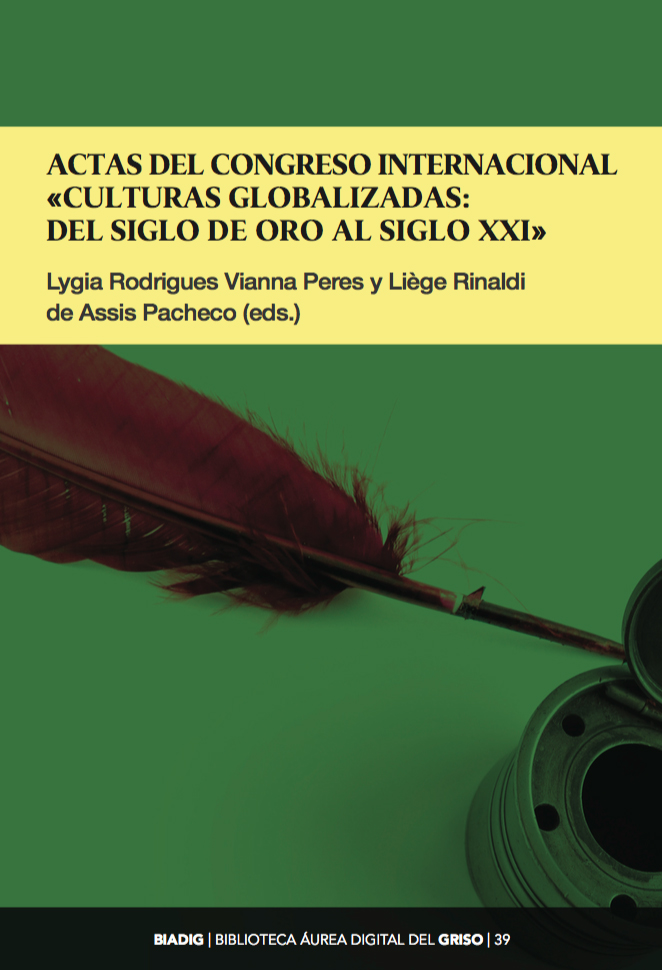 Lygia Rodrigues Vianna Peres and Liège Rinaldi de Assis Pacheco (eds.), conference proceedings of the International congress "Globalised Cultures: from the Golden Age to the 21st Century".", Pamplona, Publishing Services of the University of Navarra, 2017.
Lygia Rodrigues Vianna Peres and Liège Rinaldi de Assis Pacheco (eds.), conference proceedings of the International congress "Globalised Cultures: from the Golden Age to the 21st Century".", Pamplona, Publishing Services of the University of Navarra, 2017.
BIADIG Collection (Library Services Áurea Digital), 39 / GRISO Digital Publications. ISBN: 978-84-8081-558-1.
The Internationalcongress "Globalized Cultures: from the Golden Age to the 21st Century" was held July 6-8, 2015 at the Universidade Federal Fluminense, Campus do Gragoatá (Niterói-Rio de Janeiro, Brazil). The organizers, the Programa de Pós-Graduação em Estudos de Literatura of the Universidade Federal Fluminense, the group de research Siglo de Oro (GRISO) of the University of Navarra and the Instituto de programs of study Auriseculares (IDEA), are pleased to present the conference proceedings of the congress in digital version published in the collection BIADIG-Library Services Áurea Digital of the GRISO. Some fifty researchers from eleven countries participated in this meeting, which was conceived as a fine-tuning of the programs of study of the Golden Age - a first global era - in the modern global era: Argentina, Brazil, Chile, Colombia, France, India, Italy, Mexico, Puerto Rico, Spain, the United States and the United States. The various round tables and panels dealt with Cervantes and Don Quixote, Quevedo, Calderón de la Barca, picaresque novels, Golden Age theater, religious and moral literature, and other issues related to authority and power, cultural identity and translation. It also analyzed various recreations of themes and characters from the Spanish Golden Age in several modern and contemporary literatures of Ibero-America. This Issue contains a selection of twenty-eight of the papers presented, including a section dedicated to Cervantes and Quvedo echoes in contemporary Colombian literature.
|
Table of contents |
Page |
Download |
|
grade Preliminary |
13 |
|
|
ESTER ABREU VIEIRA DE OLIVEIRA |
15 |
|
|
SILVIA GUADALUPE ALARCÓN SÁNCHEZ |
31 |
|
|
CELIA MABEL BURGOS ACOSTA |
45 |
|
|
ANDREA CESCO |
59 |
|
|
ANTONIO VALMARIO COSTA JUNIOR |
69 |
|
|
HUGUES DIDIER |
83 |
|
|
MARIBEL ESPINOSA GONZÁLEZ |
103 |
|
|
PABLO GARCÍA PIÑAR |
115 |
|
|
HILAIRE KALLENDORF |
127 |
|
|
DORIAN LUGO BERTRÁN |
141 |
|
|
MARÍA DE LOS ÁNGELES SILVINA MANZANO AÑORVE |
159 |
|
|
VIBHA MAURYA |
165 |
|
|
ARIEL NÚÑEZ SEPÚLVEDA |
177 |
|
|
MARGARITA PEÑA |
189 |
|
|
ROBERTO PONCIANO GOMES DE SOUZA JÚNIOR |
201 |
|
|
LUIZ FERNANDO QUEIROZ MELQUES |
219 |
|
|
LIÈGE RINALDI |
227 |
|
|
LYGIA RODRIGUES VIANNA PERES |
241 |
|
|
JUVENTINA SALGADO ROMÁN |
255 |
|
|
ANA APARECIDA TEIXEIRA DE SOUZA |
267 |
|
|
DANIELLE THEODORO OLIVIERI |
281 |
|
|
VIJAYA VENKATARAMAN |
295 |
DON QUIXOTE DE LA MANCHA AND FRANCISCO DE QUEVEDO IN CONTEMPORARY COLOMBIAN LITERATURE
Coord. Jorge Ladino Gaitán Bayona
|
|
Page |
Download |
|
DANNY PATRICIA CRUZ OLIVEROS |
311 |
|
|
JORGE LADINO GAITÁN BAYONA |
321 |
|
|
CARLOS ARTURO GAMBOA BOBADILLA |
331 |
|
|
ELMER JEFFREY HERNÁNDEZ ESPINOSA |
345 |
|
|
DANIELA MELO MORALES |
359 |
|
|
NELSON ROMERO GUZMÁN |
371 |
 Carlos Mata Induráin and Sara Santa Aguilar (eds.), "Posside sapientiam". conference proceedings of the VI congress International Young Researchers of the Golden Age (JISO 2016), Pamplona, Publishing Services of the University of Navarra, 2017.
Carlos Mata Induráin and Sara Santa Aguilar (eds.), "Posside sapientiam". conference proceedings of the VI congress International Young Researchers of the Golden Age (JISO 2016), Pamplona, Publishing Services of the University of Navarra, 2017.
BIADIG Collection (Library Services Áurea Digital), 38 / GRISO Digital Publications. ISBN: 978-84-8081-546-8.
The twenty-two papers collected in the present Issue constitute the conference proceedings of the VI congress International "Young Researchers Golden Age" (JISO 2016), which was held on December 19-21, 2016 in Pamplona (Navarra), organized by the group of research Golden Age (GRISO) of the University of Navarra. The meeting was structured around nine sessions of communications: two dedicated to "Cervantes", two others to "Theater" and other tables on "Prose", "American themes", "Characters", "History and historiography" and "De varia lección". As was the case in previous years, there are three main features that stand out in congress JISO 2016: the international character of its participants; the interdisciplinary approach of meeting; and, of course, the high quality of the works presented, as will be seen in these conference proceedings, whose degree scroll, Posside sapientiam, refers to Proverbia, 16, 16, in the Sacra Vulgata Bible: "posside sapientiam quia auro melior est et adquire prudentiam quia pretiosior est argento".
|
Table of contents |
Page |
Download |
|
CARLOS MATA INDURÁIN and SARA SANTA AGUILAR "presentation" |
5 |
|
|
ROCÍO ALONSO MEDEL |
7 |
|
|
LIDIA BELTRÁN MARTÍNEZ |
19 |
|
|
ÁLVARO BUENO BLANCO |
33 |
|
|
GEMMA BURGOS SEGARRA |
47 |
|
|
JOSÉ MANUEL CORREOSO RODENAS |
59 |
|
|
AMIRA DEBBABI |
71 |
|
|
AMÉLIE DJONDO DROUET |
79 |
|
|
MARCOS GARCÍA BARRERO |
93 |
|
|
LAURA HERNÁNDEZ GONZÁLEZ |
105 |
|
|
LAURA JUAN MERINO |
117 |
|
|
MUKESH KUMAR |
127 |
|
|
ISIDRO LUIS JIMÉNEZ |
133 |
|
|
RUBÉN MARTÍNEZ AZNAL |
143 |
|
|
RAFAEL MASSANET RODRÍGUEZ |
157 |
|
|
CLARA MONZÓ |
169 |
|
|
EVA PEREIRA RIVERA |
181 |
|
|
IRIA ISABEL PIN MOROS |
193 |
|
|
AUDE PLOZNER |
205 |
|
|
ESMERALDA SÁNCHEZ PALACIOS |
217 |
|
|
MARION VIDAL |
229 |
|
|
KARUNA WARRIER |
239 |
|
|
ANE ZAPATERO MOLINUEVO |
Juan de Montenegro y Neira, La toma de Buda. Auto historial sacramental, ed. Ignacio Arellano, Pamplona, Publishing Services de la Universidad de Navarra, 2017.
BIADIG Collection (Library Services Áurea Digital), 37 / GRISO Digital Publications. ISBN: 978-84-8081-557-4.
Juan de Montenegro y Neira wrote this play in celebration of the capture of Buda by the imperial troops, who liberated it from Turkish rule in 1686. He dedicates it to the queen mother and conceives it in large part as an exaltation of the House of Austria, an advocation of Catholic religious union in the face of Discord, and an expression of the unity of monarchy and Church. The goal of celebration defines the auto as a work of circumstances, which is little different from a comedy with moral figures in the line of other plays written on the same occasion of the taking of Buda, which had so much echo in its time. Montenegro does not show a special capacity for allegorical structuring, but the piece is significant of the impact of the occasion celebrated throughout the Catholic world at the end of the 17th century. Also published in this Issue are the accompanying pieces (loa, entremés and mojiganga) that constitute a complete sacramental feast.
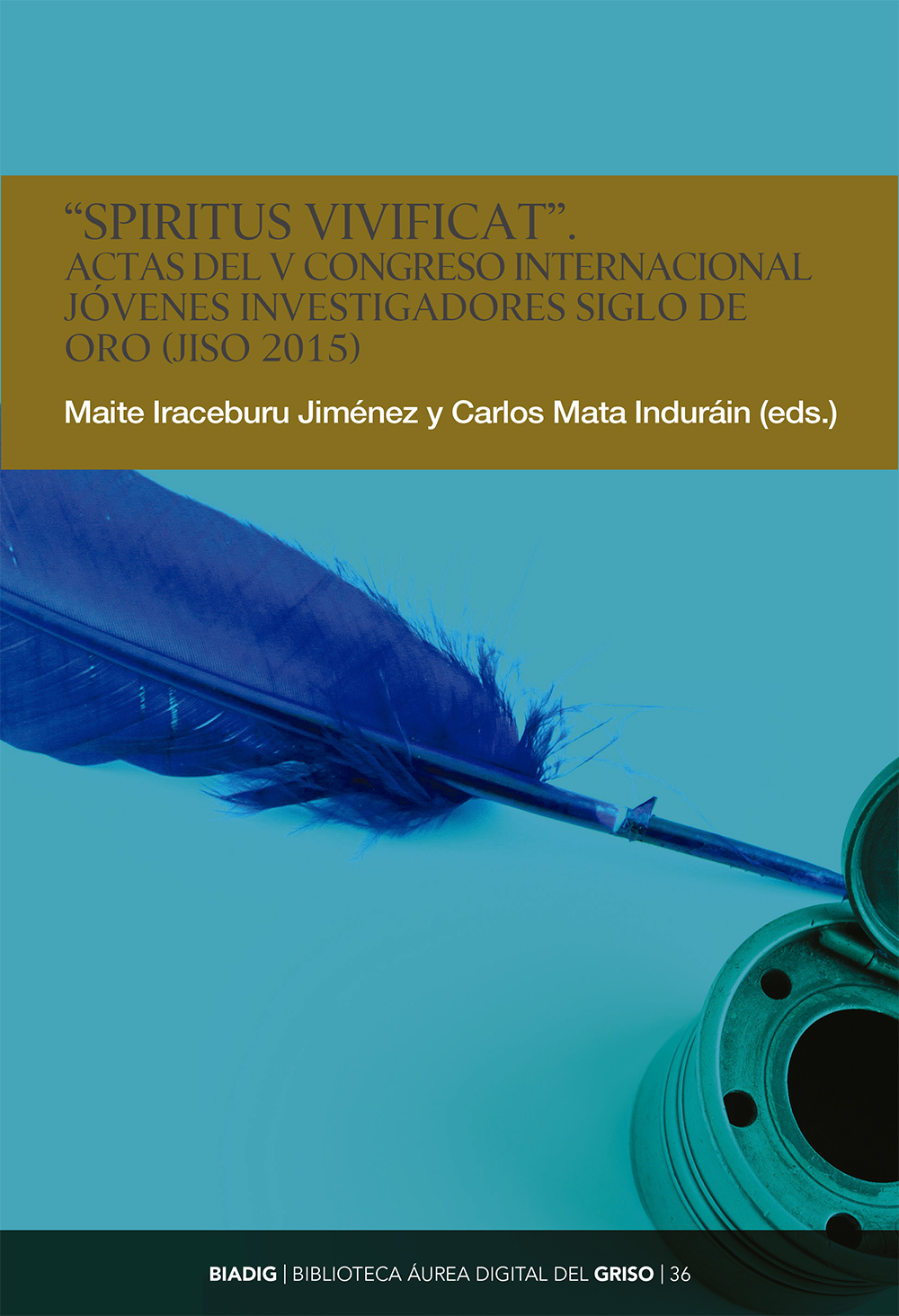 Maite Iraceburu Jiménez and Carlos Mata Induráin (eds.), "Spiritus vivificat". conference proceedings of the V congress International Young Researchers of the Golden Age (JISO 2015), Pamplona, Publishing Services of the University of Navarra, 2016.
Maite Iraceburu Jiménez and Carlos Mata Induráin (eds.), "Spiritus vivificat". conference proceedings of the V congress International Young Researchers of the Golden Age (JISO 2015), Pamplona, Publishing Services of the University of Navarra, 2016.
BIADIG Collection (Library Services Áurea Digital), 36 /GRISO Digital Publications. ISBN: 978-84- 8081-524-6.
The twelve papers collected in the present Issue constitute the conference proceedings of the V International congress "Jóvenes Investigadores Siglo de Oro" (JISO 2015), which was held on July 27 and 28, 2015, in Olite and Pamplona (Navarra), organized by the group de research Siglo de Oro (GRISO) of the University of Navarra. The meeting was structured around four sessions of communications: one dedicated to "Theater", another to "Lyric" and two more "De varia lección". As was the case in previous years, there are three main features that stand out in congress JISO 2015: the international character of its participants; the interdisciplinary approach of meeting; and, of course, the high quality of the works presented, as can be seen in these conference proceedings -whose degree scroll, Spiritus vivificat, refers ultimately written request to the passage of St. Paul, Epistle to the Corinthians, II, 3, 6: "Littera enim occidit, spiritus autem vivificat".
|
Table of contents |
Page |
Download |
|
MAITE IRACEBURU JIMÉNEZ and CARLOS MATA INDURÁIN |
5 |
|
|
PAOLO CABONI |
7 |
|
|
JESÚS EGUÍA ARMENTEROS |
19 |
|
|
DEBORAH FORTEZA |
33 |
|
|
VERÒNICA GUILLÉN ALBERT |
43 |
|
|
MANUEL LÓPEZ FORJAS |
55 |
|
|
RAQUEL LÓPEZ SÁNCHEZ |
69 |
|
|
RAFAEL MASSANET |
83 |
|
|
EUGENIA MAZUR |
97 |
|
|
MARÍA FRANCISCA PASCUAL FERNÁNDEZ |
111 |
|
|
MANUEL PINO LEÓN |
119 |
|
|
MARIONA SÁNCHEZ RUIZ |
137 |
|
|
SILVIA ALEXANDRA STEFAN |
149 |
 Mariela Insúa (ed.), Models of life and culture in Navarre (16th and 17th centuries). Anthology of texts, Pamplona, Publishing Services of the University of Navarra, 2016.
Mariela Insúa (ed.), Models of life and culture in Navarre (16th and 17th centuries). Anthology of texts, Pamplona, Publishing Services of the University of Navarra, 2016.
BIADIG Collection (Library Services Áurea Digital), 35 / GRISO Digital Publications. ISBN: 978-84-8081-489-8.
This Issue is part of a project of research, developed by the GRISO, which focuses on the analysis of groups, estates and figures core topic of the history and culture of Navarre in the early modern period. The goal of these pages is to offer an anthology that serves as a complement to another book (Modelos de vida y cultura en la Navarra de la Modernidad temprana, ed. Ignacio Arellano), elaborated by the same team, which gathers critical articles on these topics in the same period.
The texts collected here provide, from an interdisciplinary point of view, different approaches to various "models of life and culture". Thus, for example, they include pieces alluding to the literary portrayal of Saint Francis Xavier - the Navarrese saint and his representation in short dramatic dialogues of the Society of Jesus - (at position by Ignacio Arellano); and also rhetorical portraits, or inserted in the chronistic speech , referring to the adventurer Pedro de Ursúa in his relationship with other contemporaries such as Fernando de Guzmán and Lope de Aguirre (by Ignacio Arellano and Álvaro Baraibar). For the exemplification of the literary models in force in the Navarre of early modernity, which are those of the Golden Age, an anthology is included which includes a list of 19 authors and a total of 110 compositions (edited by Carlos Mata Induráin). On the other hand, in the context of the insults that make reference letter to anti-modern figures, Cristina Tabernero and Jesús M. Usunáriz extract from different documentary sources several testimonies of the terms bruja, brujo, hechicera, hechicero and sorgin corresponding to Navarre in the 16th and 17th centuries; this selection of voices is preceded by an introductory study from a historical and linguistic approach.
The Issue is completed with a projection towards the dawn of the 18th century, through a compilation of love correspondence generated in Navarre (at position by Jesús M. Usunáriz), which allows us to look at the interaction of the social figures of the engaged couple and their families in the framework of a marriage promise process.
This Issue is part of the project Models of Life and Culture in Early Modern Navarresponsored by the Fundación Caja Navarra (project no. 70.233, "Convocatoria de ayudas para la promoción de la research y el development 2015", area de Ciencias Humanas y Sociales).
|
Table of contents |
Page |
Download |
|
GRADE PRELIMINARY |
9 |
|
|
IGNACIO ARELLANO |
13 |
|
|
CARLOS MATA INDURÁIN |
93 |
|
|
JESÚS M. USUNÁRIZ |
363 |
|
|
CRISTINA TABERNERO / JESÚS M. USUNÁRIZ |
381 |
|
|
ÁLVARO BARAIBAR |
431 |
|
|
IGNACIO ARELLANO |
439 |
|
|
ÁLVARO BARAIBAR |
477 |
|
|
JESÚS M. USUNÁRIZ |
501 |
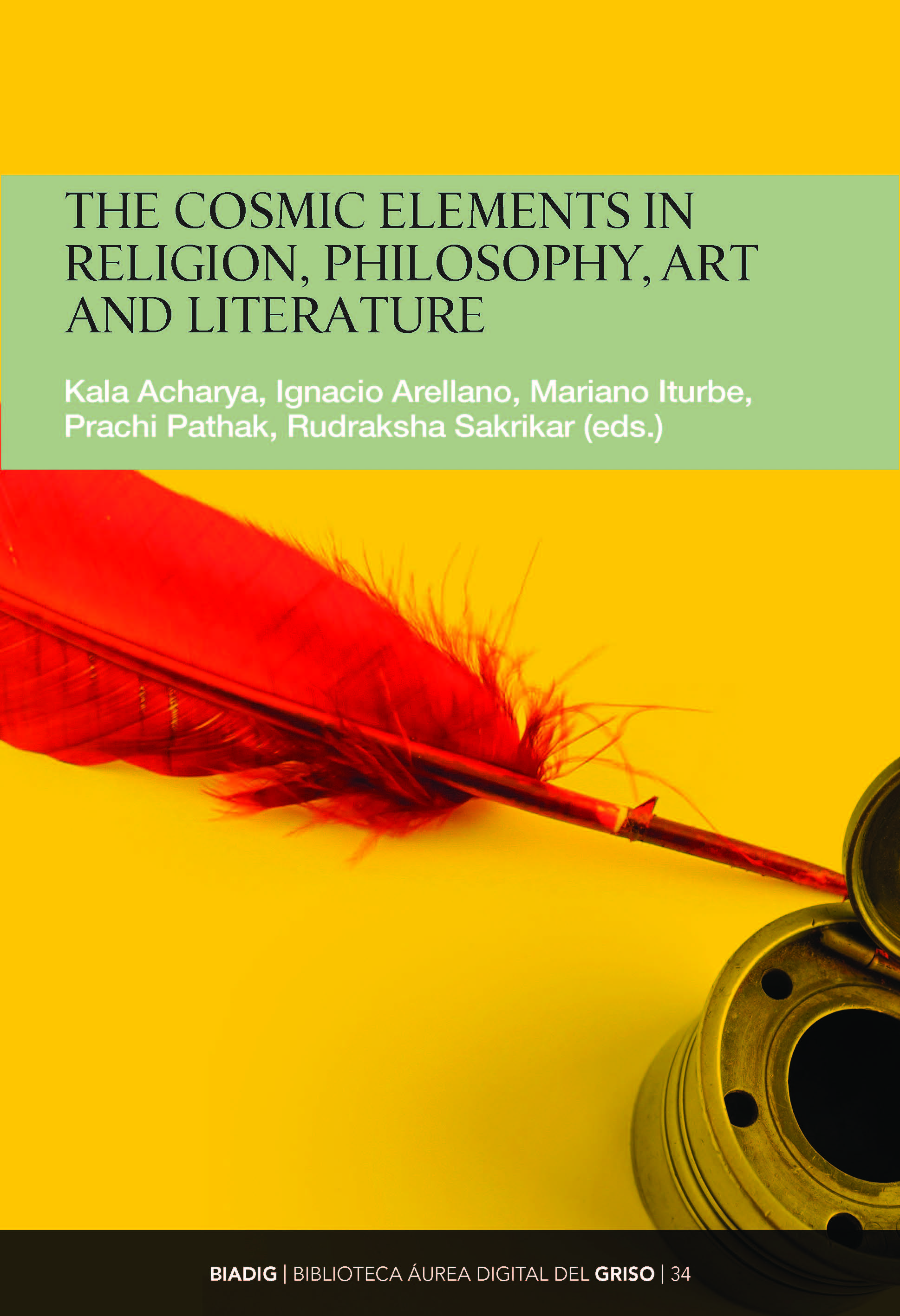
Kala Acharya, Ignacio Arellano, Mariano Iturbe, Prachi Pathak and Rudraksha Sakrikar (eds.), The Cosmic Elements in Religion, Philosophy, Art and Literature, Pamplona, Publishing Services of the University of Navarra, 2015.
BIADIG Collection (Library Services Áurea Digital), 34 / GRISO Digital Publications. ISBN: 978-84-8081-481-2.
From 31st January to 2nd February 2013 an International
Interfaith Dialogue seminar took place at Somaiya Vidyavihar, Mumbai. It continued a fruitful tradition started in 1998. This time the Seminar was jointly organised by K. J. Somaiya Bharatiya Sanskriti Peetham (India) and GRISO from the University of Navarra (Spain). The theme of the seminar was "The Cosmic Elements in Religion, Philosophy, Art and Literature).
Papers were presented by scholars from different countries such as India, Spain, Portugal, UK, Italy, Canada, USA, Mexico, Dominican Republic, and others.The theme of the seminar was focused on the search for the origin of the world, a search that is clearly seen in the various fields of culture. It is a fact that several civilizations have defined a set of 'classical elements' which are considered as the source of whatever exists. The most traditional are the ones of Water, Fire, Earth and Air, to which Ether is also added. K. J. Somaiya Bharatiya Sanskriti Peetham by organizing Interfaith Dialogue seminars aims at fostering a sincere and enriching dialogue between Hinduism, Christianity and Islam. On this occasion it worked together with GRISO, one of the most prestigious research institutes on the Golden Century of Spanish Literature. The timeless message of the Rigveda, the Hindu scripture is: "Meet together, speak together, let your minds be of one accord... May your counsel be common, your assembly common, common the mind and the thoughts of these unite". And here in the seminar scholars from different cultures and religions came together and shared their thoughts.
|
Table of contents |
Page |
Download |
|
Introductory Note |
11 |
|
|
KALA ACHARYA |
15 |
|
|
ANAND AMALADASS |
27 |
|
|
PAULO BARONE |
39 |
|
|
FRANCIS X. D'SA |
49 |
|
|
RONNA S. FEIT |
63 |
|
|
SANTIAGO FERNÁNDEZ MOSQUERA |
71 |
|
|
SORAYA FRANCO |
81 |
|
|
KAVITA S. HOLEY |
87 |
|
|
MARIANO ITURBE |
97 |
|
|
NEETA M KHANDPEKAR |
111 |
|
|
MARIAPIA LAMBERTI |
127 |
|
|
JESÚS LOSADA |
141 |
|
|
GAURI MAHULIKAR |
153 |
|
|
SABYASACHI MISHRA |
163 |
|
|
LALITA NAMJOSHI |
173 |
|
|
MADHAVI NARSALAY |
187 |
|
|
NANDA PURI |
197 |
|
|
ROBIN ANN RICE |
205 |
|
|
MOHD. SANAULLAH NADAWI |
223 |
|
|
HARSHAD N. SANGHRAJKA |
249 |
|
|
G.U. THITE |
257 |
|
|
SHARMILA VIRKAR |
261 |
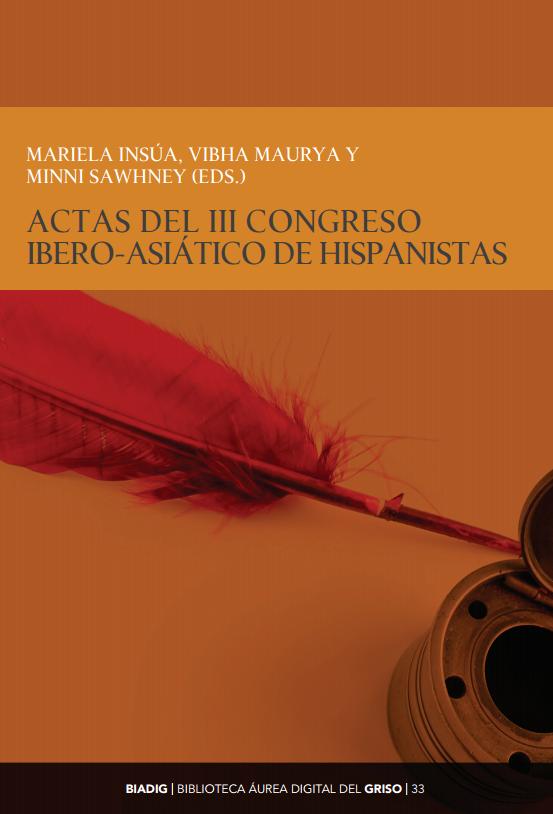 Mariela Insúa, Vibha Maurya and Minni Sawhney (eds.), conference proceedings of the III Ibero-Asian Hispanists congress, Pamplona, Publishing Services of the University of Navarra, 2015.
Mariela Insúa, Vibha Maurya and Minni Sawhney (eds.), conference proceedings of the III Ibero-Asian Hispanists congress, Pamplona, Publishing Services of the University of Navarra, 2015.
BIADIG Collection (Library Services Áurea Digital), 33 / GRISO Digital Publications. ISBN: 978-84-8081-482-9.
The III Ibero-Asian congress of Hispanists was held on October 15-17, 2014 at the University of Delhi (Delhi, India). The organizers, the University of Delhi and the group of research Siglo de Oro (GRISO) of the University of Navarra, are pleased to present the conference proceedings of the congress in digital version published in the BIADIG collection.The program of the congress included speakers from thirteen countries (Canada, South Korea, Colombia, Ecuador, Egypt, Spain, United States, France, India, Morocco, Mexico, Puerto Rico and the Republic of Kazakhstan), a fact that highlights the international character of the participants as well as the approach multidisciplinary of the contributions, dedicated to Spanish literature (with several papers on Cervantes) and Latin American literature, comparative literature (with contributions focused on the link between Hispanic literature and culture with the Ibero-Asian context, especially with India), cinema, theater, linguistics, teaching of Spanish for foreigners, translation... This Issue contains a selection of eighteen of the papers presented.
|
Table of contents |
Page |
Download |
|
presentation |
11 |
|
|
DULCE DIANA AGUIRRE LÓPEZ |
15 |
|
|
SWATI BABBAR |
27 |
|
|
AITOR BIKANDI-MEJIAS |
35 |
|
|
JOSÉ MANUEL CORREDOIRA VIÑUELA |
51 |
|
|
HUGUES DIDIER |
63 |
|
|
MARÍA DOLORES GARCÍA-BORRÓN |
75 |
|
|
SONYA SURABHI GUPTA |
93 |
|
|
HYEJEONG JEONG |
107 |
|
|
DIMITA KETAN MEHTA |
121 |
|
|
ASHWANI KUMAR |
129 |
|
|
SAHIL KUMAR |
139 |
|
|
VIBHA MAURYA |
147 |
|
|
SALWA MOHAMED MAHMOUD |
159 |
|
|
GARIMA SINGH |
175 |
|
|
MANEESHA TANEJA |
189 |
|
|
UPASANA THAKKAR |
201 |
|
|
LAURA ELIZABETH VALDOVINOS DE LA CRUZ |
209 |
|
|
VIJAYA VENKATARAMAN |
221 |
 Carlos Mata Induráin and Ana Zúñiga Lacruz (eds.), "Venia docendi". conference proceedings of the IV congress International Young Researchers of the Golden Age (JISO 2014), Pamplona, Publishing Services of the University of Navarra, 2015.
Carlos Mata Induráin and Ana Zúñiga Lacruz (eds.), "Venia docendi". conference proceedings of the IV congress International Young Researchers of the Golden Age (JISO 2014), Pamplona, Publishing Services of the University of Navarra, 2015.
BIADIG Collection (Library Services Áurea Digital), 32 / GRISO Digital Publications. ISBN: 978-84-8081-460-7.
The fifteen papers collected in the present Issue constitute the conference proceedings of the IV International congress "Jóvenes Investigadores Siglo de Oro" (JISO 2014), which was held on July 28-29, 2014, in Olite and Pamplona (Navarra), organized by the group of research Siglo de Oro of the University of Navarra. The congress was structured around seven sessions: three dedicated to "Theater", one to "Prose", one to "Poetry, Rhetoric and Lexicon", one with the topic "Literature, power and justice" and one more on "Painting", all of which are now represented in the publication of the results. As was the case in previous years' calls for papers, there are three notes that should be highlighted in this congress JISO 2014: the international character of its participants; the interdisciplinary approach of the meeting, which addressed diverse topics related to literature, rhetoric, linguistics, history, law, art, religiosity, culture and society, etc.And, of course, the high quality of the papers presented, whose authors are claiming -some of them already have- the venia docendi, i.e. permission to teach and transmit to others their knowledge in the subjects that constitute their respective specialties.
|
Table of contents |
Page |
Download |
|
"presentation", by Carlos MATA INDURÁIN and Ana ZÚÑIGA LACRUZ |
5 |
|
|
Alba CARMONA |
7 |
|
|
Gemma COBO DELGADO |
23 |
|
|
Blandine DAGUERRE-DÍEZ GARCÍA |
37 |
|
|
Maria Rosaria DE MATTEIS |
49 |
|
|
Daniel FERNÁNDEZ RODRÍGUEZ |
61 |
|
|
Patricia GARCÍA-MONTÓN GONZÁLEZ |
73 |
|
|
Francisco Javier GONZÁLEZ CANDELA |
85 |
|
|
Manuel LÓPEZ FORGAS |
95 |
|
|
Raquel LÓPEZ SÁNCHEZ |
109 |
|
|
Rafael MASSANET RODRÍGUEZ |
121 |
|
|
María Francisca PASCUAL FERNÁNDEZ |
133 |
|
|
Manuel PINO LEÓN |
147 |
|
|
Sara SÁNCHEZ HERNÁNDEZ |
161 |
|
|
Omar SANZ |
175 |
|
|
Miraida Grisel Grisel VILLEGAS GERENA |
189 |
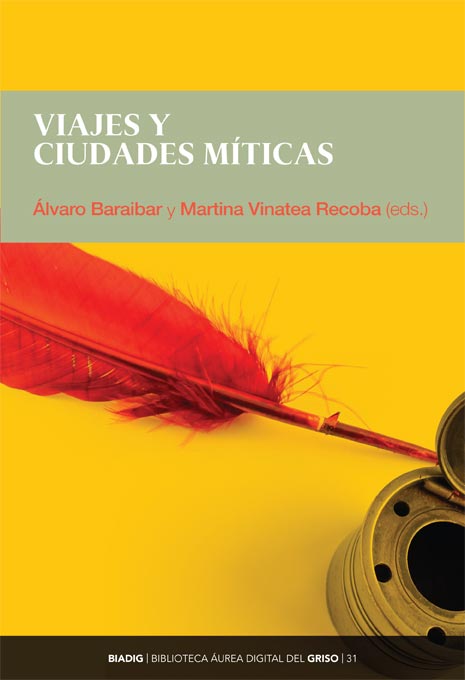 Álvaro Baraibar and Martina Vinatea (eds.), Mythical journeys and cities, Pamplona, Publishing Services of the University of Navarra, 2015.
Álvaro Baraibar and Martina Vinatea (eds.), Mythical journeys and cities, Pamplona, Publishing Services of the University of Navarra, 2015.
ISBN: 978-84-8081-462-1 [Library Services Áurea Digital, BIADIG, 31].
It is well known that the new world was for Europeans the materialisation of the myths that populated the medieval imagination. The new lands and everything in them were something "so new and so unseen and unheard of" that from the very first moment they were engraved in the imagination as mythical territory. Accounts of these new regions, especially those describing Mexico and Cuzco, important viceregal centres, were written with overflowing enthusiasm by the chroniclers and founded mythical cities in the imagination.
The present Issue gathers a set of past and present visions of mythical cities that have been imagined by Americans from the finding to the present day: "Las Indias maravillosas en la Sumaria relación de Baltasar Dorantes de Carranza"; "Buenos Aires: de la ciudad de carne y hueso a la Misteriosa Buenos Aires de Manuel Mujica Láinez"; "Ruinas en palabras: Bahía, 1763"; "Traveling the world in Mexico City: a universal and universalist policy 1730: "Solemn festivities of the canonization of the mystic St. John of the Cross"; "The myth of Babylon in Calderón's theater"; "The degraded myth in Lima inside and out"; "Francisco de Holanda. Da fábrica que falece à cidade de Lisboa"; "Ciudad mítica, ciudad utópica, México en los Diálogos México 1554 de Francisco Cervantes de Salazar"; "Fomentando la identidad institucional dominicana en tres relaciones de fiestas para la beatificación de Santa Rosa de Lima"; ""Un Machu Picchu, por favor": el Cuzco en una novela"; "De Aztlán a México-Tenochtitlan: Myths and omens of pilgrimage, foundation and destruction"; "Mountain of the Earthly Paradise: the moral rewriting of Christopher Columbus in fray Bartolomé de las Casas"; "Rhetorical ethnography in the travel relations to the Indies until the first half of the 16th century"; "The myth of the return: contemporary Ithaca and Ulysses"; "A search journey in Mexican cinema: Cabeza de Vaca (Nicolás Echevarria, 1990)".
This book, attentive reader, is a pilgrimage through the vast territories of the imagination, the same imagination that traced the contours of Cuzco, Lima, Quito, La Paz, Bogota and the whole of figurative America with the Spanish language for the rest of the world.
|
Table of contents |
Page |
Download |
|
"presentation", by Álvaro Baraibar and Martina Vinatea |
11 |
|
|
Ysla Campbell |
13 |
|
|
David Choin |
23 |
|
|
Alfredo Cordiviola |
37 |
|
|
Dominique de Courcelles |
49 |
|
|
Isabel Hernando Morata |
69 |
|
|
Antonio Lorente Medina |
83 |
|
|
Cristina Osswald |
95 |
|
|
Margarita Peña |
113 |
|
|
Mirzam C. Pérez |
123 |
|
|
Giovanna Pollarolo |
131 |
|
|
Maria Stoopen |
143 |
|
|
Vanina María Teglia |
159 |
|
|
framework Urdapilleta Muñoz |
171 |
|
|
Yasmina Yousfi López |
184 |
|
|
Alma Delia Zamorano Rojas |
199 |
Teatro cortesano y Relación de una fiesta en Cerdeña (1641): panegíricos y proezas de los príncipes de Oria, by Francisco Tello, edition and preliminary study by Gabriel Andrés, Pamplona, Publishing Services of the University of Navarra, 2015.
ISBN: 978-84-8081-453-9 [Library Services Áurea Digital, BIADIG, 30].
In the summer of 1641, coinciding with the feast of Our Lady of Mount Carmel, extraordinary public festivities were held in the capital of the Kingdom of Sardinia, which it is now possible to reconstruct thanks to the recent recovery of several texts related to that courtly theatrical festival, admired by the spectators of the time under the title degree scroll de Panegíricos y proezas de los príncipes de Oria (Panegyrics and exploits of the princes of Oria). It is a play in verse, in three parts conference and with an introductory loa, performed and published that same year in Cagliari (today's Cagliari) together with a copy of the Relación de la fiesta that describes in detail how both the theatrical performance and the preparations for the urban festivities were carried out.
The materials studied and edited in this Issue enrich the corpus of Hispano-Sardinian theater known until now, circumscribed mainly to a limited series of religious dramaturgical texts. Occasional news and references in various texts and documents suggest that the theatrical production during the modern age on the island, especially in the Jesuit and courtly spheres, was not as limited as the preserved texts might indicate. In any case, the Panegyrics and exploits of the princes of Oria, by Francisco Tello de León, confirm the vivacity of that seicentesque scenic production of courtly invoice linked to practices that, on a greater or lesser scale, were deployed with strong and indelible cultural impact by the main cultural centers of the time, including Sardinia.
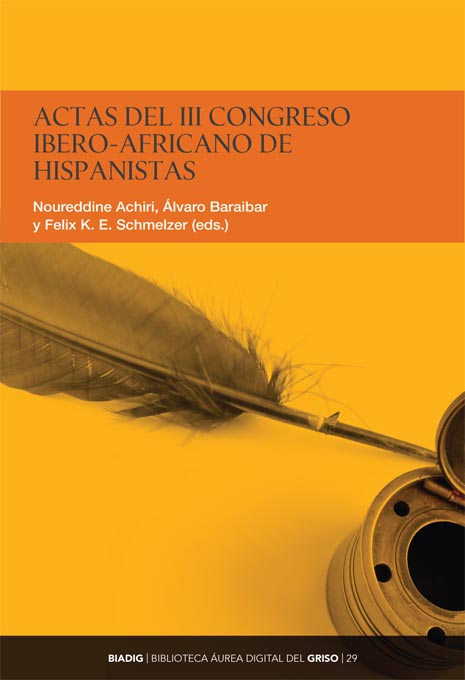 Noureddine Achiri, Álvaro Baraibar and Felix K. E. Schmelzer (eds.), conference proceedings of the III Ibero-African Hispanists congress, Pamplona, Publishing Services of the University of Navarra, 2015.
Noureddine Achiri, Álvaro Baraibar and Felix K. E. Schmelzer (eds.), conference proceedings of the III Ibero-African Hispanists congress, Pamplona, Publishing Services of the University of Navarra, 2015.
ISBN: 978-84-8081-451-5 [Library Services Áurea Digital, BIADIG, 29].
The present Issue gathers a good part of the papers presented at the III Ibero-African congress of Hispanists held in Fez (Morocco) between 15 and 17 January 2014. In these conference proceedings we will find an important issue of works related to Hispanism in the international field, with a special attention, obviously, to African Hispanism. The programs of study collected in these pages, in addition to analyses and reflections on different aspects of Spanish and Latin American literature from the Golden Age to the 21st century, address with special interest topics such as Spanish-African relations at present and throughout history, the presence of the Arab and Muslim in Spanish literature, and the various realities and problems of translation, teaching and the didactics of Spanish in contexts of the African continent (such as the Moroccan or Algerian, for example). The texts are equally varied and plural if we look at them from the point of view of their authors. In addition to Hispanists from different parts of the African continent (Morocco, Algeria, Cameroon, Ivory Coast, Egypt, Senegal and Tunisia), we also find contributions from other specialists from countries such as Spain, the United States, Holland, Japan and Mexico. And not least, together with works by more established professors and researchers, we will also find interesting contributions by younger Hispanists, translators and teachers of Spanish as a foreign language in diverse realities. A set of texts, in final, very different from each other that tell us about the varied reality of the Hispanic programs of study in the African environment, a growing, fruitful and hopeful reality, to which, undoubtedly, it will be necessary to continue paying attention in the future.
|
Table of contents |
Page |
Download |
|
Rasha Mohamed Abboudy |
13 |
|
|
Abeer Mohamed Abdel Hafez |
25 |
|
|
Abeer M. Abdel Salam |
39 |
|
|
Hayam Abdou Mohamed |
53 |
|
|
Karima Aït Yahia |
67 |
|
|
Saïd Akif |
77 |
|
|
Gihane Amin |
87 |
|
|
Radhia Ben Ammar |
99 |
|
|
Hassan Arabi |
109 |
|
|
Hala Abdelsalam Awaad |
121 |
|
|
Tapsir Ba |
139 |
|
|
Valérie Benoist |
147 |
|
|
Karima Bouallal |
157 |
|
|
Karidjatou Diallo |
163 |
|
|
Farida Djebaili |
175 |
|
|
Nadira Djebaili |
183 |
|
|
Amina Fidel |
189 |
|
|
Nagwa Gamal Mehrez |
203 |
|
|
Yasmín Hosny |
213 |
|
|
Kenji Inamoto |
229 |
|
|
Gengo Ito |
241 |
|
|
Malika Kettani |
253 |
|
|
Joaquín Moreno Pedrosa |
261 |
|
|
Nafissa Mouffok |
273 |
|
|
Pierre Paulin Onana Atouba |
283 |
|
|
Brígida M. Pastor |
299 |
|
|
Dulce María Quiroz Bustamante |
311 |
|
|
Doaa Samy |
323 |
|
|
Susana Sarfson and Rodrigo Madrid |
337 |
|
|
Aram A. Shahin |
349 |
|
|
Eric Storm |
361 |
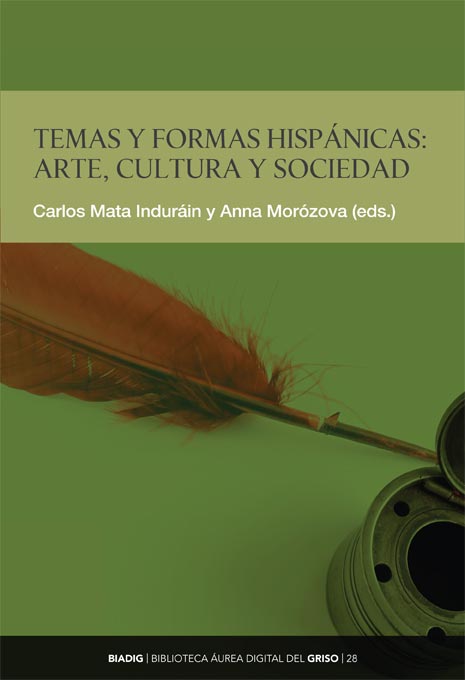 Carlos Mata Induráin and Anna Morózova (eds.), Hispanic Themes and Forms: Art, Culture and Society, Pamplona, Publishing Services of the University of Navarra, 2015.
Carlos Mata Induráin and Anna Morózova (eds.), Hispanic Themes and Forms: Art, Culture and Society, Pamplona, Publishing Services of the University of Navarra, 2015.
ISBN: 978-84-8081-450-8 [Library Services Áurea Digital, BIADIG, 28].
This Issue collects a selection of 38 papers prepared on the occasion of the Internationalcongress "Hispanic Themes and Forms: Art, Culture and Society", held in St. Petersburg (Russia) on November 26-28, 2013. The meeting, organized by St. Petersburg State University, the group of research Siglo de Oro (GRISO) of the University of Navarra and the Institute of programs of study Auriseculares (IDEA), was organized in three major sections ("Art and Culture", "History" and "language and Literature") which are well represented here. Several authors deal with various aspects of Spanish-Russian relations: historical, political and cultural contacts in different periods, the image of Russia in Spain, influences of Russian writers on Spanish literature, etc. In the field of painting, we could not miss some programs of study focused on the great Spanish authors (El Greco, Ribera, Murillo, Goya, Picasso...), to which are added other analyses on the court portrait in the 17th century or the problem of the converted and enlightened artists, or the relationship of the nobility and lineage with art. But there are also works focused on other arts such as architecture and sculpture (late Gothic, Spanish sculptures in Moscow, the steps of Holy Week...). The papers in the field of history deal with a wide variety of periods and themes, such as the Christian Church at the time of the Muslim conquest, the Crown of Aragon in the 14th century, the Hispanic Monarchy (in Europe and the American viceroyalties), the Inquisition, etc. Several works analyze authors and works of Hispanic literature, from the Poema de mio Cid to Salvador Espriu, including the classics of the Golden Age such as Cervantes, Jiménez Patón, Lope de Vega or Gracián, among others. Finally, some contributions offer linguistic approaches (phraseology, gender vocabulary, onomastics, etc.) or deal with questions of translation, cultural anthropology, etc. Taken as a whole, we believe that this Issue on Temas y formas hispánicas: arte, cultura y sociedad can constitute -with the necessary selection of topics that such a broad theme imposes- a valuable contribution multidisciplinary to the Spanish-Russian programs of study .
|
Table of contents |
Page |
Download |
|
"presentation", by Carlos MATA INDURÁIN and Anna MORÓZOVA |
7 |
|
|
Vsévolod BAGNÓ |
11 |
|
|
Valentina BUN |
43 |
|
|
Luis Javier CUESTA HERNANDEZ |
53 |
|
|
Miguel José DEYÁ BAUZÁ |
69 |
|
|
Tatiana GONCHAROVA |
85 |
|
|
Julián GONZÁLEZ-BARRERA |
101 |
|
|
Juan C. GONZÁLEZ MAYA |
111 |
|
|
Roman IGNATYEV |
125 |
|
|
Ludmila KAGANÉ |
139 |
|
|
Nina KALITINA |
155 |
|
|
Kirill KORKONOSENKO |
163 |
|
|
Jorge LATORRE |
179 |
|
|
Vladimir LITUS |
195 |
|
|
Vicente LLEÓ CAÑAL |
201 |
|
|
Rosa LÓPEZ TORRIJOS |
219 |
|
|
Fernando MARÍAS |
241 |
|
|
Anna MOROZOVA |
263 |
|
|
Svetlana MOROZOVA |
279 |
|
|
Olga NIKOLAEVA |
295 |
|
|
Ariadne PETROVA |
309 |
|
|
Svetlana PISKUNOVA |
321 |
|
|
Anastasia ROGÓZINA |
331 |
|
|
Yuri ROMANOV and Yuri SHASHKOV |
337 |
|
|
Maria RÝBINA |
341 |
|
|
Anatoly RYKOV |
355 |
|
|
Inna SHALUDKO |
363 |
|
|
Yuri SHASHKOV |
377 |
|
|
Irina SÓNINA |
391 |
|
|
Olga SVETLAKOVA |
399 |
|
|
Galina TOMIRDIARO |
407 |
|
|
Irina VARYASH |
417 |
|
|
Olga VOIKU |
429 |
|
|
Olga VOLOSYUK |
437 |
|
|
Valeri VOZGRIN |
453 |
|
|
Alexander YAKIMOVICH |
461 |
|
|
Marina YAROVAYA |
477 |
|
|
Galina ZELENINA |
497 |
|
|
Elena ZERNOVA |
523 |
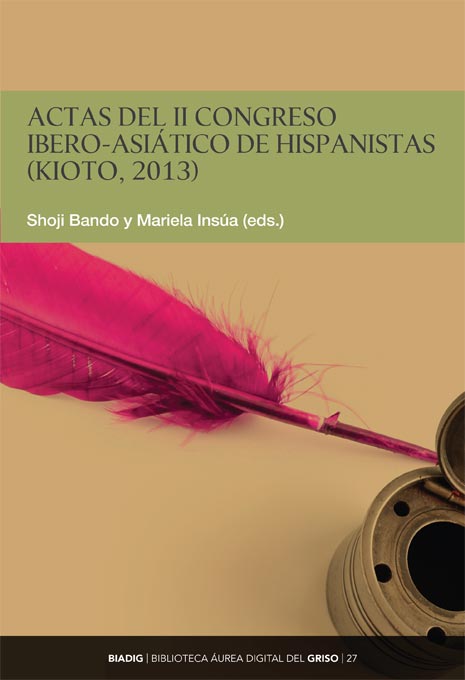 Shoji Bando and Mariela Insúa (eds.), conference proceedings of the II Ibero-Asian Hispanists congress (Kyoto, 2013), Pamplona, Publishing Services of the University of Navarra, 2014.
Shoji Bando and Mariela Insúa (eds.), conference proceedings of the II Ibero-Asian Hispanists congress (Kyoto, 2013), Pamplona, Publishing Services of the University of Navarra, 2014.
ISBN: 978-84-8081-436-2 [Library Services Áurea Digital, BIADIG, 27].
This new issue of the collection offers the reader a selection of the papers presented at the II Ibero-Asian congress of Hispanists, co-organized by Kyoto University of Foreign Studies and the group of research Siglo de Oro (GRISO) of the University of Navarra, which took place in the city of Kyoto, former imperial capital of Japan, from September 21 to 23, 2013. More than one hundred Hispanists from five continents participated in the congress , with a total of 24 countries represented in the program, namely Japan, Spain, France, Italy, Romania, United Kingdom, Ireland, Norway, Ivory Coast, Senegal, Egypt, Iran, India, Taiwan, South Korea, Australia, Canada, United States, Argentina, Brazil, Chile, Colombia, Ecuador and Mexico. This publication brings together a selection of 48 of the papers presented. The marked international character of the authors of the Issue stands out, as well as the approach multidisciplinary of the contributions, dedicated to Spanish and Latin American literature, history, linguistics, teaching of Spanish for foreigners, international relations, cultural contacts between East and West... These conference proceedings that we now publish are intended to be a new step on the road to this twinning in a network of programs of study Ibero-Asian in which Japanese Hispanists, as shown by the works collected in this Issue, have much to contribute.
|
Table of contents |
Page |
Download |
|
"Preliminaries |
7 |
|
|
Hala ABDEL SALAM AHMED AWAAD |
13 |
|
|
Hayam ABDOU MOHAMED FARRAG |
21 |
|
|
Lourdes ALBUIXECH |
39 |
|
|
Tapsir BA |
53 |
|
|
Aitor BIKANDI-MEJIAS |
61 |
|
|
Pedro CEBOLLERO |
73 |
|
|
Fernando CID LUCAS |
85 |
|
|
Sandra CUESTA |
103 |
|
|
María José CUESTA GARCÍA DE LEONARDO |
117 |
|
|
Ángel DELGADO GÓMEZ |
135 |
|
|
Hugues DIDIER |
153 |
|
|
María-Dolores GARCÍA-BORRÓN |
163 |
|
|
Antonio GIL DE CARRASCO |
175 |
|
|
Israel HOLAS ALLIMANT |
185 |
|
|
Hyejeong JEONG |
195 |
|
|
Tomás JIMÉNEZ JULIÁ |
209 |
|
|
Min Ji KANG |
225 |
|
|
Hiroko KARIYA |
239 |
|
|
Juzo KATAKURA |
251 |
|
|
Juli KIM |
261 |
|
|
Sun Young KIM |
277 |
|
|
Rachid LAMARTI |
291 |
|
|
Man-Ki LEE |
307 |
|
|
Claudia MACÍAS DE YOON |
325 |
|
|
Alfredo MARTÍNEZ EXPÓSITO |
341 |
|
|
Adriana MINARDI |
357 |
|
|
Chisako MIURA |
367 |
|
|
Miki NISHU |
375 |
|
|
Takashi OSHIO |
387 |
|
|
Fernando SILVER |
399 |
|
|
Joan Antoni POMATA GARCÍA |
413 |
|
|
Tomás REGALADO LÓPEZ |
427 |
|
|
David RODRÍGUEZ ALVA |
441 |
|
|
Hugo SALCEDO LARIOS and Víctor SOTO FERREL |
453 |
|
|
So Hui SEONG |
467 |
|
|
Osami TAKIZAWA |
481 |
|
|
Ho-Joon YIM |
499 |
|
|
Daniel de ZUBÍA FERNÁNDEZ |
509 |
|
|
Panel "Approach to Spanish Renaissance thought through the works of Nebrija, Vives, Luis de León, Cortés and Inca Garcilaso de la Vega". coordinator Shinsho OKAMOTO |
|
|
|
Shinjiro ANDO |
523 |
|
|
Ryujin NOMURA |
533 |
|
|
Shinsho OKAMOTO |
543 |
|
|
Reiko TATEIWA |
555 |
|
|
Margarita ZAMORA |
565 |
|
|
Panel "Political transformation and the international network in the Iberian Peninsula in the 20th century". Coordinator: Haruko HOSODA |
|
|
|
Haruna FUKASAWA |
573 |
|
|
Yasuhiro FUKASAWA |
587 |
|
|
Haruko HOSODA |
601 |
|
|
Luis María PEDRIZA BERMEJILLO |
617 |
|
|
Keishi YASUDA |
627 |
 Emmanuel Marigno, Carlos Mata Induráin and Hugo Hernán Ramírez Sierra (eds.), Cervantes creator and Cervantes recreated, Pamplona, Publishing Services of the University of Navarra, 2015.
Emmanuel Marigno, Carlos Mata Induráin and Hugo Hernán Ramírez Sierra (eds.), Cervantes creator and Cervantes recreated, Pamplona, Publishing Services of the University of Navarra, 2015.
ISBN: 978-84-8081-422-5 [Library Services Áurea Digital, BIADIG, 26].
This Issue intends to be a valuable contribution in the double plane of analysis announced by its title degree scroll: the creative activity of the author of the Novelas ejemplares -Cervantescreator-but also, in the field of reception understood in a broad sense, the numerous literary and artistic traces -Cervantesrecreated-to which this creative work gave rise in posterity, thanks to the enormous potential contained in it. Of the total of nineteen works included here, several of them are approaches that analyze, with a variety of approaches and approaches, certain topics specifically related to the Novelas ejemplares, whether they are considerations of the whole, or approaches to specific titles, or to the narrative art of these pieces and the concept of exemplarity handled by Cervantes. Other contributions deal with the commentary of various recreations that these twelve short novels -but also other Cervantes' works- have inspired throughout the centuries and in the most diverse arts, since the abundant literary rereadings in many languages have been joined by others from painting and the plastic arts in general to the cinema.
|
Table of contents |
Page |
Download |
|
"presentation", by Emmanuel MARIGNO, Carlos MATA INDURÁIN, and Hugo Hernán RAMÍREZ SIERRA |
5 |
|
|
Dayamí ABELLA PADRÓN |
7 |
|
|
Paula Renata de ARAÚJO |
21 |
|
|
Pierre DARNIS |
31 |
|
|
Mauricio DOMÉNICI |
63 |
|
|
Diogenes FAJARDO VALENZUELA |
73 |
|
|
Javier GARCÍA ALBERO |
87 |
|
|
Sonia KERFA |
101 |
|
|
Naima LAMARI |
117 |
|
|
Jean-Michel LASPÉRAS |
133 |
|
|
Emmanuel MARIGNO VÁZQUEZ |
151 |
|
|
Emmanuel MARIGNO VÁZQUEZ |
165 |
|
|
Emilio MARTÍNEZ MATA |
185 |
|
|
Carmela MATTZA |
193 |
|
|
Michel MONER |
209 |
|
|
Maria Inês NEMÉSIO |
227 |
|
|
Jean-Claude SEGUIN |
249 |
|
|
Jacques SOUBEYROUX |
281 |
|
|
María STOOPEN GALÁN |
295 |
|
|
Norman VALENCIA |
303 |
Anonymous, Cada cual con su cada cual, ed. by Marcella Trambaioli, Pamplona, Publishing Services of the University of Navarra, 2014.
ISBN: 978-84-8081-421-8 [Library Services Áurea Digital, BIADIG, 25].
The Issue offers the critical edition of the anonymous burlesque comedy Cada cual con su cada cual, whose degree scroll, which is a proverbial phrase, announces the eventful weddings of the two infantas of a grotesque and provincial court with their worthy suitors: the Prince and Escalante. In fact, it is a comedy of absurdities that does not parody any specific play. Several textual indications refer to a late composition, so its peculiarities shed light on the last phase of development of the theatrical typology to which it belongs. The annotation tries to elucidate anachronistic linguistic usages, burlesque devices, cultural and stylistic elements, as well as mentioning parallel passages from other comedies and contemporary literary texts.
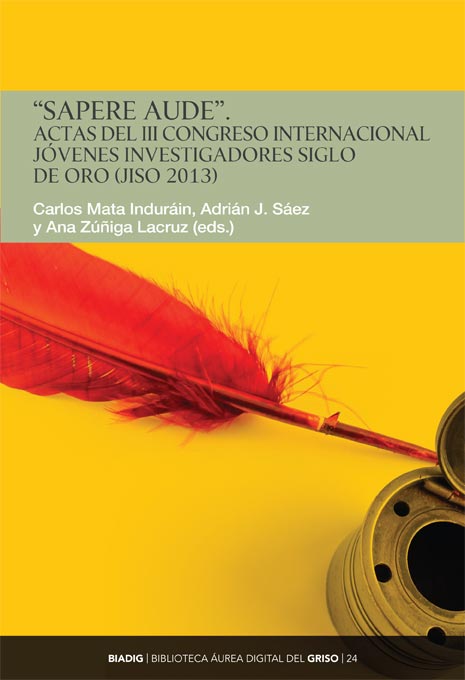
Carlos Mata Induráin, Adrián J. Sáez and Ana Zúñiga Lacruz (eds.), "Sapere aude". conference proceedings del III congress Internacional Jóvenes Investigadores Siglo de Oro (JISO 2013), Pamplona, Publishing Services of the University of Navarra, 2014.
ISBN: 978-84-8081-417-1 [Library Services Áurea Digital, BIADIG, 24].
If the conference proceedings of the two previous congresses, JISO 2011 and JISO 2012, were presented under the labels Scripta manent and Festina lente, respectively, on this occasion we take up one of the lessons that Horace gives his friend Lolius from a dialogue on the return of Ulysses from Troy: "Dimidium facti, qui coepit, habet: sapere aude, / incipe"(Epistolas, II). Quite rightly, this 'dare to know' (or 'dare to think', as it is also translated) is an ideal motto for the university teaching and, in general, for the approach to all forms of knowledge. Perhaps it is even more apt for those who are in the early stages of their journey along the paths of literary criticism.
The present Issue gathers some thirty contributions that were presented at the III International congress "Jóvenes Investigadores Siglo de Oro" (JISO 2013) which, organized by the group de research Siglo de Oro (GRISO) of the University of Navarra, took place in Pamplona on July 31 and August 1, 2013. This select group of works of varied topics, contributed by young critics from the most disparate backgrounds, allow us to stop and look at the directions in which their new projects of work are entering in the field of the Golden Age, which shows that the Philology and other related disciplines are alive and have continuity in time.
|
Table of contents |
Page |
Download |
|
"presentation", by Carlos MATA INDURÁIN, Adrián J. SÁEZ and Ana ZÚÑIGA LACRUZ |
7 |
|
|
Daniel BALDELLOU MONCLÚS |
11 |
|
|
Benedetta BELLONI |
25 |
|
|
Luc CAPIQUE |
37 |
|
|
Verónica CASAIS VILA |
45 |
|
|
Alessandra CERIBELLI |
59 |
|
|
Carlos M. COLLANTES SÁNCHEZ |
71 |
|
|
Marion DARESSY |
85 |
|
|
Rosa DURÁ CELMA |
97 |
|
|
Juan Luis FUENTES NIETO |
111 |
|
|
Josée GALLEGO CHIN |
123 |
|
|
Francisco Javier GONZÁLEZ CANDELA |
135 |
|
|
Christelle GROUZIS DEMORY |
149 |
|
|
Laura HERNÁNDEZ GONZÁLEZ |
159 |
|
|
Amparo IZQUIERDO DOMINGO |
173 |
|
|
Eva LÓPEZ DEL BARRIO |
181 |
|
|
Mónica MARTÍN MOLARES |
193 |
|
|
Ana MARTÍNEZ MUÑOZ |
213 |
|
|
María del Rosario MARTÍNEZ NAVARRO and Alejandro LOEZA ZALDÍVAR |
225 |
|
|
Giselle Cristina Gonçalves MIGLIARI and Paula Renata de ARAUJO |
239 |
|
|
Itziar MOLINA SANGÜESA |
251 |
|
|
Sergio NAVARRO RAMÍREZ |
265 |
|
|
Ion PAGOAGA IBIRICU |
279 |
|
|
María Francisca PASCUAL FERNÁNDEZ |
293 |
|
|
Sara SÁNCHEZ BELLIDO |
307 |
|
|
Emilio Antonio SÁNCHEZ PIÑERO |
319 |
|
|
Blanca SANTOS DE LA MORENA |
333 |
|
|
Artem SEREBRENNIKOV |
343 |
|
|
Nazaret SOLÍS MENDOZA |
353 |
|
|
Guillermo SORIANO SANCHA |
363 |
|
|
Nadchaphon SRISONGKRAM |
375 |
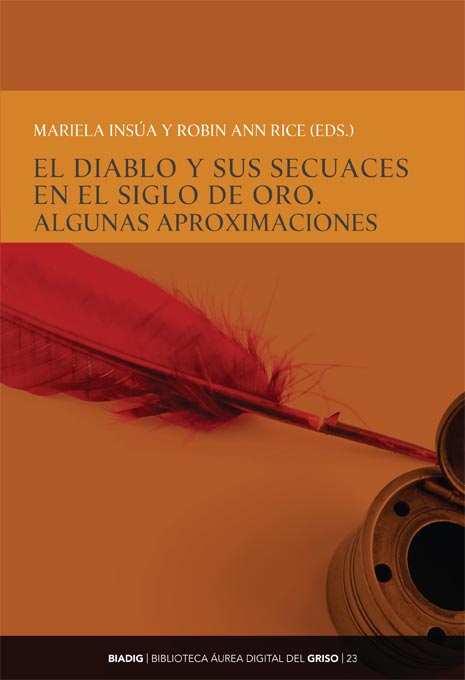
Mariela Insúa and Robin Ann Rice (eds.), El diablo y sus secuaces en el Siglo de Oro. Algunas aproximaciones, Pamplona, Publishing Services de la Universidad de Navarra, 2014.
ISBN: 978-84-8081-416-4 [Library Services Áurea Digital, BIADIG, 23].
In the Golden Age, the devil became one more element in the list of recurring characters in the golden age genres, such as the gallant, the joker or the villain. This collection of seven articles provides some approaches to the presence and function of the devil in different literary genres and from different critical perspectives. Thus, the character is analysed in his relationship with tragic culture (Aguilar Víquez) or the cynical Philosophy and the Menippean tradition (Castro); his characterisation in some novels by María de Zayas (Paredes Monleón) or his development in Mira de Amescua's El esclavo del demonio and his relationship with Sandoval y Zapata's Lo que es ser predestinado ( Herrera). A typology of the figures of evil as literary characters is also proposed, applied especially to the Novo-Hispanic context (Ortiz y Terán Elizondo); and also, within the American sphere, the demon is studied in the short plays of the Costa Rican Oreamuno y Muñoz de la Trinidad (Sancho Dobles).
In short, the demonic protagonist is an important part of the collective religious and popular imagination. Mischievous and extrovert, his works entertain in some cases and terrify in others. El diablo y sus secuaces en el Siglo de Oro (The Devil and His Minions in the Golden Age) offers a series of looks at this singular and attractive character that show his great potential.
|
Table of contents |
Page |
Download |
|
Preliminaries |
5 |
|
|
Fidencio AGUILAR VÍQUEZ |
7 |
|
|
Ricardo J. CASTRO |
13 |
|
|
Arnulfo HERRERA |
25 |
|
|
Alberto ORTIZ / María Isabel TERÁN ELIZONDO |
33 |
|
|
Alberto ORTIZ / María Isabel TERÁN ELIZONDO |
49 |
|
|
María Libertad PAREDES MONLEÓN |
69 |
|
|
Leonardo SANCHO DOBLES |
85 |

Álvaro Baraibar (ed.), Visibilidad y knowledge dissemination de la research desde las Humanities Digitales. Experiences and Projects, Pamplona, Publishing Services of the University of Navarra, 2014.
ISBN: 978-84-8081-412-6 [Library Services Áurea Digital, BIADIG, 22].
At the group de research Siglo de Oro (GRISO) of the University of Navarra, we have been working for some time now on projects that clearly fall within the scope of Humanities Digital. The latest of the projects we have promoted has to do with the application of new technologies to the visibility and dissemination of the results of research. This is one of the challenges that the information society has set for humanists, since the dissemination of the results of our research, the dissemination and knowledge dissemination of knowledge, is precisely one of the strong points of the transfer of Humanities to society in general.
This work brings together interesting initiatives, projects and experiences at different levels in this broad context of the visibility and dissemination of research in the field of Humanities. It brings together different experiences, shares knowledge, and makes other initiatives known, because in the field of Humanities Digital the exemplary value of projects is very important.
Thus, the book has been organised in four different areas with their own personality, but linked, as it could not be otherwise, to each other: "Academic Blogging, visibility and dissemination of the research", "Digital Journals", "Digital Publishing" and "knowledge dissemination and Digital Libraries".
|
Table of contents |
Page |
Download |
|
Previous pages |
|
|
|
"presentation" |
13 |
|
|
PART ONE. ACADEMIC BLOGGING, VISIBILITY AND DISSEMINATION OF THE RESEARCH |
|
|
|
Javier ANDREU PINTADO |
17 |
|
|
Beatriz TEJADA |
43 |
|
|
PART TWO. DIGITAL MAGAZINES |
|
|
|
Alejandro ÁLVAREZ NOBELL and Francisco Javier HERRERO GUTIÉRREZ |
51 |
|
|
J. Enrique DUARTE |
69 |
|
|
Guillermo GÓMEZ SÁNCHEZ-FERRER |
81 |
|
|
Mariela INSÚA |
91 |
|
|
Concha MATEOS MARTÍN and José Manuel DE PABLOS COELLO |
103 |
|
|
Manuel RAMÍREZ SÁNCHEZ, Críspulo TRAVIESO RODRÍGUEZ, Julio A. MARTÍNEZ MORILLA and Francisco FUMAGALLO DÍAZ-LLANOS |
119 |
|
|
Guadalupe ROMERO SÁNCHEZ, Carlos GARRIDO Spanish, Yolanda GUASCH MARÍ and Francisco MONTES GONZÁLEZ |
147 |
|
|
PART THREE. DIGITAL EDITION |
|
|
|
Rosanna CANTAVELLA |
161 |
|
|
Antonio Rafael FERNÁNDEZ PARADAS |
171 |
|
|
Elena GONZÁLEZ-BLANCO GARCÍA, Clara Isabel MARTÍNEZ CANTÓN, María Dolores MARTOS PÉREZ and María Gimena DEL RÍO RIANDE |
185 |
|
|
Eduardo RODRÍGUEZ LÓPEZ and Ángeles SAAVEDRA PLACES |
205 |
|
|
Laeticia ROVECCHIO ANTÓN and Alba URBAN BAÑOS |
223 |
|
|
PART FOUR. KNOWLEDGE DISSEMINATION AND DIGITAL LIBRARIES |
|
|
|
C. Yolanda ARENCIBIA SANTANA and Rubén DOMÍNGUEZ QUINTANA |
233 |
|
|
Eleonora ARRIGONI and Eduardo RODRÍGUEZ LÓPEZ |
243 |
|
|
David AZNAR-LAFONT |
253 |
|
|
Antonio CARPALLO BAUTISTA and Yohana Yessica FLORES HERNÁNDEZ |
263 |
|
|
Salomé ESLAVA OCHOA and Arantxa ITURBIDE TELLECHEA |
273 |
|
|
Carolina FERRER |
289 |
|
|
Víctor GARCÍA RUIZ |
307 |
|
|
Javier GUTIÉRREZ CAROU |
323 |
|
|
María Jesús MANCHO DUQUE |
329 |
|
|
María Dolores MARTOS PÉREZ |
343 |
|
|
Roberto SAN MARTÍN CASI |
355 |
Horacio A. Acevedo González, El teatro de Calderón. René Girard's anthropology and the triumph of the Eucharist. Claves católicas para una reescritura de la Modernidad en "La vida es sueño", Pamplona, Publishing Services de la Universidad de Navarra, 2013.
ISBN: 978-84-8081-383-9 [Library Services Áurea Digital, BIADIG, 21].
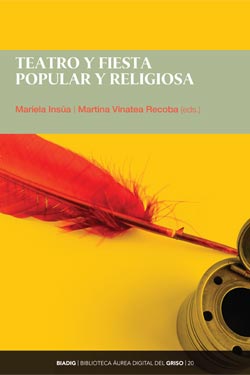 Mariela Insúa and Martina Vinatea Recoba (eds.), Theatre and popular and religious festivals, Pamplona, Publishing Services of the University of Navarra, 2013.
Mariela Insúa and Martina Vinatea Recoba (eds.), Theatre and popular and religious festivals, Pamplona, Publishing Services of the University of Navarra, 2013.
ISBN: 978-84-8081-409-6 [Library Services Áurea Digital, BIADIG, 20].
Theatre, popular festivity and religious celebration are strongly interwoven in the Hispanic world of the Baroque and their study has been greatly enriched in recent years. Moved by this interest in the rich heritage of festivity as a historical, cultural and social phenomenon, the group de research Siglo de Oro (GRISO) of the University of Navarra, the high school de programs of study Auriseculares (IDEA) and the Universidad del Pacífico organised the congress International "Teatro y fiesta popular y religiosa", in Cuzco, Peru, between 4 and 7 June 2012.
We now offer the reader a publication that we hope will make a significant contribution to the continuation of programs of study on this vast and exciting topic of theatre and popular and religious festivals during the Baroque period and its projection to the present day.
|
Table of contents |
Page |
Download |
|
"presentation" |
9 |
|
|
Celia de ALDAMA ORDÓÑEZ |
11 |
|
|
Macarena BAEZA DE LA source |
23 |
|
|
Graciela BALESTRINO |
39 |
|
|
Raquel BARROSO SILVA |
51 |
|
|
Araceli CAMPOS MORENO |
65 |
|
|
Lorena CORDERO |
79 |
|
|
María José CUESTA GARCÍA DE LEONARDO |
93 |
|
|
Miguel DONOSO RODRÍGUEZ |
107 |
|
|
Leonor FERNÁNDEZ GUILLERMO |
119 |
|
|
Ana GODOY COSSÍO |
137 |
|
|
Antonio GUIJARRO DONADIÓS |
157 |
|
|
Itzíar LÓPEZ GUIL |
171 |
|
|
Fátima LÓPEZ PIELOW |
185 |
|
|
Vibha MAURYA |
199 |
|
|
Valeria MOZZONI / María Laura NUÑEZ |
213 |
|
|
María del Carmen NICOLÁS ALBA |
227 |
|
|
Mirzam C. PÉREZ |
241 |
|
|
María Victoria RACHED DE BIANCHI |
257 |
|
|
Álvaro RECIO spanish medical residency program |
269 |
|
|
Suely REIS PINHEIRO |
291 |
|
|
Alexis challenge AGURTO |
301 |
|
|
Liège RINALDI |
315 |
|
|
Alena ROBIN / Andrea ÁVILA |
325 |
|
|
Guadalupe ROMERO SÁNCHEZ / Yolanda GUASCH MARÍ |
343 |
|
|
Ana STANIC |
365 |
|
|
Maria do Amparo TAVARES MALEVAL |
379 |
|
|
Erika THOMAS |
397 |
|
|
Luc TORRES |
413 |
|
|
Vijaya VENKATARAMAN |
427 |
|
|
Juan Manuel VILLANUEVA FERNÁNDEZ |
439 |
|
|
Martina VINATEA RECOBA |
457 |
Sabyasachi Mishra, Barlaam and Josafat in the Spanish theater of the Golden Age. Study and edition of "Los defensores de Cristo", anonymous comedy of three ingenios, and "El príncipe del desierto y ermitaño de palacio", by Diego de Villanueva y Núñez and José de Luna y Morentin, Pamplona, Publishing Services of the University of Navarra, 2013.
ISBN: 978-84-8081-391-4 [BIADIG, Library Services Aurea Digital, 1

Mariela Insúa and Felix K. E. Schmelzer (eds.), Teatro y poder en el Siglo de Oro, Pamplona, Publishing Services de la Universidad de Navarra, 2013.
ISBN: 978-84-8081-400-3 [Library Services Áurea Digital, BIADIG, 18].
The present Issue brings together fifteen works that address various aspects related to power and its concomitants in the plays of the Golden Age. This publication is part of the line of research "Authority and power in the Golden Age" that the GRISO has been developing for several years in partnership with other European institutions, such as the University of Oxford, the Westfälische Wilhelms Universität-Münster and the Université Sorbonne Nouvelle-Paris III, and more recently with the universities of Toulouse-Le Mirail, Trento, Firenze, Roma Tre, Nova de Lisboa, Minho, Coimbra and Amsterdam, and the Academia Rumana-Craiova. In the last phase of project, this European network of research has been supported by the Jerónimo de Ayanz Program of the Government of Navarra and the TC/12 Consolider "Spanish Classical Theatrical Heritage", CSD2009-00033, of the National Plan of research Scientific, development and Technological Innovation of the Government of Spain.
The works collected in this book have their origin in different meetings organised in the framework of this line of research, mainly in the congress International "Power and the aesthetics of the grotesque", co-organised by the high school de Estudos Ibéricos e Ibero-Americanos da Universidade Nova de Lisboa and the GRISO-University of Navarra (Lisbon, 24-25 May 2012) and the congress International "Theatre and power in the Golden Age", organised by the GRISO (Pamplona, 31 July and 1 August 2012).
|
Table of contents |
Page |
Download |
|
"presentation" |
5 |
|
|
Wolfram AICHINGER |
9 |
|
|
Leonor ÁLVAREZ FRANCÉS |
23 |
|
|
María Rosa ÁLVAREZ SELLERS |
35 |
|
|
Jéssica CASTRO RIVAS |
55 |
|
|
Karidjatou DIALLO |
67 |
|
|
Alexia DOTRAS BRAVO |
81 |
|
|
Lola ESTEVA DE LLOBET |
95 |
|
|
Amparo IZQUIERDO DOMINGO |
109 |
|
|
Alejandro LOEZA |
123 |
|
|
António Apolinário LOURENÇO |
131 |
|
|
Ramón MONCUNILL BERNET |
143 |
|
|
Marta PILAT ZUZANKIEWICZ |
167 |
|
|
Lygia RODRIGUES VIANNA PERES |
183 |
|
|
Victoriano RONCERO LÓPEZ |
199 |
|
|
María Reina RUIZ LLUCH |
215 |
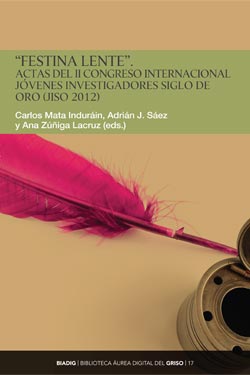
Carlos Mata Induráin, Adrián J. Sáez and Ana Zúñiga Lacruz (eds.), "Festina lente". conference proceedings del II congress Internacional Jóvenes Investigadores Siglo de Oro (JISO 2012), Pamplona, Publishing Services of the University of Navarra, 2013. ISBN: 978-84-8081-385-3 [Library Services Áurea Digital, BIADIG, 17].
This Issue gathers a total of 41 papers that were presented at the II International congress "Jóvenes Investigadores Siglo de Oro" (JISO 2012) which, organized by the group de research Siglo de Oro (GRISO) of the University of Navarra, took place on August 2 and 3, 2012.
If the conference proceedings of the first congress, JISO 2011, were presented under the label Scripta manent, to show the desire for permanence in writing of the research presented orally, the current ones come out under Festina lente ("Hurry slowly"). The motto of this Issue is an oxymoron that Suetonius(Parallel Lives) attributes to Augustus and that may well be valid as committee for every young man researcher: 'work calmly so that the result will be good', or, in another sense, 'take advantage of your initiative and your spirits but, be careful, do not hurry too much'. We believe that there are few better slogans than this one when it comes to describing the work of young scholars, some of whom are starting - some more than others - their careers in the world of academia. Finally, it is worth remembering that "Festina lente" was also the motto of Aldo Manuzio, whose trademark was an intertwined anchor and dolphin.
Several of the contributions focus on the dramaturgy of the Golden Age; and, thus, one can find here reflections on the figure of the gracioso, the reflection of the valido in Tirso de Molina's plays or the variety of conversational discursive markers in Lopesque plays. But, given the multidisciplinarity of this meeting, one can also enjoy reading programs of study which analyses, for example, the influence of Italian architecture on the Peninsula or which sheds light on the development of mercantile calculation in the fifteenth century.
|
Table of contents |
Page |
Download |
|
"presentation", Carlos Mata Induráin, Adrián J. Sáez and Ana Zúñiga Lacruz |
7 |
|
|
Daniel BALDELLOU MONCLUS |
11 |
|
|
Lavinia BARONE |
23 |
|
|
Benedetta BELLONI |
35 |
|
|
Juan Manuel CARMONA |
47 |
|
|
Jéssica CASTRO RIVAS |
65 |
|
|
Juan CEREZO SOLER |
79 |
|
|
Alessandra CERIBELLI |
95 |
|
|
Alazne CIARRA TEJADA |
105 |
|
|
Joseba Andoni CUÑADO LANDA |
119 |
|
|
Marion DARESSY |
131 |
|
|
Blandine DÍEZ GARCÍA |
143 |
|
|
Rosa DURÁ CELMA |
155 |
|
|
Rodrigo FAÚNDEZ CARREÑO |
165 |
|
|
María FERNÁNDEZ FERREIRO |
177 |
|
|
Javier GARCÍA ALBERO |
193 |
|
|
Carlos GONZÁLEZ REYES |
205 |
|
|
Amparo IZQUIERDO DOMINGO |
217 |
|
|
Rebeca LÁZARO NISO |
229 |
|
|
Jacobo LLAMAS MARTÍNEZ |
241 |
|
|
Alejandro LOEZA |
253 |
|
|
Rafael MASSANET RODRÍGUEZ |
263 |
|
|
Sabyasachi MISHRA |
275 |
|
|
Itziar MOLINA SANGÜESA |
289 |
|
|
María MOYA GARCÍA |
303 |
|
|
Elena NICOLÁS CANTABELLA |
315 |
|
|
Álvaro PASCUAL CHENEL |
327 |
|
|
María Francisca PASCUAL FERNÁNDEZ |
363 |
|
|
Marta PILAT ZUZANKIEWICZ |
377 |
|
|
Manuel PIQUERAS FLORES |
389 |
|
|
Jessica ROADE RIVEIRO |
403 |
|
|
Adrián J. SÁEZ |
415 |
|
|
Isabel SAINZ BARIÁIN |
431 |
|
|
Blanca SANTOS DE LA MORENA |
441 |
|
|
Diego SOLA |
449 |
|
|
Guillermo SORIANO SANCHA |
461 |
|
|
Paloma VARGAS MONTES |
473 |
|
|
María VÁZQUEZ MELIO |
481 |
|
|
Adam WICKBERG MÅNSSON |
493 |
|
|
Wiebke WIRTZ |
503 |
|
|
Laura ZORRILLA ORTIZ DE URBINA |
517 |
|
|
Ana ZÚÑIGA LACRUZ |
529 |
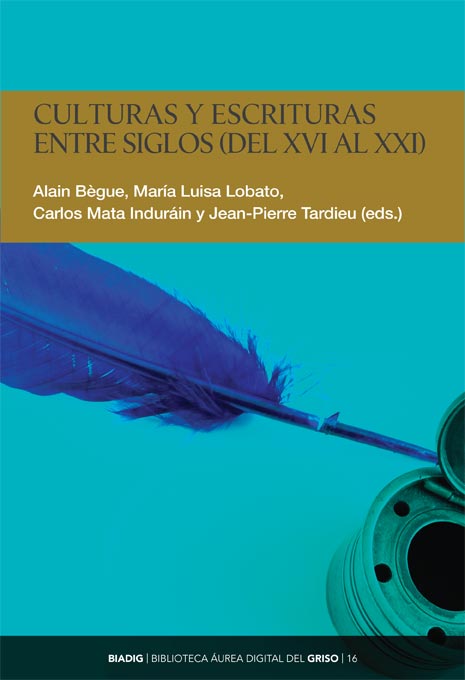
Alain Bègue, María Luisa Lobato, Carlos Mata Induráin and Jean-Pierre Tardieu (eds.), Culturas y escrituras entre siglos (del XVI al XXI), Pamplona, Publishing Services of the University of Navarra, 2013. ISBN: 978-84-8081-384-6 [Library Services Áurea Digital, BIADIG, 16].
This book gathers eleven papers that were read at the International congress "Culturas y escrituras entre siglos (del XVI al XXI): Epochs of Transition", organised by the UFR Lettres et Sciences Humaines of the Université de La Réunion, the Centre de programs of study de la Littérature espagnole de Entre Centuries (XVII-XVIII Centuries) [CELES XVII-XVIII] of the Université de Poitiers, the group PROTEO of the Universidad de Burgos and the group de research Siglo de Oro (GRISO) of the Universidad de Navarra, which was held in Saint-Denis (France), Université de La Réunion, on 22 and 23 September 2011.
B The meeting, of a markedly interdisciplinary nature, also had an international projection, with the participation of specialists from Spain, France, Portugal and Italy. The lectures dealt from different perspectives with literary production - and artistic production in general - at the turn of the century, with particular attention to Spanish Golden Age theatre during the periods of transition.
Both the celebration of the congress (the meeting in La Réunion) and the publication of the results of that meeting are activities that are part of the project "Patrimonio teatral clásico español. Texts and instruments of research (TC/12)", which has the sponsorship of the CONSOLIDER-INGENIO Programme of the National Plan of research and development+i (CSD2009-00033) of the Ministry of Economics and Competitiveness of the Spanish Government.
|
Table of contents |
Page |
Download |
|
"presentation" |
5 |
|
|
Amélie ADDE |
7 |
|
|
María Rosa ÁLVAREZ SELLERS |
19 |
|
|
Ignacio ARELLANO |
31 |
|
|
Alain BÈGUE |
45 |
|
|
J. Enrique DUARTE |
121 |
|
|
Lia GIACHERO |
135 |
|
|
Emma HERRÁN ALONSO |
147 |
|
|
María Luisa LOBATO |
199 |
|
|
Maria Cristina OSSWALD |
231 |
|
|
Jean-Pierre TARDIEU |
257 |
|
|
M.ª Gabriela TORRES OLLETA |
275 |
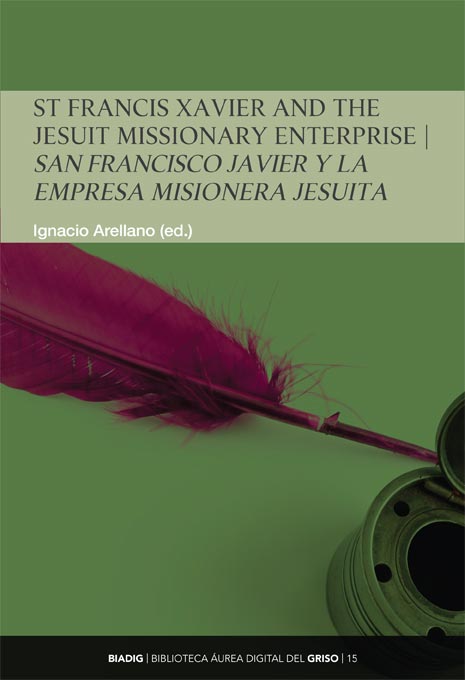
Ignacio Arellano and Carlos Mata Induráin (eds.), St Francis Xavier and the Jesuit Missionary Enterprise. Assimilations between Cultures / San Francisco Javier y la business misionera jesuita. Assimilations between Cultures, Pamplona, Publishing Services of the University of Navarra, 2012. ISBN: 978-84-8081-338-9 [Library Services Áurea Digital, BIADIG, 15
sponsorship In 2011, with the support of the Government of Navarre, the group de research Siglo de Oro (GRISO) of the University of Navarre organised the congress International Conference on Jesuit culture "San Francisco Javier, navarro universal, y la business misional jesuita. Elements, Conflicts and Assimilations of two cultural worlds" / International Conference on Jesuit culture "Saint Francis Xavier from Navarre to the world: the Jesuit mission. Elements, Conflicts and Assimilations of two Cultures". The meeting took place on 1-3 December 2011, coinciding with the feast of the Saint patron saint of Navarre. We are sincerely grateful for the support of the Government of Navarra, which made possible the celebration of this congress, as well as the partnership of the project "Patrimonio teatral clásico español. Texts and instruments of research (TC/12)", sponsored by the CONSOLIDERINGENIO Programme of the National Plan of research and development+I (CSD2009-00033) of the Ministry of Science and Innovation of the Spanish Government.
This Issue gathers some twenty of the papers presented at that congress, written in Spanish and English. All of them deal with contributions on St. Francis Xavier and his time or on Jesuit culture in general. As a whole, we offer the reader a wide-ranging Issue which we hope will constitute a valuable contribution to a better knowledge of the figure of St. Francis Xavier and the immense bequest that Jesuit culture has left in India and throughout the world over the centuries.
|
Table of contents |
Page |
Download |
|
Index |
|
|
|
presentation |
5 |
|
|
Presentation |
7 |
|
|
Savio ABREU |
9 |
|
|
Amélie ADDE |
23 |
|
|
Beatriz de ALBA-KOCH |
33 |
|
|
Ignacio ARELLANO |
47 |
|
|
María-Dolores GARCÍA-BORRÓN |
57 |
|
|
Mariano ITURBE |
71 |
|
|
Jose KALAPURA |
91 |
|
|
Hilaire KALLENDORF |
113 |
|
|
Carlos MATA INDURÁIN |
125 |
|
|
Sabyasachi MISHRA |
145 |
|
|
Indrani MUKHERJEE |
155 |
|
|
Lalita NAMJOSHI |
169 |
|
|
Cristina OSSWALD & Daniela CARVALHO WILKS |
179 |
|
|
Lygia RODRIGUES VIANNA PERES |
195 |
|
|
Raman P. SINHA |
221 |
|
|
Pavel ŠTĚPÁNEK |
251 |
|
|
Maneesha TANEJA |
267 |
|
|
Carmen TEJERA PINILLA |
277 |
|
|
Ira VANGIPURAPU |
295 |
|
|
Vijaya VENKATARAMAN |
305 |
Carlos Mata Induráin, Lygia Rodrigues Vianna Peres and Rosa María Sánchez-Cascado Nogales (eds.), Lope de Vega desde el Brasil. En el cuarto centenario del "Arte nuevo" (1609-2009), Pamplona, Publishing Services of the University of Navarra, 2012.
ISBN: 978-84-8081-337-2 [Library Services Áurea Digital, BIADIG, 14].
Anonymous, El Alcides de la Mancha y famoso don Quijote, ed. by Carlos Mata Induráin and Adrián J. Sáez, preliminary study by Antonio Barnés Vázquez, Pamplona, Publishing Services of the University of Navarra, 2012.
ISBN: 978-84-8081-263-4 [Library Services Áurea Digital, BIADIG, 13].
Claudia Demattè and Alberto del Río, Parodia de la subject caballeresca y teatro áureo. Edition of "Las aventuras de Grecia" and its serious model , Montalbán's "Don Florisel de Niquea", Pamplona, Publishing Services of the University of Navarra, 2012.
ISBN: 978-84-8081336-5 [Library Services Áurea Digital, BIADIG, 12].
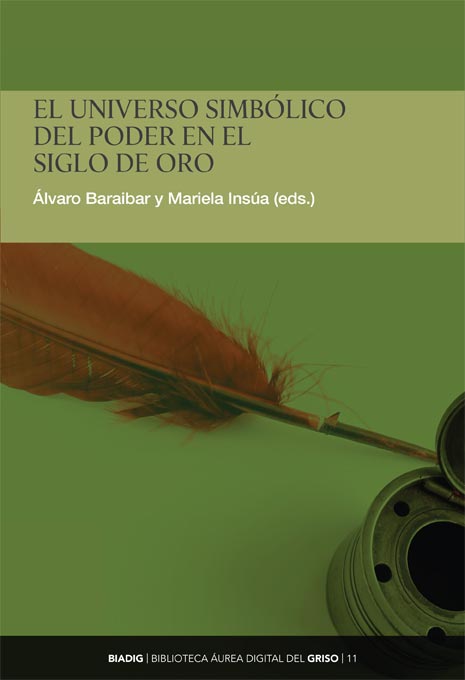 Álvaro Baraibar and Mariela Insúa (eds.), The symbolic universe of power in the Golden Age, New York/Pamplona, Institute of programs of study Aurisecular (IDEA)/Publishing Services of the University of Navarra, 2012.
Álvaro Baraibar and Mariela Insúa (eds.), The symbolic universe of power in the Golden Age, New York/Pamplona, Institute of programs of study Aurisecular (IDEA)/Publishing Services of the University of Navarra, 2012.
ISBN (IDEA): 978-938795-86-2. ISBN (Publishing Services University of Navarra): 978-84-8081-320-4 [Library Services Áurea Digital, BIADIG, 11].
El universo simbólico del poder en el Siglo de Oro (The Symbolic Universe of Power in the Golden Age) offers twenty-two works that approach the subject from different disciplines and critical perspectives. We find programs of study ranging from the representation of the auctoritas/potestas binomial in Christian allegorisation to the representation of the figure of the queen in the aurisecular theatre, as well as different approaches centred on the dramatic genre - the symbolism of the tree in Tirso de Molina, the representation of Philip IV in Calderón, the mechanisms of persuasion in the comedy of saints, the symbolic image of the globe in Lope de Vega and the different faces of power in the comedy of saints, the auto sacramental, the comedies of Moors and Christians or the theatre of evangelisation in New Spain. Alongside the aforementioned Tirso de Molina and Calderón, other leading authors of the Golden Age are also represented: in fact, other works deal with the treatment of power in the works of Jorge de Montemayor, Cervantes, Suárez Figueroa, Quevedo, Cubillo de Aragón and Mira de Amescua. It also includes other topics addressed from historiographical, artistic and literary perspectives, such as the confrontation between economic power and divine authority in the case of the Portuguese bankers, the representation of Philip IV's authority through art, the legitimising value of sermons and hieroglyphs in funeral rites, political propaganda in representations of the image of the sovereign, and clothing as a symbol of power.
We therefore offer this book for the consideration of the reader in the hope that he or she will find in it new ways of approaching the always suggestive and inexhaustible symbolic universe of power in the Golden Age.
|
Table of contents |
Page |
Download |
|
Table of contents/presentation |
|
|
|
Horacio Acevedo |
9 |
|
|
Isabelle Bouchiba-Fochesato |
25 |
|
|
Jéssica Castro Rivas |
35 |
|
|
Shai Cohen |
51 |
|
|
Nitzaira Delgado García |
65 |
|
|
Blandine Díez García |
77 |
|
|
Rosa Durá Celma |
87 |
|
|
Lola Esteva de Llobet |
99 |
|
|
Jorge Gómez Gómez |
113 |
|
|
Rebeca Lázaro Niso |
127 |
|
|
Denise León Pérez |
143 |
|
|
Emmanuel Marignó |
159 |
|
|
Álvaro Pascual Chenel |
175 |
|
|
Tomasa Pastrana Santamarta |
205 |
|
|
Eva Rodríguez García |
219 |
|
|
Davinia Rodríguez Ortega |
241 |
|
|
Medardo G. Rosario Rivera |
257 |
|
|
Adrián J. Sáez |
267 |
|
|
Paloma Vargas Montes |
283 |
|
|
Juan Manuel Villanueva Fernández |
293 |
|
|
Miraida Grisel Villegas Gerena |
315 |
|
|
Ana Zúñiga Lacruz |
331 |
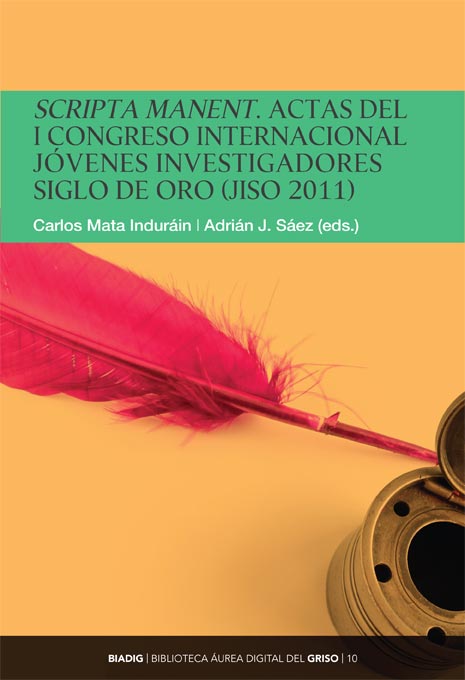
Carlos Mata Induráin and Adrián J. Sáez (eds.), "Scripta manent". conference proceedings del I congress Internacional Jóvenes Investigadores Siglo de Oro (JISO 2011), Pamplona, Publishing Services of the University of Navarra, 2012.
ISBN: 978-84-8081-262-7 [Library Services Áurea Digital, BIADIG, 10].
This Issue gathers a total of 34 papers that were presented at the I International congress "Jóvenes Investigadores Siglo de Oro" (JISO 2011), organized by the group de research Siglo de Oro (GRISO) and held on August 3, 2011 at the University of Navarra.
The contributions analyse very diverse aspects of various subjects (art, literature, history and society, science and religiosity...), always in the context of the Baroque period or its echoes and later influences. The aim of this publication is therefore to offer a state of the question, as partial as it may be, of the paths along which new generations of researchers interested in the rich golden universe are moving.
|
Table of contents |
Page |
Download |
|
"presentation", Carlos Mata Induráin and Adrián J. Sáez |
3 |
|
|
Daniel Baldellou Monclús |
11 |
|
|
Blanca Ballester Morell |
23 |
|
|
Benedetta Belloni |
35 |
|
|
Mikel Berraondo |
47 |
|
|
Ana Cabrero Aramburo |
61 |
|
|
Juan Manuel Carmona Tierno |
71 |
|
|
Alfredo Chamorro |
81 |
|
|
Marta Cobo Esteve |
105 |
|
|
Shai Cohen |
115 |
|
|
Noemí Cubas Martín |
127 |
|
|
Joseba Andoni Cuñado Landa |
139 |
|
|
Reyes Duro Rivas |
157 |
|
|
Francisco Estévez |
173 |
|
|
María Fernández Ferreiro |
185 |
|
|
Enrique Galdeano Aguirre |
195 |
|
|
Manuel Galofaro |
209 |
|
|
Germán Gamero Igea |
223 |
|
|
Gastón Gilabert |
235 |
|
|
Isabel Hernando Morata |
241 |
|
|
Alejandro Loeza |
255 |
|
|
Carlos Lozano Ruiz |
267 |
|
|
Armine Manukyan |
279 |
|
|
Sabyasachi Mishra |
297 |
|
|
Elena Nicolás Cantabella |
307 |
|
|
María Francisca Pascual Fernández |
319 |
|
|
Marta Pilat Zuzankiewicz |
337 |
|
|
Adrián J. Sáez |
365 |
|
|
Isabel Sainz |
381 |
|
|
Verónica Salazar Baena |
393 |
|
|
Nazaret Solís Mendoza |
413 |
|
|
Sven Sroka |
423 |
|
|
Leonor M. Taiano Campoverde |
437 |
|
|
Ana Zúñiga Lacruz |
449 |
Lavinia Barone, La figura del gracioso nel teatro di Pedro Calderón de la Barca, Pamplona, Publishing Services of the University of Navarra, 2012.
ISBN: 978-84-8081-294-8 [Library Services Áurea Digital, BIADIG, 9].
Diego Calleja, El Fénix de España, San Francisco de Borja, ed. by Ignacio Arellano, Pamplona, Publishing Services of the University of Navarra, 2012.
ISBN: 978-84-8081-264-1 [Library Services Áurea Digital, BIADIG, 8].
Valentín de Céspedes, Las glorias del mejor siglo, ed. by Ignacio Arellano, Pamplona, Publishing Services of the University of Navarra, 2011.
ISBN: 978-84-8081-261-0 [Library Services Áurea Digital, BIADIG, 7].

Vibha Maurya and Mariela Insúa (eds.), conference proceedings del I congress Ibero-Asiatico de Hispanistas Siglo de Oro e Hispanismo general, Pamplona, Publishing Services of the University of Navarra, 2011. ISBN: 84-8081-216-8 [Library Services Áurea Digital, BIADIG, 6].
The digital version that the reader has before his or her eyes corresponds to a series of papers presented at the I Ibero-Asian congress of Hispanistas Siglo de Oro e Hispanismo general, held at the University of Delhi (Delhi, India) on 9-12 November 2010, co-organised by the University of Delhi, the group de research Siglo de Oro (GRISO) of the University of Navarra and the high school Spanish y Leonés de la language. The conference proceedings is published with the clear intention of disseminating the contributions of the hundred or so scholars and researchers from some 25 countries who came to the Indian capital to take part in this unique meeting, so far the only one of its kind to be held in India. Table of contents
|
|
Page |
Download |
|
Index |
7 |
|
|
presentation |
13 |
|
|
Beatriz de Alba-Koch |
17 |
|
|
Julio Alonso Asenjo |
33 |
|
|
Hala Abdel Salm Awaad |
45 |
|
|
Tapsir Ba |
55 |
|
|
Mauh-Tsun Chang / David Chau-Pu Pei |
63 |
|
|
Wen-Yuan Chang |
73 |
|
|
Sara Choe |
87 |
|
|
Maria Augusta da Costa Vieira |
101 |
|
|
Dominique de Courcelles |
113 |
|
|
Ángel Delgado-Gómez |
129 |
|
|
Hugues Didier |
147 |
|
|
Teresa Ferrer Valls |
159 |
|
|
Elena Gallego Andrada |
177 |
|
|
María-Dolores García-Borrón |
191 |
|
|
José Manuel García Iglesias |
207 |
|
|
Inmaculada García Presas |
237 |
|
|
Gerardo Gómez Michel |
267 |
|
|
Rafael González Cañal |
279 |
|
|
Gloria Maité Hernández |
295 |
|
|
Isabel Hernando Morata |
307 |
|
|
Alka Jaspal |
315 |
|
|
Hyejeong Jeong |
327 |
|
|
Tomás Jiménez Juliá |
343 |
|
|
Minji Kang |
357 |
|
|
Dimita Ketan Mehta |
371 |
|
|
Noorin Khan |
381 |
|
|
María Cristina Lagreca de Olio |
393 |
|
|
María del Rosario Martínez Navarro |
405 |
|
|
Vibha Maurya |
417 |
|
|
Délio Mendonça |
429 |
|
|
Sabyasachi Mishra |
439 |
|
|
Indrani Mukherjee |
449 |
|
|
Eunchung Noh |
457 |
|
|
Aparna Nori |
471 |
|
|
Joan Oleza |
481 |
|
|
Cristina Osswald |
501 |
|
|
Preeti Pant |
513 |
|
|
Marta Pérez Rodríguez |
529 |
|
|
Javier Raposo Martínez |
541 |
|
|
Robin Ann Rice |
563 |
|
|
Lygia Rodrigues Vianna Peres |
579 |
|
|
Francisco Sáez Raposo |
607 |
|
|
Dimpi Sharma |
621 |
|
|
Surendra Singh Negi |
631 |
|
|
Meenakshi Sundriyal |
641 |
|
|
Ira Vangipurapu |
651 |
|
|
Vijaya Venkataraman |
659 |
Arellano, Judith Farré and Edith Mendoza, Una lectura en imágenes de "El gran teatro del mundo" de Calderón: los diseños de Remedios Varo, Pamplona, Publishing Services de la Universidad de Navarra, 2011.
ISBN: 84-8081-075-0 [Library Services Áurea Digital, BIADIG, 5].
Anonymous, San Javier Grande en el Hito, ed. by Mariela Insúa and Carlos Mata Induráin, Pamplona, Publishing Services of the University of Navarra, 2010.
ISBN: 84-8081-209-5 [Library Services Áurea Digital, BIADIG, 4].
Anonymous, colloquium de la conquista espiritual del Japón hecha por San Francisco Javier, ed. by Celsa Carmen García Valdés, Pamplona, Publishing Services of the University of Navarra, 2010.
ISBN: 84-8081-071-8 [Library Services Áurea Digital, BIADIG, 3].
J. Enrique Duarte, Blanca Oteiza Pérez, Juan Manuel Escudero and Álvaro Baraibar, bibliography primaria general del teatro de Bances Candamo, Pamplona, Publishing Services de la Universidad de Navarra, 2010.
ISBN: 84-8081-070-XX Biblioteca Áurea Digital, BIADIG, 2].
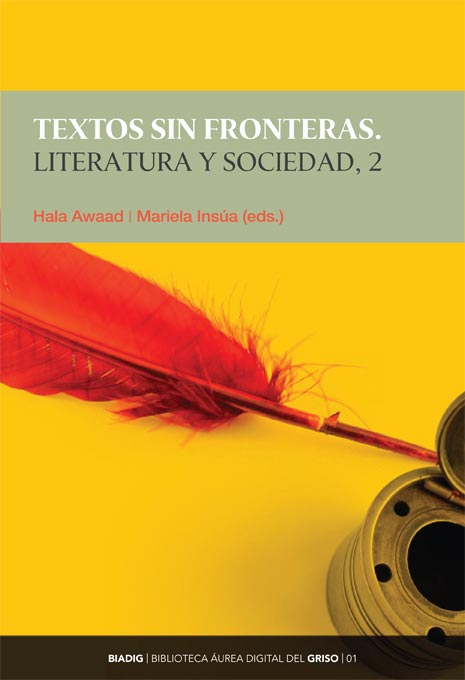
Hala Awaad and Mariela Insúa (eds.), Textos sin fronteras. Literatura y sociedad, 2, Pamplona, Publishing Services of the University of Navarra, 2010.
ISBN: 84-8081-072-6 [Library Services Áurea Digital, BIADIG, 1].
The articles gathered in the present Issue have their origin in the congress International of Hispanic culture. Literature and society IV, organized by the group of research Siglo de Oro (GRISO) in partnership with the School of Al-Alsun of the University of Ain Shams (Egypt) which took place in Cairo on April 6 and 7, 2010. Literature and Society, 2, which is offered to the reader in digital format, consists of fifteen works that address from different perspectives and methodologies the close links between literary and linguistic manifestations and various aspects of the social sphere, in a diachronic view that goes from the Golden Age to the present day. We trust that this second submission, which includes mainly works by Egyptian and Spanish researchers, will provide suggestive views on the subject, and we also trust that this series of "Literature and Society" will soon continue to bear new fruit.
|
Table of contents |
Page |
Download |
|
Previous pages (front cover) |
|
|
|
Index |
7 |
|
|
grade preliminary |
9 |
|
|
Noha Abdel Mageed Ismail |
11 |
|
|
Rehab Abdel Salam |
25 |
|
|
Yomna Azmy Gamal |
41 |
|
|
Mohamed El Saghir Ahmed Temsah |
49 |
|
|
Magda Ibrahim Aly Haroun |
67 |
|
|
Mariela Insúa |
83 |
|
|
Gihane Mahmoud |
103 |
|
|
Salwa Mahmoud |
117 |
|
|
Carlos Mata Induráin |
133 |
|
|
Vibha Maurya |
153 |
|
|
Cristina Osswald |
165 |
|
|
Felipe B. Pedraza Jiménez |
179 |
|
|
Mona Salah Eldin Shalan |
201 |
|
|
Carola Sbriziolo |
215 |
|
|
Vijaya Venkataraman |
229 |

